
EC 11-1-115 • 30 September 2022
UNCLASSIFIED
Department of the Army
U.S. Army Corps of Engineers
Washington, DC
CEMP-IP
*Engineer Circular 11-1-115
Effective 30 September 2022
EXPIRES 30 SEPTEMBER 2024
Army Programs
MILITARY PROGRAM ANNUAL EXECUTION GUIDANCE
Purpose. This circular provides the Military Programs yearly execution guidance that is
necessary to deliver premier engineering and construction, real estate, installation
readiness, and environmental management products and services. United States Army
Corps of Engineers (USACE) is committed to serving the Army, Air Force, Department
of Defense (DoD), and other U.S. Government agencies and foreign governments as
assigned by delivering the program. Military Programs will incorporate new and on-
going requirements associated with energy, climate and environment change,
sustainability, life-cycle investments, and expeditionary Combatant Command support.
Applicability. This Circular applies to all USACE elements under the Military Program
Business Processes and Practices.
Distribution Statement. Approved for public release; distribution is unlimited.
Proponent and exception authority. USACE’s Chief of Program Integration Division
of Military Programs is the proponent of this policy notice. The proponent has the
authority to approve all exceptions to this policy notice consistent with the Director of
Military Programs approval.
FOR THE COMMANDER:
CHRISTINE T. ALTENDORF, PhD, P.E.
Director of Military Programs

EC 11-1-115 • 30 September 2022 2
UNCLASSIFIED
CONTENTS
Paragraph Page
1. Purpose 2
2. Applicability 2
3. Distribution Statement 3
4. References 3
5. Records Management (Recordkeeping) Requirements 3
6. Responsibilities 3
7. Policy 3
8. General Guidance 4
9. Military Programs Mission Line Procedure and Processes 7
10. Environmental Division (ENV) 7
11. Installation Readiness Division (IRD) 19
12. Interagency and International Services (IIS) 25
13. Military Construction 53
14. Real Estate. 74
15. Supporting Offices 90
16. Acquisition, Procurement and Contracting (Contracting Office) 90
17. Legal Services (Council Office) 92
18. Intelligence (G2 Office) 94
19. Communication (Public Affairs Office) 95
20. Research and Development (Research and Development Office) 100
21. Workload and Workforce (Resource Management) 101
22. Safety and Occupation Health (Safety Office) 104
23. Small Business (Small Business Office) 106
24. References 108
1. Purpose. A Circular that provides execution guidance to ensure that its
implementation is conducted in accordance with the Military Programs Business
Process Enterprise Program Management Plan. Military Programs is responsible for
executing a variety of programs and initiatives that involve a wide spectrum of products
and services. In executing these programs, Military Programs will continue to provide
premier engineering and construction, real estate, installation readiness, and
environmental management products and services. United State Army Corps of
Engineers (USACE) is committed to serving the Army, Air Force, Department of
Defense (DOD), and other U.S. Government agencies and foreign governments as
assigned by delivering the program. Also, Military Programs will incorporate new and
on-going requirements associated with energy, climate and environment change,
sustainability, life-cycle investments, and expeditionary Combatant Command support.
2. Applicability. This Circular applies to all USACE elements under the Military Program
Business Processes and Practices.
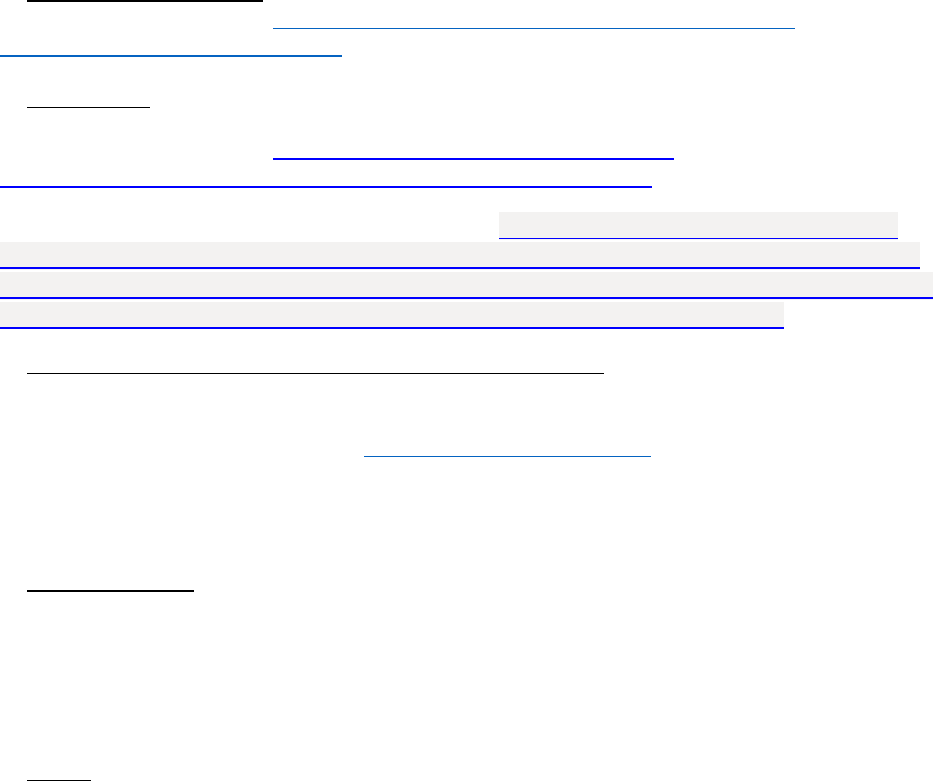
EC 11-1-115 • 30 September 2022 3
UNCLASSIFIED
3. Distribution Statement. Approved for public release; distribution is unlimited. This
document is published at https://www.publications.usase.army.mil/USACE-
Publications/Engineer-Circulars/
4. References.
a. DPM MP 2020-06 , https://team.usace.army.mil/sites/HQ-
MP/MOI/DPM20/Shared%20Documents/Forms/AllItems.aspx
b. Director’s Policy Notice (DPN) PN 5-1-2, https://usace.dps.mil/sites/PUBS-HQ-
RESTRICTED/Policy%20Notice/Forms/Pubs%20Display.aspx?id=%2Fsites%2FPUBS
%2DHQ%2DRESTRICTED%2FPolicy%20Notice%2FPN%205%2D1%2D2%2Epdf&par
ent=%2Fsites%2FPUBS%2DHQ%2DRESTRICTED%2FPolicy%20Notice
5. Records Management (Recordkeeping) Requirements. The records management
requirement for all members, associated forms, and reports required by this guidance
are addressed in the Army (RRS-A). Detailed information for all related record numbers
is in the ARIMS/RRS-A located at https://www.arims.army.mil. If any record numbers,
forms, and reports are not current, addressed, and/or published correctly in
ARIMS/RRS-A, see Department of the Army (DA) Pamphlet 25-403. Guide to
Recordkeeping in the Army.
6. Responsibilities. USACE Military Programs Program Integration Division,
Performance Management and Data Analytics Branch is required to construct the
Military Programs Execution Annual Guidance memorandum. This memo is created
through the consolidation of Military Construction Business Process, Enterprise
Program Management Plans, and performance objectives from the Military Programs
Mission Lines and Supporting Military Mission Offices.
7. Policy. The Directorate of Military Programs establishes and maintains the Military
Construction Business Process, Enterprise Program Management Plans, and
performance objectives for programs and implements enterprise level programs and
initiatives through the Regional Business Centers (RBC) and Centers; and develops
achievable timelines. RBCs and Centers collaborate with stakeholders, support
commands, industry, and other elements of USACE to deliver innovative, state of the art
solutions in the execution of program requirements. USACE establishes priorities with
our stakeholders. RBCs and Centers execute assigned projects and programs in
collaboration with Geographic Districts (GD) through Project Delivery Teams (PDTs)
composed of expertise from across the enterprise. This is executed by aligning
performance metrics, strategic change metrics and functional strategic plans.
Organizational performance is assessed throughout the year at Command Management
Reviews (CMRs), Directorate Management Reviews (DMRs), and RBC Program
Reviews.
EC 11-1-115 • 30 September 2022 4
UNCLASSIFIED
8. General Guidance.
Military Programs has guidance documents that are updated annually. The guidance
documents are as follows: 1) USACE Command Guidance (UCG) Military Programs –
Resource and Metrics; 2) Minimum Data Elements Document; 3) End of Fiscal Year
Guidance; 4) Military Construction (MILCON) Forecast of Basic Lock-in Awards and
Monthly Data Requirements Guidance; and 5) Stakeholders Satisfaction Survey. These
guidance documents provide performance measurements, resources and labor
projections, program guidelines, instructional information, and requirements that were
developed to assists the Major Subordinate Commands (MSCs) in managing their daily
operation.
8.1. USACE Command Guidance Military Programs – Resource and Metrics.
A package consisting of documents that summarizes the USACE’s strategic direction,
resource guidance, and performance requirements for the upcoming fiscal year and out
years. The documents report at the major command-level for which it outlines USACE
resources, procedures, and measures to monitor mission execution. The documents
are structured into chapters containing the following information:
• Chapter 1: Corps Strategic Vision and the command-wide corporate strategic
focus areas for mission resourcing and execution.
• Chapter 2: Resource Projections and Supporting Program Guidance and
Guidelines for the MSCs and for the Corps for reference.
• Chapter 3: Performance Execution targets and Directorate Management
Review (DMR) metrics.
• Chapter 4: Compliance Key Performance Indicators (cKPIs)
The entire package is updated annually but is a “living document” that can be changed
at any time. The major update is requested in March for a May publication. Resource
Management (RM) is the owner of this package and Military Programs (MP) is a
proponent that updates the package to be published by the scheduled date. Military
Programs is responsible for updating those elements of Chapter 2 (Resources) and
Chapter 3 (Performance Metrics) for specific application to Military Programs.
UCG Chapter 2 – Resource Projections and Supporting Program Standards, Guidance,
and Guidelines for the MSCs and the Corps for Reference: Provides a three projection
of workload dollars and/or labor requirements for the various Military Program
programs; program supporting documents reporting Campaign Plan objectives (MP
Installation Readiness); implementation of the Engineer Inspector General (EIG)
inspection recommendations and Corrective Actions Plans (CAPs) for USACE Value
Program (MP Value Engineering); sustainability for energy and water measures
(Sustainability); Military Programs standard definitions; a National Account Manager
(NAM) listing (NAM Roster). The documents are located on the EC FY2023 – 2025

EC 11-1-115 • 30 September 2022 5
UNCLASSIFIED
SharePoint site https://team.usace.army.mil/sites/HQ-MP/PDT/ECFY2325/default.aspx
under “UCG.”
UCG Chapter 3 – Performance Execution targets and Directorate Management Review
(DMR) metrics: Provides the program performance measures for the Military Programs
MILCON, Environmental, Installation Readiness and Value Engineering programs.
These metrics measures and rates the MSC’s program/project performance and are
used as the source of for reporting during the Military Programs quarterly DMR. The
document is located on the EC FY2023 – 2025 SharePoint site
https://team.usace.army.mil/sites/HQ-MP/PDT/ECFY2325/default.aspx under “UCG.”
8.2. Minimum Data Elements Document.
Guidance developed to establish data consistency and reliability within Military
Programs. This guidance was generated to set policy and provide direction for
improving data integrity, data quality, and data standardization across all mission areas
(MILCON, Installation Readiness, Environmental, Interagency International Service, and
Real Estate) within each MSC and its Districts. The implementation of this policy will
provide a reliance on enterprise data in accordance with the USACE Data Governance
guidance to deliver the Military Mission program and eliminate data calls. All data
requirements governed by Headquarters Department of Army (HQDA) or Office
Secretary of Defense (OSD) (i.e., Real Estate) will follow the external data governance
forums. Policy is located on the Military Programs Business Intelligence website at
https://reports.usace.army.mil and click on “Policy” to the left.
8.3. End of Fiscal Year Guidance.
Guidance developed in the Performance Management Data Analytics Branch to
regulate end of year for Military Programs and the MSCs.
The guidance was put in place because the Military Programs Integration Division (PID)
is responsible for capturing the yearly project execution data. The document is located
on the EC FY2023 – 2025 SharePoint site https://team.usace.army.mil/sites/HQ-
MP/PDT/ECFY2325/default.aspx under “EoY Document.”
8.4. Military Construction Forecast of Basic Lock-in Award and Monthly Data
Requirement Guidance.
A memorandum that provides the MSCs Basic Lock-in guidance for the next fiscal
year’s as it pertains to the MILCON Program (i.e., FYXX President’s Budget for
MILCON projects and carryover from PFY), proponent- specific guidance for
solicitations, and monthly data requirements to track on-going MILCON execution.
Also, this guidance provides the Continuing Resolution Authority instructions. The
memo is composed in CEMP-IP annually in July for a final release in August. The
document is located on the EC FY2023 – 2025 SharePoint site
https://team.usace.army.mil/sites/HQ-MP/PDT/ECFY2325/default.aspx under “Forecast
Lock-in.”

EC 11-1-115 • 30 September 2022 6
UNCLASSIFIED
8.5. Stakeholder Satisfaction Survey.
The Military Programs Stakeholder Satisfaction Survey is a survey managed and
maintained by the Policy and Strategy Branch that is conducted annually. It is a unique
corporate tool that identifies systemic issues affecting stakeholders across USACE’s
Military Programs portfolio and the quality of USACE’s service. Also, it provides an
opportunity for engaging with the stakeholders and obtaining useful feedback.
Execution and Process
• The CEMP Survey Team provides guidance for the execution of the annual
Military Programs Stakeholder Satisfaction Survey to the District Survey
Managers identified by each participating District. Instructions are provided
regarding establishing an account and administering the survey using the survey
tool on MAX.gov; how the web-based survey works; the useful administrative
features that allow managers to generate summary reports throughout the survey
process; how to customize the survey for Districts; and how the Survey
Participants Lists should be compiled. The CEMP Survey Team will assist in the
process.
• Each District must identify at least one individual to act as their District Survey
Manager(s). Note: Notify CEMP-IS if there are changes in the designations as
soon as possible so that the roster of District Survey Managers may be updated
accordingly. District Survey Managers must submit their final Survey Participants
Lists by 3
rd
week in September. The list from the previous year will be used as
the baseline for each District to update/validate. If a District did not participate in
the previous year, then a new list will be developed. Note: Instructions will be
provided to assist the District Survey Managers.
• MSCs will be provided with the Survey Participants Lists for each District in their
region and will be asked to verify the accuracy and completeness of each
District’s List.
• Invitations to participate in the survey will be distributed to the designated
participants via the MAX.gov platform. The target is to begin launching District
surveys by the first week of November with a requested return date
approximately three (3) weeks after the survey is activated. District Survey
Managers have the option to draft their own email to their respective survey
participants. Reminder emails may be sent by the District Survey Managers to
their respective survey participants at any time during the response period, and
there is no limit on the number of reminder emails which can be sent. The target
is to complete all surveys by the 3
rd
week of December. District Survey
Managers can request extensions for their surveys, if necessary. Please email
any questions or comments about the stakeholder survey to
• Point of Contact (POC) for the Stakeholder Satisfaction Survey is Caitlin Slattery
at (202) 761-0443 and [email protected].

EC 11-1-115 • 30 September 2022 7
UNCLASSIFIED
9. Military Programs Mission Line Procedure and Processes.
Military Programs have five distinguish mission lines whom individual mission is unique
in fortifying the health of the organization. The five mission lines are as follows:
Environmental; Installation Readiness; Interagency and International Services;
MILCON; and Real Estate. These mission lines are recognized for their ability to
acquire land and important leases; for which the land is cleaned from environmental
toxins; to allow the building of needed facilities that are maintained and equipped with
the necessary support and tools; along with establishing vital partnership with other
agencies internationally or domestic. Although each mission lines have a unique
program and function, their operations intertwine to create on purpose. To aids and
supports to MSCs in delivering the program for the warfighters.
10. Environmental Division.
The Environmental Division (ENV DIV) mission is to provide global environmental
services, including environmental quality (compliance, conservation, pollution
prevention, and planning), sustainability, and military munitions and hazardous, toxic,
and radioactive waste (HTRW) cleanup actions, for a wide range of DoD and other
federal agencies.
10.1. Points of Contact.
The ENV DIV POCs listed in each paragraph are subject to change. Please visit the
Headquarters (HQ) Intranet Environmental Division SharePoint site for the most up-to-
date names, titles, and contact information for the appropriate environmental program
execution or support activity. The HQ Intranet Environmental Division SharePoint site:
https://usace.dps.mil/sites/INTRA-HQ/SitePages/Environmental.aspx
10.2. Program Execution.
USACE major subordinate commands (MSCs) and districts shall ensure their
organizations execute the following environmental programs in accordance with (IAW)
each program’s program management plan (PgMP), requirements presented in this
document, engineering regulations and manuals and other applicable laws, regulations,
and requirements. The PgMP can be found at the HQ Intranet Environmental Division
SharePoint site, given in paragraph 10.1, or provided by the program’s Environmental
POC(s).
Provided at the HQ Intranet Environmental SharePoint site is a complete listing of
current ENV DIV programs by national-level stakeholders (NLSs) and national program
managers (NPMs); ENV DIV programmatic capabilities by NLS and manager; and the
ENV DIV organizational chart. In addition to the program-specific requirements listed at
the HQ Intranet Environmental Division SharePoint site, ENV POCs at the MSCs are
expected to do the following activities for all ENV programs:
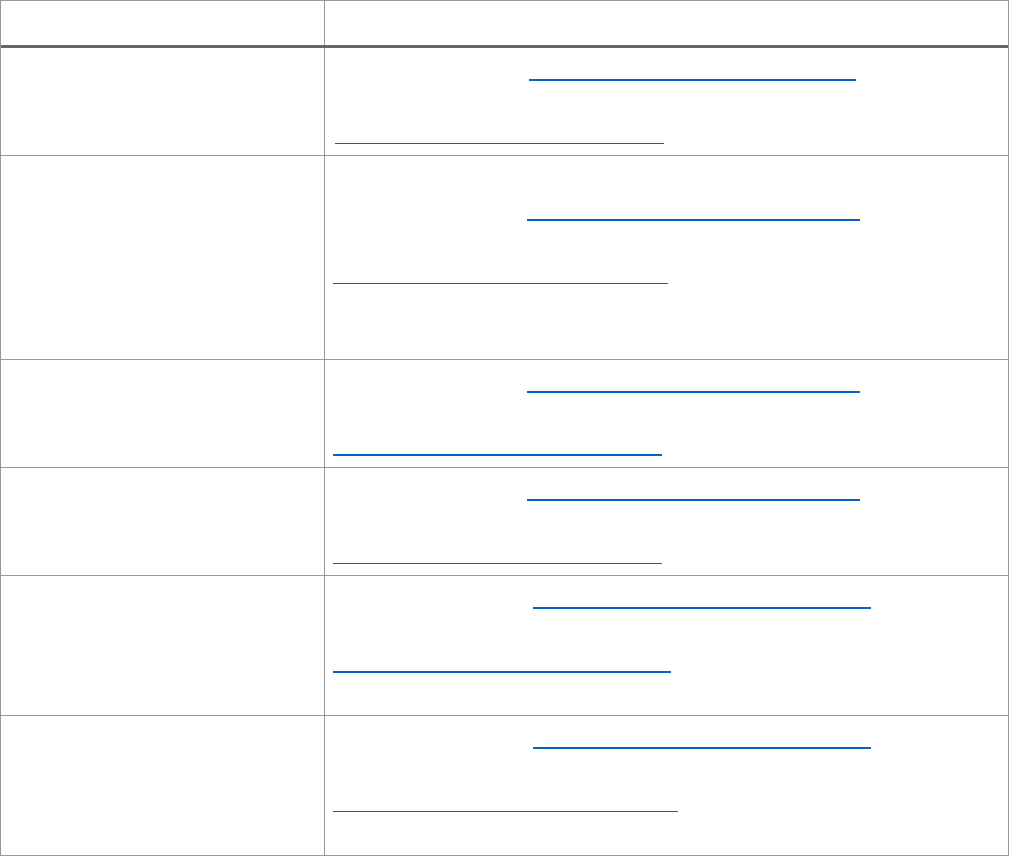
EC 11-1-115 • 30 September 2022 8
UNCLASSIFIED
• Assist and regularly communicate with ENV NPMs in managing programs from a
regional perspective.
• Assist NPMs in developing and adhering to support agreements, PgMPs, and
other program and project documents (e.g., decision documents).
• Engage with regional stakeholders, districts, and ENV NPMs to plan and execute
work and resolve issues.
• Assist HQ in developing and adhering to policies (e.g., work acceptance, area of
responsibility (AOR) coordination, technical guidance, etc.).
• Assist in responding to formal and informal / internal and external taskers.
Participate in regional governance and strategic initiatives.
Below are the programs and Environmental POCs as of the date of this publication.
Program
Environmental Points of Contact
Air Force (AF) Base
Realignment and Closure
(BRAC)
Ms. Sherry Rone, [email protected] is the AF-
BRAC NPM and Mr. Lucas Walsh,
[email protected] is the AF-BRAC Deputy NPM.
Air Force (AF) Defense
Environmental
Restoration Programs
(DERP) and
Environmental Quality
(EQ)
Ms. Sherry Rone, [email protected], is the AF
DERP/EQ NPM and Mr. Lucas Walsh,
[email protected], is the AF DERP/EQ Deputy
NPM.
Air Force Reserves (AFR)
EQ
Ms. Sherry Rone, [email protected], is the AFR-
EQ NPM and Mr. Lucas Walsh,
[email protected], is the AFR-EQ Deputy NPM.
Air National Guard (ANG)
EQ
Ms. Sherry Rone, [email protected], is the ANG-
EQ NPM, and Mr. Lucas Walsh,
[email protected], is the ANG-EQ Deputy NPM.
Army Base Realignment
and Closure –
Environmental
Restoration (BRAC-ER)
Mr. James Moore, [email protected], is the
Army BRAC-ER NPM, and Mr. George Bock,
[email protected], is the Army BRAC-ER
Deputy NPM.
Army DERP and
Compliance Cleanup (CC)
Program
Mr. James Moore, [email protected], is the
Army DERP/CC NPM, and Mr. George Bock,
[email protected], is the Army DERP/CC
Deputy NPM.
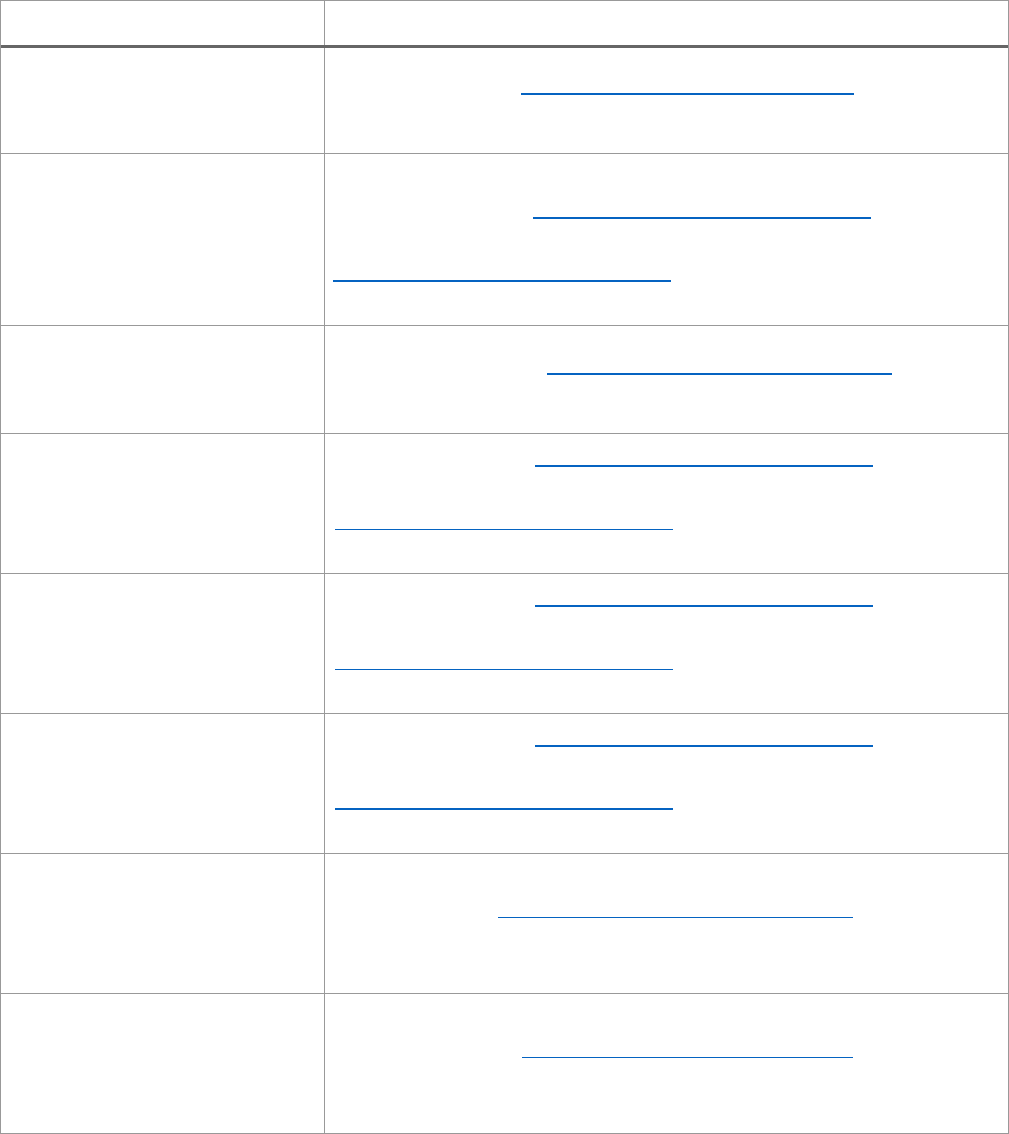
EC 11-1-115 • 30 September 2022 9
UNCLASSIFIED
Program
Environmental Points of Contact
Army Deactivated Nuclear
Power Plant Program
(DNPPP)
Mr. Brian Hearty, [email protected], is the
DNPPP NPM.
Army Environmental
Quality (EQ) Program –
Compliance,
Conservation, & Pollution
Prevention
Mr. James Moore, [email protected], is the
Army EQ NPM, and Mr. George Bock,
[email protected], is the Army EQ Deputy NPM.
Army Regional
Environmental and
Energy and Office (REEO)
Ms. Anisha Downs, [email protected], is the
REEO NPM.
Other Army
Environmental
Mr. James Moore, [email protected], is the
Other Army ENV NPM, and Mr. George Bock,
[email protected], is the Other Army ENV
Deputy NPM.
Army National Guard
Facilities (ARNG) ENV
Programs VENQ and
ENVR
Mr. James Moore, [email protected], is the
ARNG ENV NPM, and Mr. George Bock,
[email protected], is the ARNG ENV Deputy
NPM.
Army Reserves (USAR)
ENV Programs VENQ and
ENVR
Mr. James Moore, [email protected], is the
USAR ENV NPM, and Mr. George Bock,
[email protected], is the USAR ENV Deputy
NPM.
Office of the Secretary of
Defense (OSD) –
Cooperative Ecosystem
Studies Unit (CESU).
Ms. Kim Bond, [email protected], is the ENV
DIV CESU POC.
OSD – Defense State
Memorandum of
Agreement (DSMOA)
Program.
Mr. Brian Shedd, [email protected], is the
DSMOA NPM.
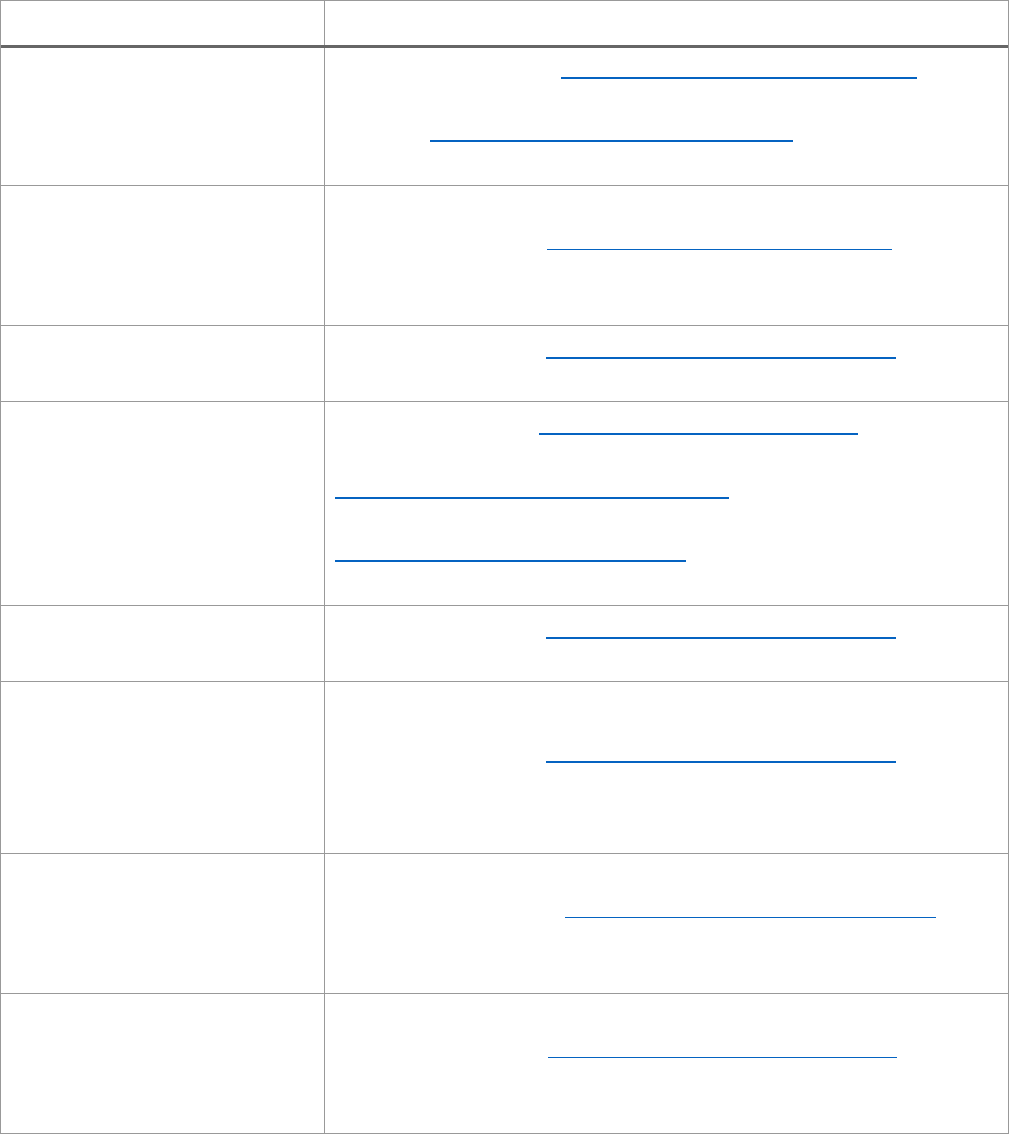
EC 11-1-115 • 30 September 2022 10
UNCLASSIFIED
Program
Environmental Points of Contact
OSD – Formerly Used
Defense Site (FUDS)
Program
Ms. Vanessa Hinkle, [email protected], is the
FUDS NPM and the overall POC for FUDS, and Mr. Chip
Whitton, [email protected], is the FUDS
Deputy NPM.
OSD – Native American
Lands Environmental
Mitigation Program
(NALEMP)
Ms. Anisha Downs, [email protected], is the
NALEMP NPM.
USACE Environmental
Support Team (EnvST)
Ms. Arlene Weiner, [email protected], is the
EnvST NPM/POC.
USACE Formerly Utilized
Site Remedial Action
Program (FUSRAP)
Ms. Nicki Fatherly, [email protected], is the
FUSRAP NPM, Ms. Ivanna Goldsberry,
[email protected], is the FUSRAP Deputy
NPM and Ms. Natalie Watson,
[email protected], is the FUSRAP National
Account Manager.
Other DoD ENV Support.
Ms. Arlene Weiner, [email protected], is the
Other DoD ENV work NPM.
Other DoD Military
Munitions Support
Services / International
Contingency Operations
(ICO).
Ms. Arlene Weiner, [email protected], is the
ENV NPM for ICO environmental and munitions work.
U.S. Environmental
Protection Agency (EPA)
Superfund (SF) Program
requirements.
Mr. Glen Shonkwiler, [email protected], is
the Superfund NPM.
International and
Interagency Support –
Environmental (IIS-E)
requirements.
Ms. Arlene Weiner, [email protected], is the
IIS-E NPM.

EC 11-1-115 • 30 September 2022 11
UNCLASSIFIED
Program
Environmental Points of Contact
DOE (other than FUSRAP)
Requirements.
Mr. John Daley, [email protected], is the DOE
NPM and Ms. Arlene Weiner,
[email protected], is POC for all non-FUSRAP
DOE environmental work.
10.3. Support Activities.
MSCs/districts will conduct the following activities in support of the ENV DIV, the
Environmental Community of Practice (ECOP), and ENV programs under the purview of
the CEMP-CE. ENV POCs at the MSCs will follow the specific guidance below to:
• Participate in knowledge management, sharing successes and lessons learned,
maintaining, and disseminating program information.
• Encourage awards submissions.
• Participate in the Environmental Contract Acquisition Working Group (CAWG).
• Continuously improve data quality, assist HQ in developing metrics and
improving regional performance.
• Participate in ENV DIV governance meetings.
• Contribute to the ENV Portfolio Oversight (EPO) budget execution and
development processes.
• Complete workload projections, workload/workforce (WL/WF) assessments, and
acquisition planning and reporting.
• Complete Regional Environmental Acquisition and Management Plan (REAMP)
templates.
• Process / facilitate the requirements validation process, also referred to as
Command Service Executive (CSE) requests.
• Ensure that MILCON and Per- and Polyfluoroalkyl Substances (PFAS)
requirements are followed.
• Participate in and support HQ strategic and ECOP initiatives.
• Contribute to Public Affairs products (e.g., articles, photos, etc.).
10.3.1. Annual Awards Processes Participation.
MSCs/districts are encouraged to participate in the annual USACE Sustainability and
Environmental Awards and the Secretary of the Army (SECARMY) Environmental
Awards. MSCs/districts are also encouraged to participate in other awards and to share
various award winner information with the ENV DIV Public Affairs Officer (PAO) and
ENV DIV Awards POC.

EC 11-1-115 • 30 September 2022 12
UNCLASSIFIED
The USACE Sustainability and Environmental Awards open period is generally from
early February to late April. The SECARMY Environmental Awards open period is from
approximately early August through late October.
Additional award information may be found at: https://aec.army.mil/index.php/awards.
The ENV DIV POC for the annual awards process is Ms. Cathy Forgét,
[email protected]. The ENV DIV PAO is Ms. Jenn Miller,
10.3.2. Environmental Contract Acquisition Working Group.
MSCs/districts will participate in the Environmental CAWG by providing active
membership as nominated by the MSCs and selected to serve by the Chief, ENV DIV.
The ENV DIV will conduct three (3) quarterly Environmental CAWG meetings via web
meeting/teleconference and one (1) multi-day, hybrid web/in-person meeting. These
meetings will take place in approximately November, February, April, and August, with
the in-person meeting typically in April.
The current Environmental CAWG member matrix and charter are on the Environmental
CAWG SharePoint site.
The Environmental CAWG SharePoint site: https://usace.dps.mil/sites/INTRA-
HQ/SitePages/CAWG.aspx. The ENV DIV Environmental CAWG POC Ms. Cathy
Forgét, [email protected].
10.3.3. Data Quality.
Documentation and data must be consistent and correct across USACE Automated
Information Systems (AISs), including Project Management Automated Information System
(P2) and CEFMS II for all ENV programs, including the use of Environmental Command
Indicator Codes (CICs), Management Decision Package (MDEP), Army Management
Structure Code (AMSCO), and other key distinguishing information.
MSCs/districts will update documentation and data in AIS data fields as changes are
announced, and MSCs/districts will ensure that new and/or mandatory data
requirements are appropriately followed. MSCs/districts will work with HQUSACE to
address data quality and management issues, follow the guidance in the Military
Programs (MPs) and ENV Data policies, and correct data errors (also see the
paragraph on the USACE Command Guidance (UCG) Metrics, 10.3.15).
Current ENV Data Elements presentation and files are posted on the ENV Programs
Data Quality SharePoint site.

EC 11-1-115 • 30 September 2022 13
UNCLASSIFIED
The Environmental Data Quality SharePoint site: https://usace.dps.mil/sites/INTRA-
HQ/SitePages/Environmental-Data-Quality.aspx. Ms. Ashley Elder,
[email protected], is the ENV DIV POC for ENV Programs Data Quality.
10.3.4. Environmental Division Governance Meetings.
ENV DIV Management Reviews (EDMRs). EDMRs serve as preparation for the MP
Director’s Management Review (DMR), After Action Review (AAR) and, CMR meetings.
EDMRs will be scheduled for approximately fifteen (15) business days after the end of
the quarter. Briefings will follow the templates provided by the ENV DIV Review Meeting
POC and will be due typically four (4) days before the EDMR.
• NPMs will brief at the October and April EDMRs.
• MSCs will brief at the January and July EDMRs.
Bimonthly ENV Programs teleconferences.
• The ENV DIV will schedule informal teleconferences for the second Wednesday
of every other month (unless it conflicts with an EDMR).
• MSCs will submit agenda topics to the ENV DIV Review Meeting POC no later
than (NLT) one week in advance of each meeting.
Ms. Ashley Elder, [email protected], is the ENV DIV Review meetings
POC.
10.3.5. Current Fiscal Year Environmental Portfolio Oversight Budget Execution.
MSCs will execute labor and non-labor portions of the current fiscal year EPO budget to
ensure each stakeholder pays their fair share of the EPO budget as established by the
ENV DIV and the EPO funding model.
The ENV DIV provides an MSC Budget Summary sheet to ensure fiscal compliance
within the EPO funding model.
The MSCs will use the MSC Budget Summary sheet provided by the ENV DIV EPO
Budget Execution POC to execute funding appropriately and obligate funding by the
end of the fiscal year (FY).
MSCs will send current fiscal year EPO Budget Execution reports (labor and non-labor)
to the ENV DIV EPO Budget Execution POC NLT the fifth (5
th
) business day after the
end of each quarter. The ENV DIV EPO Budget Execution POC will provide a template
to the MSCs.
EPO Budget Quarterly Obligation Targets for labor/non-labor (actual
obligations/planned budget) are as follows, by quarter:
• 1Q – 28 percent.

EC 11-1-115 • 30 September 2022 14
UNCLASSIFIED
• 2Q – 55 percent.
• 3Q – 80 percent.
• 4Q – 100 percent.
MSCs will assist HQ in the management of the EPO Revolving Account (EPORA) to
ensure that district/center allocations are paid with the appropriate funds and to review
any reallocations. Once finalized, the ENV DIV will publish the annual fiscal year
guidance and posted it to the EPORA SharePoint site.
The EPORA SharePoint site: https://usace.dps.mil/sites/INTRA-
HQ/SitePages/EPORA.aspx. The ENV DIV POC for the Current Fiscal Year EPO
Budget Execution is Ms. Barbara Church, [email protected]. The ENV
DIV POC for the EPORA is Ms. Tannesia Rolley, ta[email protected].
10.3.6. Future Fiscal Year Environmental Portfolio Oversight Budget
Development.
MSCs will assist the ENV DIV in developing the future EPO Budget. The future fiscal
year will be developed using the above future fiscal year plus five workload projections.
Listed below are the tasks and timeframes in which MSCs will be expected to engage.
Due No Later
Than (NLT)
Action
31 January
Provide feedback on the MSC Full Time Equivalent (FTE) Distribution
Table.
28 February
Provide budget requirements (template to be provided).
31 March
Provide feedback on MSC budget summary.
31 May
Provide feedback on EPORA allocations.
15 August
Coordinate EPORA allocations with local stakeholders.
The ENV DIV POC for the Future Fiscal EPO Budget Development is Ms. Barbara
Church, [email protected].
10.3.7. Military Interdepartmental Purchase Requests.
HQ financial POCs on Military Interdepartmental Purchase Requests (MIPRS) are as
follows: Ms. Joanna Tolentino, [email protected], on incoming MIPRs
and Ms. Kimberly Baudy-Patterson, [email protected], on
outgoing MIPRs.
The correct address for ENV DIV MIPRs is:
HQUSACE (CEMP-CE),
441 G St NW,

EC 11-1-115 • 30 September 2022 15
UNCLASSIFIED
Washington, DC 20314.
The ENV DIV Program Analysts are Ms. Barbara Church,
[email protected]; and Ms. Rosa Rodriguez,
10.3.8. Future Plus Five Fiscal Year Workload Projections.
MSCs and NPMs will work together within the timeline below to come to agreement on
future fiscal year district/center-level plus five-year projected annual obligations. These
projections will feed other reporting requirements, including the REAMP, EDMR/DMR,
Integrated Command Resource Information (ICRI), USACE Command Guidance
(UCG), EPO Budget, and the End of Fiscal Year Report.
Listed below are the tasks and timeframes in which MSCs and NPMs will be expected
to engage.
Due NLT
Action
31 October
MSCs will provide district/center projections to the ENV DIV Workload
Projection POC using the template provided on the EPORA SharePoint
site.
15 December
NPMs will review and coordinate with MSCs/districts/centers to finalize
projections and provide to the ENV DIV Workload Projection POC.
Periodically
MSCs and NPMs will be asked to provide feedback on a web-based
workload projection tool to be developed.
The EPORA SharePoint site: https://usace.dps.mil/sites/INTRA-
HQ/SitePages/EPORA.aspx. The ENV DIV POC for the Workload Projections is Ms.
Ashley Elder, [email protected].
10.3.9. Workload / Workforce Assessment.
MSCs/districts will develop their ENV Workload / Workforce (WL/WF) Assessment for
the current fiscal year plus two in accordance with OPORD 2013-26. and submit the
analysis to ENV DIV through the REAMP. MSCs will use the Directorate of Human
Resources (CEHR) templates in their REAMPs (please refer to paragraph 10.3.10) for
their WL/WF Assessment section.
The CEHR will provide specific WL/WF Assessment guidance and templates on the
team’s SharePoint site. This site will be linked on the REAMP SharePoint site once
available.

EC 11-1-115 • 30 September 2022 16
UNCLASSIFIED
The ENV DIV WL/WF Assessment information is located within the REAMP SharePoint
site: https://usace.dps.mil/sites/INTRA-HQ/SitePages/REAMP.aspx. The ENV DIV
WL/WF Assessment POC is Ms. Ashley Elder, [email protected].
10.3.10. Regional Environmental Acquisition and Management Plan.
Regional Environmental Acquisition and Management Plan (REAMPs) include
organizational information divided into three main elements:
• Workload History and Projections.
• Workforce Evaluations.
• MSC/District Acquisition Strategy.
Summaries of how the three main elements combine will lead to successful stakeholder
program execution. Each MSC is expected to follow the ENV DIV-provided templates
without changing what is given. Modifying the provided template hinders the analysis
process and decreases data completeness and accuracy thus lowering data reliability.
ENV DIV will post the REAMP template to the REAMP SharePoint site by the end of
October.
MSCs will post their completed final REAMPs to the REAMP SharePoint site by the
suspense date, which is usually by the first of March. The completed final REAMPs will
have multiple parts to include, but not limited to:
• The Future Plus Five Fiscal Year Workload Projections (IAW para 10.3.8.).
• The WL/WF Assessment (IAW para 10.3.9).
o MSCs will submit the future fiscal year plus two WL/WF Assessment required
information via the CEHR process, as described in para 10.3.9.
o MSC/district WL/WF Assessment data is typically due at the end of January.
MSCs/districts will consider the REAMP throughout execution during the FY. ENV DIV
and the Environmental CAWG (para 10.3.2) will use REAMPs in decision making,
including the review of the requirements validation process, or Command Service
Executive (CSE) requests (para 10.3.11).
The ENV DIV REAMP POC will post the REAMP rollup summary to the REAMP
SharePoint site. The REAMP SharePoint site: https://usace.dps.mil/sites/INTRA-
HQ/SitePages/REAMP.aspx. The ENV DIV REAMP POC is Ms. Ashley Elder,
10.3.11. Requirements Validation Processes, or Command Service Executive
Requests.
MSCs/districts will follow the latest guidance on requirements validation, also referred to
as Command Service Executive (CSE) requests. Current MP and ENV DIV policies and

EC 11-1-115 • 30 September 2022 17
UNCLASSIFIED
process are reflected in the Environmental section of the References.
MSCs/districts will include CSEs anticipated for the current fiscal year in their REAMPs
and out brief those requirements to the Environmental CAWG at the in-person CAWG
meeting.
The ENV DIV CSE information is located within the Environmental CAWG SharePoint
site: https://usace.dps.mil/sites/INTRA-HQ/SitePages/CAWG.aspx. Ms. Ashley Elder,
[email protected], is the ENV CSE POC.
10.3.12. Military Construction and Sustainment, Restoration, and Modernization
Requirements.
Military Munitions Response Program (MMRP) roles and responsibilities are established
in ER 1110-1-8153, “Military Munitions Support Services”, also listed in the
Environmental section of the References paragraph. Prior to execution of a MILCON or
Sustainment, Restoration, and Modernization (SRM) project, MSCs/districts shall
ensure all required HTRW, and military munitions evaluations and coordination address
the potential for unexploded ordnance (UXO) or other ENV issues associated with the
MILCON or SRM site are performed.
MSCs/districts shall ensure that PM districts involve one of the Military Munitions Design
Centers or the Environmental and Munitions Center of Expertise (EMCX) in any
assessment of the property, including preparation of Probability Assessments and other
required documentation, in accordance with Explosives Safety requirements set forth in
EM 385-1-97. The reviews will support completion of checklists in, ER 415-1-11,
“Biddability, Constructability, Operability, Environmental and Sustainability (BCOES)
Reviews.” Review will be performed prior to construction contract award for each
authorized MILCON and SRM project. References are also listed in the Environmental
section of the References paragraph.
The proponent for the MILCON or SRM project shall be responsible for any necessary
MMRP or other ENV responses necessary to allow for construction of the MILCON or
SRM project, which should be included in initial work authorization, or modifications will
be required to address unaccounted issues that arise.
The ENV DIV MMRP POC is Ms. Nicole Toth, [email protected].
10.3.13. Per- and Polyfluoroalkyl Substances.
Each MSC/district Commander will obtain work approval from their aligned directorate
(MP, CW, or Engineer Research and Development Center [ERDC]) prior to accepting or
beginning any Per-and Polyfluoroalkyl Substances (PFAS)-related work, in accordance
with USACE Daily Tasking Order 21-04-26, the Commanding General's policy on PFAS
Work Acceptance Requirements, also listed in the Environmental section of the

EC 11-1-115 • 30 September 2022 18
UNCLASSIFIED
References paragraph. If approved to conduct the proposed work, project delivery
teams (PDTs) in MP and CW will engage the EMCX for review of draft performance
work statements, draft quality assurance project plans, and draft reports for pre-
investigation, investigation, removal, and remedial phases.
The EMCX will ensure technical consistency and the use of up-to-date approaches to
address PFAS. PDTs will provide project funding unless program funding has already
been made available to the EMCX and account for review.
Ms. Nicole Toth, [email protected], is the ENV DIV PFAS POC.
10.3.14. Strategic Communication.
MSCs/districts are encouraged to engage with their local PAO to achieve the following
desired communication outcomes for both internal and external audiences.
Vertical Team Situational Awareness. MSCs/districts will support vertical team
understanding of ENV project challenges and possible adverse media coverage/public
perceptions.
• MSCs/districts will engage local PAOs to ensure situation-specific messaging is
developed and shared via email, phone, and/or briefings with vertical team to
maximize visibility and responsiveness to potential situations.
• Timely communication from MSCs/districts ensures vertical team alignment and
enables the vertical team to identify key leadership engagements, public
engagement opportunities, and develop/implement effective communication
strategies to maximize transparency.
• MSCs/districts will manage internal and external expectations regarding
upcoming changes to ENV projects and inform their local PAOs and the vertical
team as soon as possible of upcoming significant changes and communications
strategy.
Project Successes. MSCs/districts will support increased public understanding of
project successes and engage their local PAOs to develop content for local media
engagements, news articles, social media content, and web updates. MSCs/districts will
share this information vertically for further amplification in enterprise publications (see
below) and for possible utilization in senior leader briefings.
Publications. MSCs/districts will proactively identify opportunities to engage with local,
regional, and/or national media and public through their local PAOs.
• MSCs/districts will report the engagements initiated and the results through
Public Affairs channels to the ENV DIV PAO.
• MSCs/districts will provide environmental articles of interest to the managing
editor of The Corps Environment at Corps-Environment-

EC 11-1-115 • 30 September 2022 19
UNCLASSIFIED
[email protected]. Article submission deadlines for publications are 15
December, 15 March, 15 June, and 15 September.
External Webpages. MSCs/districts will ensure all project webpages that provide
information to the public are housed on an official "army.mil" site. If current project
webpages are not, MSCs/districts need to migrate the content onto the appropriate
platform, which is hosted by the Web Enterprise Business Program.
• No contract should authorize the creation of a public webpage on any platform
other than the Web Enterprise Business Platform or Corporate Information Office
(CIO) servers without consultation with CIO and PAO.
• All users are required to take the USACE External Operation Presence training
before posting information to a public facing website. The POCs for these actions
USACE ENV News Clips. MSCs/Districts can access daily ENV news clips on the
Environmental COP SharePoint site: https://usace.dps.mil/sites/KMP-
the ENV DIV Strategic Communications POC.
10.3.15. USACE Command Guidance Metrics.
MSCs/districts will meet the requirements associated with the ENV Programs MP
metrics: 01, and 12-15. Target goals are displayed on the ENV DIV Data Quality
SharePoint site: https://usace.dps.mil/sites/INTRA-HQ/SitePages/Environmental-Data-
Quality.aspx
The annual UCG metrics are published to the HQ Intranet SharePoint:
https://usace.dps.mil/sites/INTRA-HQ/SitePages/CG.aspx.
The ENV DIV UCG POC is Ms. Ashley Elder, [email protected].
11. Installation Readiness Division.
The Installation Readiness Division mission is to provide engineering solutions for
America’s installations and the Nation by expanding the technical expertise of the
installation community and applying USACE technical and contract capabilities to plan,
operate, maintain, restore, and modernize our military infrastructure. The IRD vision is
to support the military strategic readiness and other federal stakeholders by providing
technical leadership, expertise, and infrastructure related engineering that deliver
modern, secure, sustainable, resilient installations. The mission consists of the
following:
• Facilities Engineering
• Master Planning
• Sustainment, Restoration, and Modernization (SRM)
EC 11-1-115 • 30 September 2022 20
UNCLASSIFIED
• Energy Management
• Facilities Planning and Programming
• Engineering Capability Integration
• Mission Assurance
• Power Reliability Enhancement Program (PREP)
Execution
• IRD provides enterprise oversight, technical assistance, and expertise on
reimbursable programs in support of public works organizations throughout DoD.
• The USACE Installation Readiness Division Programs include the range of
services defined in AR 420-1: Chapter 2-27 thru 2-31, Section V, U.S. Army
Corps of Engineers Installation Support Services; Chapter 10, Military Installation
Master Planning; Chapter 22, Army Energy and Water Management Program;
Chapters 23, Utility Services; Chapter 24, Acquisition and Sales of Utility
Services; and comparable guidance from other supported services and DoD
Agencies. The USACE IRD Program supports these five (5) Mission lines:
o Technical Expertise in Support of the Execution of Military
Construction and Real Estate, including Installation Master Planning,
Program Administration and Execution (PAX) System, and Mission
Assurance/Defense Critical Infrastructure (MA/DCI).
o Army Level Identification, Definition, and Validation (I-D-V) of
Infrastructure and Facility Requirements against current and
future requirements to meet the needs of the Army's Mission
and assist in the development of standards and criteria to
implement military construction.
o National Program Managers (NPMs) for the Sustainment Management
Systems (SMS): SMS suite of facility/asset management tools, which
includes BUILDER, ROOFER, PAVER, RAILER, FUELER, and
UTILITIES; SRM Program; Base Operation Services (BOS) support
Mission Assurance; and the Army Control Systems Program
Development.
o USACE Energy Management Program, Energy Savings Performance
Contracts (ESPCs)/Utility Energy Services Contracts (UESCs), Army
Metering Program (AMP), Commercial Utilities Program (CUP), and
others. This includes support to the Army Office of Energy Initiatives
(OEI).
o Public Works Professional Development, Communications &
Outreach (Public Works Training and DoD Master Planning Institute
(MPI) through the USACE Learning Center (ULC); and the Public
Works Digest).
• IRD focuses on building and sustaining technical expertise of community
members who manage and oversee a number of programs and initiatives
in conjunction with the Assistant Secretary of the Army (Installations,
Energy and Environment) (ASA IE&E), Deputy Chief of Staff G-
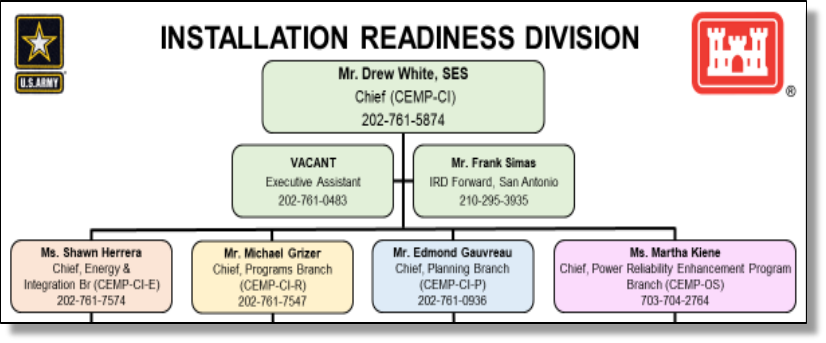
EC 11-1-115 • 30 September 2022 21
UNCLASSIFIED
9(Installations), the Army Materiel Command (AMC), the Installation
Management Command (IMCOM), Army Land Holding Commands, Army
staff, Army Service Component Commands, Direct Report units and other
military organizations.
Roles and Responsibilities
HQUSACE Office and Directorates
• SRM Program:
o Quarterly: Military Programs FY23 SRM Reporting; MSCs and HNC shall
provide quarterly updates on program pre-award execution including status of
funds received and projected award dates. The MSCs, their subordinate
Districts, and HNC shall also review and update project records in P2 and
RMS quarterly to provide IRD post award status updates. The SRM program
is briefed quarterly at the Military Programs Quarterly Directorate
Management Review (DMR).
o Monthly: FY23 Commanding General High Priority Project List Update. Major
Subordinate Commands (MSCs) and Huntsville Center (HNC) with high
priority SRM project(s) identified by the USACE Commanding General shall
review and update project records in P2 and RMS monthly. Installation
Readiness shall provide CG high priority project list update monthly to MSCs
and HNC with identified SRM projects. MSCs and HNC shall provide updates
on these projects at the beginning of each month per the directions provided
by the PID. Additionally, the Army’s Facilities Investment Plan (FIP) status is
briefed monthly to senior leaders from HQDA, AMC, IMCOM, and USACE.
o Biweekly: FY22 IMCOM centrally funded FIP updates. IMCOM issues an
updated list bi-weekly. Other supported services and DoD Agencies provided
less frequent updates. MSCs and HNC shall work with the IRD SRM Program
Managers to track and update the project assignments, project approvals,
and pre-award schedule for projects >$2M. MSCs and HNC are required to
submit the minimum data requirements outlined in DPM 20-05 listed in the
EC 11-1-115 • 30 September 2022 22
UNCLASSIFIED
references. IRD will provide inputs to the biweekly FIP Action Officers (FIP
AO) updates as needed or as requested.
• Job Order Contracting (JOC): IRD will work to secure funding in FY23 to
update the JOC Guide, following final approval of the updated JOC Army
Federal Acquisition Regulation Supplement (AFARS) section. In future
years, following update of the JOC Guide, IRD will develop a JOC
PROSPECT Course and standardized JOC templates.
• Mission Assurance: USACE Mission Assurance provides USACE
enterprise engineering capabilities, expertise, and solutions to reduce risk
to Defense Critical Infrastructure (DCI) across the DoD that support
strategic missions. The IRD Mission Assurance and DCI Program
Manager focuses on how USACE enables the mission assurance of DoD
Components, Agencies, and stakeholders. IRD integrates key USACE
capabilities into Army and Joint Mission Assurance Assessments to
enhance the energy resilience and cybersecurity of Army DCI. Installation
Readiness Division MEF: Provide installation DCI awareness and
reporting on Tier 1 and Tier 2 Task Critical Assets (TCA) and Defense
Critical Assets (DCA) with USACE construction, mitigation, response, and
recovery equities to USACE Senior Leaders, HQDA, and all appropriate
DoD Components including the mission impact of TCAs’ and DCAs’
operational status changes and mitigation measures.
• The Army Control Systems Program Development:
o USACE aligns capabilities to assist in leading and developing the
Army Control Systems Program, to include research and
development, standards and specifications, sustainment, lifecycle and
category management, acquisition, training, cybersecurity, and data
analysis, supported by policy/policy analysis, resource planning, and
program management.
o Through programmatic and technical expertise, USACE integrates
research and development and centers of expertise with stakeholder
control systems requirements, including proof of concept projects.
o Provide cybersecurity and facility engineering expertise, USACE
executes Army Staff (ARSTAF), Land Holding Command, and Asset
Owner critical infrastructure assessments and mitigation planning and
execution.
o Referencing the Army’s Installation Strategy, USACE drives smart
technology development and integration for Army installations,
Reserve, and National Guard centers.
o USACE remains a key stakeholder and leader in Army Senior Leader
Governance Forums addressing critical infrastructure protection and
cybersecurity for Facility-Related, Industrial, and National Critical
Infrastructure Control Systems.
• Joint Program Executive Office Armaments & Ammunition (JPEO
A&A):
o The USACE National Program Manager for initiated program
EC 11-1-115 • 30 September 2022 23
UNCLASSIFIED
execution of the five-year, $2.2B facilities and infrastructure
modernization program. USACE provides professional services
including construction S&A, planning, programming, technical
review, and/or contracting. This program will involve three different
Districts: NAO, NWO, and NWK in two Divisions, NAD and NWD.
SAD has executed a transfer of responsibility to NAD for projects
in this program at Holston AAP (SAD) to NAD
o Districts will execute 7600A Support Agreements, General Terms
& Conditions, at a minimum, for each project offered by JPEO and
accepted by the District. Districts have primary responsibility for
coordination of all USACE activities in their AOR. Center of
Expertise (CSXs) and Mandatory Center of Expertise (MCXs) will
coordinate directly with the District.
o Divisions will provide oversight and support to inter-
District/CSX/MCX efforts and agreements.
• Sustainment Management System (SMS) (BUILDER, PAVER, ROOFER,
RAILER, FUELER, and UTILITIES): Consolidation of legacy SMS
modules is ongoing with initial Enterprise SMS support deployed for fuels
and full transition (BUILDER) targeted for FY 2023. Program funding and
oversight is also being consolidated via interservice memoranda to support
the presidential budget directive, with HQDA G9 to receive and direct SMS
sustainment funding to USACE. OMB policy memo M-20-03 has created
significant interest and potential support for adoption of SMS by additional
Federal agencies
• Virtual Test bed for Installation Management Effectiveness (VTIME): The
VTIME PDT (Construction Engineer Research Laboratory (CERL),
Assistant Chief of Staff for Installation Management (ACSIM), OSD, and
HQUSACE) continues work to support the development of future POM
cycles. CERL continues to work tool requirements to ensure integration of
SMS BUILDER data into Installation Status Report (ISR)
• Combat Readiness Support Team:
o Sustainable Range Modernization (VSRM) and Training Range Operations
(VSCW) MDEP FY23 Spend Plan Submission: Submission from Huntsville
Center Range and Training Land Program adjustments to their original
submitted monthly Obligation Plans for consolidation and coordination with
HQ RM for their submission to Army Budget Office. This adjustment to the
Spend Plan must reflect achieving the 80/20 Obligation target by 31 July for
each Program.
o Support Facility Annexes: Coordinate with CEMP-CI-P, Army Futures
Command and Installation Management Command to complete Support
Facility Annexes (SFAs) per assigned schedule to support Army
Modernization.
• IS Professional of the Year: MSCs/Districts shall submit candidates to leadership
for the Installation Support Professional of the Year in the 2nd and 3rd quarters
of the FY to IRD in accordance with IRD annual guidance and direction

EC 11-1-115 • 30 September 2022 24
UNCLASSIFIED
• Energy – CUP: In collaboration with the Office of the Assistant Secretary of the
Army for Installations, Energy, and Environment and its Office of Energy
Initiatives (OEI), USACE participates in the Army’s 06/GS-15 Utilities
Procurement Working Group that is developing the Army’s Energy Procurement
Optimization Strategy.
• Energy Army Energy and Utility Program Restoration and Modernization (QUTM)
MDEP:
o QUTM MDEP FY23 Spend Plan Funding Letter/Appropriation
Adjustment Submission: Submission from Huntsville Center for the
Army Metering Program under SAG 132 and ESPC, UESC program
and CUP and Demand Response (D/R) Program adjustments under
SAG 131 to their original submitted FY23 monthly Obligation Plans to
be submitted to CEMP-CI-E NLT 15 Jan 2023 for consolidation and
coordination with HQ RM for their submission to Army Budget Office.
This adjustment to the Spend Plan must achieve the 80/20 Obligation
target by 31 July for each of the Programs.
o QUTM MDEP FY24-28 Command Program Objective Memorandum
(POM) Requirements: Submission from Huntsville Center for the AMP,
ESPC, UESC, CUP, and D/R Program, updates to their Total and
Critical funding requirements spreadsheet to CEMP-CI-E NLT 31 July
2023 for consolidation and coordination with DA G9 QUTM Program
Manager and HQUSACE RM POM POCs. This information will be
used to coordinate adjustments to the POM USACE Command
requirements in support of the OACSIM Requirements Build Process
Meetings with the Quarterbacks, Champions and Co-Chairs needs and
questions
• Master Planning: Planning Center Validation Visits will be conducted
virtually at three (3) centers during FY23 – exact dates and locations to be
determined.
• Regional Master Planning Support Centers: Each center will update
current workload, projects, contract capacity, and critical program
information to CEMP-CI-P by the end of each FY quarter (31 Dec, 31
March, 30 June and 30 September). Format will be as specified by
Planning Branch using USACE enterprise project system.
• PAX System: National Program Managers for each stakeholder using
PAX will coordinate funding and system requirements with the PAX
National Program Manager.
• PREP: Provide unparalleled power reliability subject matter expertise to
the Department of Defense’s most critical infrastructure. Establishes utility
design criteria and standards, evaluates facilities and systems
performance, and serves as a focal point to resolve reliability issues and
mitigate risks.
POCs: Planning Branch (CEMP-CI-P) is Mr. Edmond Gauvreau, Branch Chief,
IS, (202) 761-0936, Email: [email protected]; Programs

EC 11-1-115 • 30 September 2022 25
UNCLASSIFIED
Branch (CEMP-CI-I) is Mr. Michael J. Grizer, Branch Chief, IS, (202) 761- 7547,
Email: [email protected]; Energy Programs Integration Branch
(CEMP-CI-EP) is Ms. Shawn Herrera, Branch Chief, IS, 202-761-7574, Email:
[email protected]; Power Reliability Enhancement Program
(PREP) is Ms. Marth Kiene, Branch Chief, IS, (703) 428-6767, Email:
[email protected]; and Chief, Headquarters USACE IRD San
Antonio Office is Mr. Frank Simas, (210) 861-1998, Email:
12. Interagency and International Services.
The Interagency and International Services (IIS) integrates capabilities and expertise
across the enterprise in all mission areas to deliver valued advisory, technical, and
engineering solutions to joint, interagency, intergovernmental, multilateral/multinational,
state and local government, tribal nation, U.S. private sector, international and non-
governmental organizations, and select DoD and DA stakeholders at home and abroad
to achieve national security and/or stakeholder strategic objectives and requested
outcomes.
The Corps’ IIS efforts enable our partners and stakeholders to focus on their primary
mission goals and objectives to achieve the strategic outcomes set forth in the National
Security Strategy and other national strategic documents, build and maintain effective
partnerships at home and abroad, and advance America’s interest and values. The
Corps possesses global vision, reach, and presence and is recognized internationally
for its broad capabilities in sustainable engineering, technical assistance, and scientific
research. USACE pursues interagency and international activities as an integral part of
its mission, achieving the nation’s interests working in partnership with governmental
and non-governmental agencies, community leaders, commercial and academic
partners around the world.
IIS activities are defined as having one or more of the following characteristics: not a
Civil Works/Military Programs statutory or an executive agent responsibility; requires a
Memorandum of Agreement (MOA), General Terms and Conditions (GT&C) agreement,
Memorandum of Understanding (MOU), Letter of Offer and Acceptance (LOA),
Cooperative Research and Development Agreement, or other formal agreement;
supports the achievement of a stakeholder function or objective; does not support the
achievement of a USACE statutory mission or not associated with a federally funded
Civil Works project; does not include Operations and Maintenance (O&M) or MILCON
activities; does not support a FEMA-directed Emergency Support Function #3 mission;
not otherwise assigned to another USACE activity for oversight; and delivered on a
reimbursable basis. IIS directly supports Objective 1a (Support Combatant Commands’
security activities and efforts of other U.S. government agencies around the globe to
advance our Nation’s interests) and Objective 3d (Strengthen Domestic Interagency
Support) of the USACE Campaign Plan.
EC 11-1-115 • 30 September 2022 26
UNCLASSIFIED
IIS serves as a leader in leveraging science, technology, and geospatial applications
and an integrator for applying ERDC, Army Geospatial Center (AGC), Institute of Water
Resources (IWR), and other USACE capabilities to a broad stakeholder base as a
means to deliver effective and adaptable enterprise solutions that achieve Joint
Interagency Intergovernmental Multination JIIM stakeholder desired effects.
Maintenance of an effective Community of Practice (CoP) is critical to enhancing the
exchange of information and improving organizational performance as it relates to
institutionalization and administration/oversight of IIS ethos, delivery methods, career
development (skills, training, education, and experience), processes, and products.
Geographic MSCs are responsible for IIS activities associated with or conducted within
their respective AOR and will work with CEMP-CN as necessary to comply with existing
policies specified IAW References A1-C7. Functional MSCs, Centers, Laboratories,
and Field Operating Activities (FOAs) will coordinate all planned and ongoing activities
with the respective MSC with assigned responsibility for the region in which the activity
will occur.
Interagency and International Services activities occur following the approval and
acceptance of work from stakeholders. Approval authority will be at the MSC
Commander/ HQUSACE Director/ ASA(CW) level as prescribed by ER 1140-1-211
(Reference a1). Management and execution will be performed at the geographic or
functional MSC, Center, Laboratory, or FOA.
Service delivery occurs both internationally and domestically and typically falls in one
the following categories: Major construction, Minor construction, Facility maintenance
and repair, Research and Development (R&D),Science, Technology, and Geospatial
information and engineering applications and services, and Technical services like Real
estate, Program and project management, Planning and design, Technical assistance,
training and advisory support, Master planning, Integrated Water Resource
Management (IWRM), Disaster risk management and resilience, Energy and
environment, and Cost engineering.
The development and implementation of aligned strategic engagement and
communication plans are key to developing new relationships, sustaining, and
enhancing existing relationships, facilitating situational awareness and coordination
among USACE elements within the organization, and optimizing outcomes of
engagement activities. HQUSACE IIS retained oversight of the following:
• IIS provides oversight, as defined in paragraph 2) below, for the following
enterprise partners:
o Department of Veterans Affairs (DVA)
o Customs and Border Protection (CBP)
o Arlington National Cemetery (ANC)
o Millennium Challenge Corporation (MCC)
o Intelligence Community (IC)
o U.S. Department of Agriculture (USDA), Agricultural Research Service (ARS)
o Indian Health Service (IHS)
EC 11-1-115 • 30 September 2022 27
UNCLASSIFIED
o U.S. Department of Health and Human Services (HHS)
o National Aeronautics and Space Administration (NASA)
o United States Maritime Administration (MARAD)
o Support to outside agency’s Inspector Generals (IG)
o North Atlantic Treaty Organization (NATO) Security Investment Program
(NSIP)
• For the programs listed above, HQUSACE IIS oversight includes but is not
limited to:
o Issuing Directives to authorize MSCs to begin all phases of work through the
DIRNET system or through funding memoranda.
o Signing all GT&Cs, MOAs, 7600As, and 7600B Interagency Agreement
forms.
o Providing funds management.
o Developing and maintaining an Enterprise Program Management Plan, and
other programmatic guidance.
o Maintaining up-to-date information on the program, in order to immediately
address programmatic and project-level inquiries posed by senior
representatives from internal and external agencies.
o Facilitating the Senior Executive Review Group (SERG) meetings, setting the
agenda and participant list. Assessing the health of USACE's relationships at
the executive level and the adequacy of USACE services provided.
o Review’s legislative authority and language in NDAA pertaining to programs
o Provides support to combatant commands in program management and
oversight capacities.
o Manages integrated program team meetings across all DoD service
components to resolve programmatic challenges.
• HQUSACE IIS also provides direct management of the following:
o WRDA Section 234
o International Support, Other (XISQ) Army MDEP (Miscellaneous Support to
Other Nations)
o Civil-Military Emergency Preparedness (CMEP)
o Foreign Military Sales (FMS)
o Department of State – Bureau of Oceans and International Environmental and
Scientific Affairs – Office of Conservation and Water (DOS/OES/ECW)
Policy on Security Assistance Funding and Limitations:
• Funding for SA activities requiring a LOA (also called a Case) is resourced
through FMS Admin surcharge and the LOA. FMS Admin surcharge, allocated by
DASA(DE&C), can be applied to activities associated with business sustainment,
training, LOA development, select execution and closure responsibilities, and
travel. SA LOA funding can be applied to activities associated with project
execution. USACE program/project managers are required to report all SA
projects as defined in Section 9.3.1 (USACE SA cases and non-USACE SA
cases) to the Security Assistance Branch Chief.
EC 11-1-115 • 30 September 2022 28
UNCLASSIFIED
• FMS Admin and LOA funding shall not be applied to any activity not pre-
approved by HQ CEMP-CN Security Assistance Branch Chief as part of the
budget/POM submission. LOA funding shall not be applied to any activity outside
the scope of the LOA. MSC/District/Field Office requests for clarification
regarding the application of FMS Admin or LOA funding should be sent to the HQ
USACE SA Branch Deputy Program Manager via the MSC.
Application of Value Engineering (VE) to SA Activities: VE is not required on FMS
projects which are host nation funded projects. VE is a requirement on Foreign Military
Financing (FMF) projects. USACE VE Policy is to be followed.
Roles and Responsibilities:
Headquarters USACE Directorate of Military Missions, Interagency and International
Services Division (CEMP-CN), Interagency and International Services Branch
• Lead the development, coordination, dissemination, refinement, and
implementation oversight of IIS strategy, policy, guidance, processes, tools,
authorities, and resources to enable effective delivery of IIS services across the
enterprise.
• Serve as the Champion and lead for Objectives 1a and 3d of the USACE
Campaign Plan (UCP) and work ICW CEMP Program Integration Division
(CEMP-PID) and the Strategy and Integration Office (SIO) to carry out the
required UCP duties and tasks including the development, coordination, and
implementation of Objective 1a and 3d strategy, actions, milestones and decision
points, and performance measures.
• Engage with SIO IIS representative on performance of strategic, trend, and
enterprise relationship analysis and evaluation. Develop recommendations to
senior leadership on future direction and requirements, potential opportunities
and challenges, and resource, capability, competency, and R&D/S&T
implications.
• Serve as the Headquarters proponent for assigned Geographic and Functional
Combatant Command (CCMD) and Army Service Component Command (ASCC)
liaison officers (LNOs). Work by, with, and through the MSCs to provide strategic
direction, policy, and guidance to the LNOs based on enterprise and JIIM
objectives, establish professional development requirements, and integrate the
LNOs into the IIS CoP.
• In coordination with DCO/G3, develop a new LNO in-processing standard
operating procedure (SOP) for functional and geographic Combatant Commands
(CCMD)/ Army Service Component Commands (ASCC) LNOs. Schedule and
participate in all new LNO in-processing activities in accordance with the
published SOP.
• In coordination with the protocol officer, CECW, CECO, and the USACE security
office, lead the planning and coordination of IIS-related foreign delegations to
HQUSACE including: visitor clearance coordination; content development based
on delegation requirements and objectives; transition planning for delegation
visits to MSCs or other USACE organizations; follow-up actions; and assurance
EC 11-1-115 • 30 September 2022 29
UNCLASSIFIED
that delegation activities are in compliance with DoD, Army, and interagency
regulations, processes, and procedures and are sensitive to the national
traditions and customs of delegation personnel.
• Coordinate with CECW and CECO monthly to obtain situational awareness of all
planned international delegation visit NLT one month prior to the date of the
event. Ensure preparation and submittal of an EXSUM is completed NLT one
week after completion of the delegation visit including list of attendees, purpose,
outcomes, and action items/next steps for input into Reach Back Engineer Data
Integration system (REDi) and Global Theater Security Cooperation
Management Information System (GTSCMIS).
• In coordination with CECW, manage the annual funding from Section 234 of the
Water Resources Development Act of 1996 (33 U.S.C. 2323a), in accordance
with the Section 234 Policy Memo dated 07 May 13, including coordination,
validation, and prioritization of annual budget requirements, management of
execution, and participation in governance team meetings.
• Conduct bi-annual update briefings to the Assistant Secretary of the Army for
Civil Works (ASA(CW)) on USACE IIS activities and status of international
agreements.
• Conduct programmatic update briefings to Deputy Assistant Secretary of
Defense for Construction and Acting Principal Deputy Assistant Secretary of
Defense for Installations on international programmatic agreements.
• In coordination with ASA(CW), coordinate, staff, and obtain signature for USACE
international agreements. Identify, address, and overcome institutional barriers
to concluding international agreements in a responsive manner to meet
stakeholder requirements.
• Coordinate, lead, assist with, and provide guidance on the development and
maintenance of national level agreements with Continental United States
(CONUS) and Outside of Continental United State (OCONUS) JIIM
stakeholders.
• Maintain a catalog of all USACE agreements and templates on the IIS
SharePoint site.
• Lead the development and implementation of enterprise IIS CCG and Key
Performance Indicator (KPI) performance measures. ICW/CEMP-PID, MSCs,
Functional MSCs, Centers, Laboratories, and FOAs, consolidate and report IIS
activity information and performance measures at the quarterly Military Missions
Directorate Management Review (DMR) and the Command Management Review
(CMR).
• Implement tasks directed to CEMP-CN (IIS) in FRAGO 1 to Operations Order
2013-17, Engineer Common Operating Picture for Army Engineer Support to
CCMDs.
• Engage with Army, OSD, and other DoD and interagency security cooperation
stakeholders on matters pertaining to policy, resourcing, planning, and
implementation.
• Develop and issue Civil-Military Emergency Preparedness (CMEP) policy and
guidance, perform management oversight, and provide financial management
EC 11-1-115 • 30 September 2022 30
UNCLASSIFIED
services to support MSC execution of planned CMEP and other Disaster Risk
Management related international Security Cooperation events. Submit financial
and programmatic reports to the Defense Security Cooperation Agency (DSCA)
Institute for Security Governance (ISG) CMEP Program Manager and the
Assistant Secretary of Defense, Partnership Strategy and Stability Operations, on
a quarterly basis or as requested.
• Schedule and lead the IIS/LNO CoP teleconference at a minimum frequency of
once a month.
• Schedule and lead biannual Combatant Command Focused Updates with the
MSC, LNO and DCG-MIO.
• Coordinate through the HQ a biannual letter for each Combatant or Functional
Commander from the Chief of Engineers as written by the LNO and approved by
the MSC.
• Consolidate and submit IIS input for bi-weekly Military Missions SITREP.
• Coordinate with appropriate HQ Directorates to input all planned and ongoing 3D
OCONUS steady-state activities into REDi and GTSCMIS. Update on a monthly
basis.
• Maintain standard IIS reports and updated IIS P2 PIF, CIC, data dictionary, and
data fields.
• Update and maintain the IIS website and SharePoint site. Ensure relevant IIS
information, including agreement templates and a database of current and
previous agreements, is accessible and current.
• Plan and conduct an annual IIS/LNO workshop.
• Proponent of the Customer Relationship Management CRM 224 PROSPECT
Course.
• Complete the following annual End-of-FY Summary and ICRI Update.
Headquarters USACE Directorate of Military Missions, Interagency and International
Services Division (CEMP-CN), Security Assistance Branch.
• Develop, update, and disseminate Security Assistance (SA) policy, guidance,
processes, procedures, documentation formats, and clarification to questions and
concerns. Maintain all documentation on the USACE SA Community Intranet
site.
• Business Sustainment
o Annually update Security Assistance components for the USACE Military
Missions Operation Order as required.
o Conduct annual Security Assistance Workshop with the USACE SA
Community to review policies, case development, execution, closure, and
FMS Admin/Case funding.
o Coordinate and disseminate USACE SA Senior Leadership Engagements to
the USACE SA Community.
• Pre-Letter of Request (Pre-LOR)
o Contact the Chief of Security Assistance to discuss any new/ developing
Letters of Request (LOR) or LOA and is responsible for assigning LORs to
the appropriate SA Program Manager within the Security Assistance Branch
EC 11-1-115 • 30 September 2022 31
UNCLASSIFIED
and ensuring that all LORs are sent to the appropriate FMS Division/District
Program Manager within 5 days of receipt.
• LOA development Responsibilities
o Track and coordinate Letters of Acceptance case development weekly.
o Use the Defense SA Management System to develop Letters of Acceptance.
o Develop Letters of Acceptance within 45-150 days of receiving the LOR 90%
of the time. Develop remaining 10% within 150 days.
• Execution Responsibilities
o Issue policy and guidance to USACE SA community on execution and
reporting system requirements (e.g., P2 and QLIK Sense).
o Receive from USACE systems and from the USACE SA community monthly
updates on program execution such as pending modifications/amendments,
design phase initiation, construction phase initiation, and closure phase
initiation.
o Conduct monthly meetings with USACE SA Community to review policies,
guidance, execution, closure, and FMS Admin/Case funding.
o Provide updates to support the quarterly Director Military Programs
Management Review (DMR) with highlights of USACE SA Community
milestones and projects to USACE.
o Attend all Washington, D.C.-based SA Financial and Program Management
Reviews as well as the annual CCMD Security Cooperation Management
Reviews. Attend regional security assistance reviews as requested by the
Division/ District/ DSCA/ Customer.
• Closure Responsibilities
o Provide monthly USACE case closure updates to the Deputy Assistant
Secretary of the Army for Defense Exports and Cooperation (DASA (DE&C))
and DSCA.
o Update DSCA’s SCIP/ Army’s Closure Case Closure Process Execution
System (CCOPES) with closure status for cases within 6 months of estimated
closure.
• Training Responsibilities:
o Quarterly review to ensure USACE wide Security Cooperation workforce
remains in compliance with NDAA 2019 Workforce Professionalization
Certificate Program requirements. Including review of Position Description
alignment with SC Workforce.
o Develop and submit annual USACE request for training to DASA-DE&C and
provide quarterly training updates.
o Ensure USACE Security Assistance workforce maintain their Good Standing
with satisfaction of Continuous Learning requirements. Monitor same every
quarter.
• Align USACE policy and guidance with DSCA and DASA-DEC as it is
disseminated to the Security Cooperation and Assistance Enterprise.
• Travel Responsibilities:
o Develop and submit annual USACE travel justification funding request to
DASA (DE&C).
EC 11-1-115 • 30 September 2022 32
UNCLASSIFIED
o Request submission of quarterly travel requirements from MSC/districts.
• FMS Administration Responsibilities
o Develop and disseminate guidance to USACE SA community on use of FMS
Admin funding.
o Develop and provide USACE annual FMS Admin budget and future year
Program Objective Memorandum (POM) submissions, including requests for
Unfunded Requirements (UFRs) to DASA (DE&C) in accordance with DASA
(DE&C) guidance. Provide obligation plan updates to DASA (DE&C) as
requirements change.
o Allocate FMS Admin funding to divisions/districts, monitor execution, and
adjust as required through funds reallocation. Provide minimum of monthly
updates to DASA (DE&C) on FMS admin execution.
MSCs, Functional MSCs, Centers, Laboratories, and FOAs, supporting Interagency and
International Branch.
• Submit all requests from State and Local entities under the Intergovernmental
Cooperation Act, through CEMP-CN, for ASA(CW) approval. Work under this
authority must be in accordance with the Interim Guidance on Services for
Federal Agencies and State and Local Governments dated 08 February 2001
(See Reference 11). Upon approval, CEMP-CN will provide immediate
notification to the MSC.
• Submit all MOAs and GT&Cs which are or have the potential to be trans-
boundary or those that may impact national equities to CEMP-CN early in the
development process to ensure appropriate coordination, content review, and
determination of signatory level. All enterprise MOAs will be signed by a
designated representative at HQUSACE.
• Submit all agreements, including those under the Foreign Assistance Act (FAA)
Title 22 and WRDA Title 33, with foreign governments and international
organizations to CEMP-CN to ensure appropriate content review and
coordination with HQUSACE and ASA(CW) to determine appropriate signatory
and to facilitate package completion and subsequent staffing through DoD and
DoS.
• Evaluate all potential non-DoD reimbursable work in accordance with
Engineering Regulation (ER) 1140-1-211. Reimbursable IIS work which satisfies
the ER 1140-1-211 criteria and can be accomplished within the existing
geographical boundaries can be accepted by MSC Commanders, or District
Commanders if authorized.
• Submit all new regional MOAs and GT&Cs to CEMP-CN NLT 30 days after
signature. MOAs will be posted to the IIS SharePoint site within 10 working days
of receipt and incorporated into the MOA database.
• Provide CEMP-CN a written EXSUM of each planned international delegation
visit NLT three weeks prior to the date of the event. The EXSUM shall describe
the subject of the visit, key delegation members and USACE participants, and
the primary objectives and intended outcomes of the event.
EC 11-1-115 • 30 September 2022 33
UNCLASSIFIED
• ICW/USACE G2, obtain all appropriate clearances for international delegation
visits.
• Implement the tasks as directed in FRAGO 1 to Operations Order 2013-17,
Engineer Common Operating Picture for Army Engineer Support to CCMDs.
• Plan and execute all Civil-Military Emergency Preparedness (CMEP) events in
coordination with the respective geographic CCMD and country team. Prepare
and submit the following reports for each scheduled event to the HQ CMEP
Program Manager: daily event reports, AAR, and storyboard.
• Code and enter all IIS projects into P2 in accordance with Reference
A13. Update and review P2 entries monthly to ensure IIS project information is
complete and accurately identified and coded.
• Record lat/long information for all IIS projects in P2 and RMS to facilitate graphic
portrayal of IIS activities in REDi and associated Engineer Common Operating
Picture.
• Report IIS activities at all MSC and District Program Review Boards.
• Manage IIS work following USACE governance and business policies and
processes as appropriate, including assignment of a project manager, monitoring
and accountability for costs and schedules, and upward reporting through the
appropriate channels to HQUSACE.
• Participate in monthly IIS teleconferences held the first Tuesday of each month,
1500-1600 EST, in order to exchange best practices, keep up to date in current
initiatives and resolve corporate challenges in the myriad of IIS Programs.
• Prepare for and brief the DCG-MIO biannually as a Combatant or Functional
Command Focused Update ICW CEMP-CN and the assigned LNO.
• Prepare and submit to CEMP-CN a biannual letter for each Combatant or
Functional Command with a USACE LNO for the Chief of Engineers to send to
the CCMD Cdr.
MSCs supporting Assigned Security Assistance Responsibilities using the Security
Assistance Branch
• Business Sustainment
o Attend and execute any action items that come from the annual USACE
Security Assistance Workshop with the USACE SA Community to review
policies, case development, execution, closure, and FMS Admin/Case
funding.
o Submit feedback for USACE SA Senior Leadership Engagement request.
• Pre-LOR Responsibilities: Ensure that all LORs are submitted to the CEMP-CN
SA Branch Deputy within 5 days of receipt.
• LOA development Responsibilities: Review LORs and LOAs and recommend
improvements to HQ/Districts. Provide estimated schedule to HQ CEMP-CN SA
Branch for completing the following program execution requirements including
but not limited to the annual spend plan and quarterly updates, Manpower, and
Travel Data Sheet (MTDS), and line-item description for each LOA.
• Execution Responsibilities
EC 11-1-115 • 30 September 2022 34
UNCLASSIFIED
o Provide quarterly quality assurance consolidated on project briefing slides
from districts to HQ CEMP-CN SA Branch in accordance with report
standards guidance.
o Conduct Quality Assurance (QA) of monthly execution/P2 reports including
review of schedule, budget, and quality on each phase of the contract and
case execution. MSCs shall request changes to report standards to HQ in
order to provide more (but not less) information than stated in HQ guidance
for proper quality assurance.
o Submit request for case modifications/ amendments to HQ from District within
two days of knowledge from the district.
o Attend monthly USACE SA Community meetings and execute any resulting
action items.
o Submit quarterly quality assurance on all key district SA projects updates.
o Attend and present country case and contract execution status at Program
Management Reviews (PMR) for countries within the MSC’s AOR if required
by HQ SA Branch. PMR presentations may be delegated to the District with a
Division representative present.
o Verify projections of contract awards and contract administration
requirements to HQ CEMP-CN SA Branch for incorporation into the annual
FMS Admin budget submission to DASA (DE&C).
o Verify monthly contract award updates to HQ CEMP-CN SA Branch.
• Closure Responsibilities: Verify quarterly consolidated districts closure list
provided to HQ SA Branch.
• Training Responsibilities
o Conduct annual review of personnel Certification and Good Standing
requirements in accordance with HQUSACE guidance.
o Develop and submit consolidated districts/division training requests to HQ
CEMP-CN SA Branch annually.
o Notify HQUSACE of Security Assistance Workforce staffing impacts on
Position Descriptions (PDs) such as new hires, vacancies, and departures as
it occurs for HQUSACE to update the Security Assistance Workforce
Database. Provide quarterly summaries of personnel changes impacting
PDs.
o Annually, review and report status of Position Description alignment with SC
Workforce.
• Travel Responsibilities
o Develop and submit consolidated division travel budget quarterly with
justifications to HQ CEMP-CN SA Branch.
• FMS Admin Responsibilities
o Conduct bi-weekly QA of division FMS Admin obligation status including
review of planned vs. actual obligations.
o Develop and submit consolidated districts/division UFR information for
incorporation into HQ CEMP-CN SA Branch budget submission to DASA
(DE&C).
EC 11-1-115 • 30 September 2022 35
UNCLASSIFIED
Districts and Field Offices with Assigned Security Assistance Responsibilities supporting
the Security Assistance Branch.
• Business Sustainment:
o Attend USACE Security Assistance Workshop with the USACE SA
Community to review policies, case development, execution, closure, and
FMS Admin/Case funding.
• Pre-LOR Responsibilities: Submit all LORs through the District to the MSC within
1 day of receipt.
• LOA development Responsibilities: Submit MTDS and line-item description for
each case within 5-10 days of receiving the LOR to the MSC.
• Execution Responsibilities:
o Use automated reports to review weekly progress on contracts and cases for
schedule, budget, and quality. Update reports as necessary to reflect
changes.
o Submit request for case modifications/amendments to HQ through the
Division within five days of knowledge of the need.
o Attend USACE SA Community meetings and execute any resulting action
items.
o Consolidate and submit highlights from five projects to the MSC for inclusion
in the quarterly USACE SA report.
o Districts shall attend non-contingency country PMRs for countries within
District’s AOR. Districts may be delegated authority from the MSC to present
case execution status. If District is authorized, coordinate with the MSC and
host of the PMR (typically DSCA) for any additional information needed
before PMR.
o Attend weekly USACE SA Community conference calls and execute any
resulting action items.
o Develop and submit annual projections of contract award and contract
administration requirements to the MSC for incorporation into annual MSC
budget submission to HQ CEMP-CN SA Branch. Provide monthly contract
award updates to the MSC.
o Submit bi-weekly updates to LOA customers including project/contract
status.
• Closure Responsibilities: Submit monthly case and contract closure updates to
the MSC.
• Training Responsibilities:
o Submit annual training requests to the MSC.
o Conduct annual review of personnel Certification and Good Standing
requirements in accordance with HQUSACE guidance.
o Develop and submit consolidated districts/division training requests to MSC
who will consolidate and submit to HQUSACE SA Branch quarterly.
o Notify MSC of Security Assistance Workforce staffing impacts on Position
Descriptions (PDs) such as new hires, vacancies, and departures as it
occurs.

EC 11-1-115 • 30 September 2022 36
UNCLASSIFIED
• Travel Responsibilities: Submit annual consolidated district/area/field office travel
budget request and justification to the MSC. Provide monthly updates to the MSC
on travel execution status including changes to planned travel and associated
justification.
• FMS Admin Responsibilities: Develop and submit annual spend plan and UFRs
to the MSC upon request for incorporation into MSC budget submission to HQ
CEMP-CN SA Branch. Submit a weekly obligation status report to the MSC.
POC for IIS is Christopher Gatz (202) 761-4903 [email protected] and
POCs for IIS-Security Assistance are Janet Phillips (202) 761-5774
[email protected]; and Lisele Okojie (202) 761-0584
12.1. IIS Work Definitions.
https://team.usace.army.mil/sites/HQ-
MP/PDT/ECFY2325/default.aspx?RootFolder=%2Fsites%2FHQ%2DMP%2FPDT%2FE
CFY2325%2FShared%20Documents%2FIIS%20Appendix&FolderCTID=0x01200008F
2BDF567D0394DB8555629BBA87E29&View=%7B383A5C59%2D92CA%2D40CE%2
DA148%2DF6D6F741D822%7D
12.2. Global Theater Security Cooperation Management Information System
(GTSCMIS) Instructions.
Mission. All security activities between the US Army and any foreign entity need to be
documented in the GTSCMIS. DODD 5132.03 defines security cooperation as
“Activities undertaken by the Department of Defense to encourage and enable
international partners to work with the US to achieve strategic objectives...All DoD
interactions with foreign defense and security establishments, to include Security
Assistance programs”. Use of GTSCMIS is mandated in AR 11-31, Army Security
Cooperation Policy, Mar 13, Department of Army Pamphlet 11-31, Army Security
Cooperation Handbook, Mar 13, and FRAGO 1 to USACE Operations Order 2013-17,
Engineer Common Operating Picture for Army Engineer Support to the Geographic
COCOMS, Jun 14.
Overview. The Department of Defense established GTSCMIS as the single, secure
network-based management information system, to provide a comprehensive picture of
whole-of-government security cooperation activities across the enterprise. The system,
which replaced the Army Global Outlook System as the Joint and Army theater security
cooperation system on 26 March 2014, will contribute to improved security cooperation
planning by providing decision-makers, planners, and other users with the ability to
view, manage, report, assess, synchronize, and prioritize security cooperation activities
and events, capture direct linkages of security cooperation objectives, activities, and
resources, and identify gaps and redundancies. The system will also facilitate security
cooperation reporting and budget development/justification requirements by improving

EC 11-1-115 • 30 September 2022 37
UNCLASSIFIED
overall data availability. The DSCA is the resource sponsor and has oversight
responsibility for continued development and sustainment of the GTSCMIS.
Execution.
• All proposed, planned, and ongoing USACE OCONUS steady state activities must be
entered into GTSCMIS in accordance with FRAGO 1 of USACE OPORD 2013-17. The
following activities are required to be input into GTSCMIS:
o Security Cooperation activities (Title 10)
o Security Assistance activities (Title 22/Title 10)
o OCONUS Support for Other activities (Title 33 Section 234 WRDA, Title 22,
Economy Act)
o OCONUS Support for Other activities (includes interagency, multinational,
and non-governmental organizations)
o OCONUS MILCON and Host Nation Funded Construction
o OCONUS R&D/S&T activities (includes engagements and
information/technology/personnel exchanges)
• GTSCMIS is accessible through the following link, via CAC card:
https://gtscmis.dc3n.navy.mil/G-TSCMIS/MainLogin.aspx?SW=1280&SH=1024
• Accessing G-TSCMIS requires an account and pre-requisite training. The type of
account and training are dependent upon the type of user (defined in the
GTSCMIS Business Rules – see reference c8): View Only User; Event Owner
User; Organizational Security Cooperation Data Manager. GTSCMIS training is
available at Joint Knowledge Online http://jko.jten.mil/ (User Type: View Only -
J3OP-US1274, Event Owner - J3OP-US1275). Accounts are requested via the
G-TSCMIS websites (NIPR and SIPR) and are vetted/approved By Army G3/5/7
DAMO-SSI, Marie Chambers, [email protected], COM 703-614-
3892.
GTSCMIS Engagement Theme Definitions
Combined
Education
Activities involving the education of foreign defense civilians,
military officers, and Non-Commissioned Officers (NCOs) in US
institutions and programs, both in CONUS and overseas,
and the education of the US defense personnel in other
states' institutions. This is a core mission of the DOD
Regional Centers.
Combined
Exercises
Exercises with foreign militaries, both in CONUS and
overseas, across the spectrum of military operations
sponsored by the Chairman, Combatant Commanders, or
Military Department Chiefs under the direction of the
Secretaries of the Military Departments.

EC 11-1-115 • 30 September 2022 38
UNCLASSIFIED
Combined
Experimentation
Bilateral and multilateral activities that experiment,
demonstrate, or test non-technological capabilities and
concepts.
Combined
Training
Scheduled unit and individual training activities with foreign
militaries that do not fall under the Multinational Exercises
category.
Counter/Non-
Proliferation
Activities seeking to counter and reduce the threat of
Weapons of Mass Destruction, as well as mitigate its effects.
Counternarcotic
Assistance
Authorities and funds for equipment, training, infrastructure,
intelligence, and logistics that provide additional tools to fight
narco-terrorism.
Def Sup to Public
Diplomacy
Activities that support United States Government (USG)
public diplomacy efforts by engaging key foreign audiences
to advance US interests.
Defense and
Military Contacts
Focused and tailored contacts to support defense reform
and staff interoperability, senior defense official visits
(civilians, officers, and NCOs), bilateral and multilateral
planning events, exchanges, staff talks, and conferences.
Facilities/
Infrastructure
Sup Proj
Military construction investments and cooperative
infrastructure development with allies and international
partners in host-nation installations.
Humanitarian
Assistance
Deployments of US military personnel to plan, oversee, and
conduct specific CCMD-nominated humanitarian projects
and activities including assistance to host nation civilian
authorities in disaster preparedness, mitigation, and
response; search and rescue and provision of humanitarian
daily rations; and training in identification, removal
techniques, safety, and education in awareness and risk of
explosive remnants of war. Also includes the donation of
non-lethal excess Department property and other relief
supplies, transportation of privately donated relief materials
to states in need, and training and material assistance to
host nations HIV/AIDS and Avian Influenza (AI) prevention
programs.
Information
Sharing/Intel
Coop
Activities that increase partner nation intelligence capacity,
information sharing, and awareness.

EC 11-1-115 • 30 September 2022 39
UNCLASSIFIED
International
Armaments Coop
Cooperative research, development, testing, and evaluation
of defense technologies, systems, or equipment; joint
production and follow-on support of defense articles or
equipment; and procurement of foreign technology,
equipment, systems, or logistics support.
Operational
Activities
Activities conducted in a conjunction with or part of ongoing
operations that have significant engagement value that
support the campaign strategy. This section also includes
activities that are routine and continuing operations, not
crisis response or episodic activities of an emergent
operational nature. Examples could include missions using
forces present overseas such as peacekeeping, peace
enforcement, humanitarian relief, sanctions enforcement,
and counter drug operations. Provide general comments
regarding the nature, scope, frequency, and duration of
operations conducted to support the activity.
Other
Engagement
Other programs, activities, or initiatives that promote or
develop cooperation with international partners.
Security
Assistance
Programs through which the U.S. endeavors to assist other
nations in defending and preserving their national security.
Includes grant and sales programs of military equipment and
training, as well as other programs such as Peacekeeping
Operations (PKO).
12.3. Security Assistance Concept of Operations.
Mission. The USACE Security Assistance (SA) program is comprised of a set of
activities authorized under Title 22 of the Foreign Assistance Act which are
administered by the DSCA but remain under the general control of the DoS as
components of U.S. foreign assistance. This document provides guidance requirements
for the USACE Security Assistance Program which includes all funding that flows
through the LOA process. This process mostly includes Security Assistance funding
such as FMS, FMF, and 607 funding but also can includes Building Partner Capacity
(BPC) funding such as Afghanistan Security Forces Fund (ASFF) (which stopped
coming through the LOA process in FY10 for construction), 632b, 1207n, and 1206
funding. The SA and BPC programs are part of the Security Cooperation (SC) program.
This guidance is for personnel funded from LOA/Case funding as well as FMS Admin
funded personnel. This section is strategically linked and fully supports the USACE
Campaign Plan, Objective 1a.
Overview. The United States has conducted Security Assistance business with over
100 nations and international organizations around the world. These programs are
conducted under two primary U.S. legislative authorities: the Arms Export Control Act
EC 11-1-115 • 30 September 2022 40
UNCLASSIFIED
(AECA) (22 U.S.C. 2751 et seq.), as amended, and the FAA of 1961, as amended (22
U.S.C 2151 et seq.) Under these authorities, there are several options that may be used
to provide designated countries with U.S. defense articles and services. The LOA
process is the U.S. Government’s process for transferring defense articles, services,
and training to other sovereign nations and international organizations. Countries
approved to participate in this program may obtain defense articles and services by
paying with their own national funds or with funds provided through U.S. government-
sponsored assistance programs. In certain cases, defense articles, services and
training may be obtained on a grant basis. The President designates countries and
international organizations eligible to participate in SA. The DoS makes those
recommendations and approves individual programs on a case-by-case basis. Currently
160 countries are eligible to participate in SA. The DSCA administers the Security
Assistance program for the Department of Defense (DoD). The US Corps of Engineers
(USACE) works with DSCA, and the DOS designated countries in the procuring of
engineering services/design/construction through the LOA process with Security
Assistance and Building Partnership Capacity (BPC) funding. The USACE Security
Assistance program is managed by the USACE IIS Security Assistance Branch. The
branch manages all funding that flows through the LOA process.
Execution
All personnel with the job title of Project/Program Manager (PM/PgM),
Program/Management Analyst (PA/MA), Contracting Specialist, Resource Manager,
Financial Manager, Counsel, and Engineer (all within CP-18) that work on a SA project
receiving any SA or SC funding are required to complete the responsibilities outlined in
the following categories of work:
• Business Sustainment: Includes performance of required HQ and MSC
leadership and oversight activities, program management, and financial
management. Limited O-7/SES senior level engagement is also included. HQ
policy and strategy activities are also included. No funding shall be spent on
Business Sustainment activities unless pre-approved in writing by HQ USACE
and the appropriate MSC. Business Sustainment funding approval procedures
and limitations are detailed in Section 12.6.
• Pre-Letter of Request (LOR): Includes those activities required prior to receipt of
a LOR. These activities are limited to discussions with DSCA, Security
Cooperation Officers (SCO), Country representatives or other Implementing
Agencies (IA) on new requirements that require assistance on requirements
definition for a LOR at Financial Management Reviews or Program Management
Reviews; Expeditionary Requirements Generation Team (EGRT) meetings
directed from DSCA or DASA-DEC; Country representative, other IA, or SCO
requests for requirements definition for a LOR; and DSCA, DASA-DEC, or
USACE HQ directed pre-LOR activity. No funding shall be spent on pre-LOR
activities unless pre-approved in writing by HQ USACE and their Division. Pre-
LOR funding approval procedures and limits are explained in Section 12.6.
EC 11-1-115 • 30 September 2022 41
UNCLASSIFIED
• LOA/Case Development: Support activities conducted from the time of receipt of
an approved LOR through customer acceptance and full implementation of the
LOA. Includes scope and resources verification, LOA processing, coordination
meetings, and legal sufficiency reviews/resolution. Case Development is
available for LORs for Basic, Amendment, or Modification case actions. LOA
development funding approval procedures and limits are explained in the Section
12.6.
• Execution: Overall coordination of the LOA after implementation and
management and acquisition of the projects within the LOA. Activities include
country program management, LOA financial coordination, contract
administration (to include contracting labor, site visit with bidders, technical and
price evaluation board costs, and negotiations), P2 administration, and DMR
reporting. No funding shall be spent on execution activities unless pre-approved
in writing by HQ USACE and their Division. Execution funding approval
procedures and limits are explained in the Section 12.6.
• Closure: All actions required to perform financial reconciliation, certify LOA lines,
and LOA closure at the USACE Finance Center. Closure funds are not to be
used if there is sufficient case funding available. No funding shall be spent on
closure activities unless pre-approved in writing by HQ USACE and their
Division. Closure funding approval procedures and limits are explained in the
Section 12.6.
• Training: All required and recommended training as identified by Defense
Institute of Security Assistance Management (DISAM), Department of Army (DA),
and USACE for security assistance. USACE SA Training is further defined in the
USACE SA Training Section to this section. No funding shall be spent on training
activities unless pre-approved in writing by HQ USACE and their Division.
Training funding approval procedures and limits are explained in the Section
12.6.
• Travel: Includes all required travel in support of the entire spectrum of FMS
activities from business sustainment to pre-LOR through closeout, and training.
No funding shall be spent on travel unless pre-approved in writing by HQ CEMP-
CN SA Branch and the respective MSC. Travel funding approval procedures and
limits are explained in the Section 12.6.
• Funding: Appropriate funding to use and funding limits to support the categories
a-g are provided in Section 12.6.
12.4. Security Assistance Training SCWD Training Certificate Guidance (Revision
as of August 2022).
Purpose.
a. This document provides guidance on minimum required Certification
requirements for the USACE SA Program with special attention to those supporting the
Foreign Military Sales Program at a level equal to and or greater than 50% of their work
effort. The FMS program support a variety of Security Assistance programs and

EC 11-1-115 • 30 September 2022 42
UNCLASSIFIED
funding sources such as FMS, FMF, and 607 funding but also can includes BPC
funding such as Section 333, ASFF (which stopped coming through the LOA process in
FY10 for construction), 632b, 1207n, and 1206 funding. Guidance is located at
https://team.usace.army.mil/sites/HQ-
MP/PDT/ECFY2325/default.aspx?RootFolder=%2Fsites%2FHQ%2DMP%2FPDT%2FE
CFY2325%2FShared%20Documents%2FIIS%20Appendix&FolderCTID=0x01200008F
2BDF567D0394DB8555629BBA87E29&View=%7B383A5C59%2D92CA%2D40CE%2
DA148%2DF6D6F741D822%7D
b. Any and all programs utilizing the Letter of Offer and Acceptance mechanism are
part of the FMS program and the workforce are members of the DoD Security
Cooperation Workforce (SCW) and, as such, are required to obtain and maintain SC
Certification while they remain in a SC position.
Certification requirements provide knowledge of the FMS Program requirements,
processes, and procedures.
12.5. Security Assistance Project Management Automated Information System
Data Requirements.
This document provides guidance on SA P2 data requirements for the USACE Security
Assistance Program which includes all funding that flows through the LOA process. This
process mostly includes Security Assistance funding such as FMS, FMF, and 607
funding but also can include BPC funding such as Section 333, ASFF (which stopped
coming through the LOA process in FY10 for construction), Counterterrorism
Partnership Fund (CTPF), Global Peace Keeping Operations Initiative (GPOI), Global
Security Contingency Fund, Ukraine (GSCF-U), Economic Support Fund (ESF),
Counter-Islamic State of Iraq and the Levant/Counter-Islamic State of Iraq and
Syria Train and Equip Fund Counter Train and Equipment Fund, and 632b funding.
The SA and BPC programs are a part of the Security Cooperation (SC) program. This
guidance is for projects funded from LOA/Case funding as well as FMS Admin funded
personnel. Guidance is located at https://team.usace.army.mil/sites/HQ-
MP/PDT/ECFY2325/default.aspx?RootFolder=%2Fsites%2FHQ%2DMP%2FPDT%2FE
CFY2325%2FShared%20Documents%2FIIS%20Appendix&FolderCTID=0x01200008F
2BDF567D0394DB8555629BBA87E29&View=%7B383A5C59%2D92CA%2D40CE%2
DA148%2DF6D6F741D822%7D
12.6. Security Assistance – Foreign Military Sales Administrative Case and Case
Overhead.
Purpose
This section explains the appropriate uses of the three parts of services and manpower
funding associated with preparing, executing, managing, and closing of LOR or LOA
(also known as Cases) in the USACE Security Assistance Program. The three funding
parts of the program for USACE are the FMS Administrative funds (also known as FMS
Surcharge funds), Case (also known as the LOA) funds, and USACE overhead from the
Departmental Overhead (DOH) and General and Administrative (G&A) Overhead rate
of charging to case funds (for the rest of this document this funding will be named Case
EC 11-1-115 • 30 September 2022 43
UNCLASSIFIED
Overhead). These three funding parts are used as a whole to provide the manpower
and services required to complete the services requested in implemented cases and
provide any required reporting and information to HQUSACE, Deputy Assistant
Secretary of the Army for Defense Exports and Cooperation (DASA-DEC), DSCA, and
State Department for management of the program.
Three Funding Parts
The three funding parts used in the USACE Security Assistance program are Case,
FMS Admin, and Case Overhead. All three parts of funding come from the Cases. On
each case there is an FMS Admin fee applied to the case. Then when the case is
implemented, and funding is distributed all case FMS Admin is sent to DSCA and the
rest of the funding (minus the Contracting Administrative Service-Audit Fee) is sent to
USACE (for our USACE line or USACE case). DSCA has annual budget and POM
reviews to decide how much FMS Admin is distributed to each agency that executes
FMS. USACE receives an annual FMS Admin allotment to fund our FMS Admin
activities. The FMS Admin is a DoD overhead and requires significant detailed financial
reporting, so it is therefore not burdened. The Case funding is burdened due to the
treatment of the funding as project funding and less financial reporting requirements
than FMS Admin. Since the Case funding is burdened, the Cases provide Case
Overhead to the USACE Districts. This is how USACE receives three funding parts from
Cases to execute the USACE Security Assistance program. All three parts work
together to fund the program.
FMS Admin shall not be burdened no matter how the FMS Admin funding is received. It
shall not be burdened whether sent or received by FAD and/or MIPR.
Case Execution
Purpose of Case funds.
The purpose of the LOA/Case funds is to cover the main activities which are: master
planning, design, construction, quality assurance, contracting officer representative
services, other engineering services, and work on claims by counsel, program analyst,
or program managers.
The Defense Security Cooperation Agency (DSCA) has provided further guidance on
what can be charged to case funds in the DSCA Security Assistance Management
Manual (SAMM). Table C9.T2 of the SAMM provides details of activities.
Case General and Administrative and Departmental Overhead Execution
Purpose of G&A and DOH Overhead funds from Cases:
General: The G&A and DOH Overhead will now be referred to as “Overhead” for the
purposes of this document. The purpose of Overhead from the Cases is to cover:
Commanding Officer/Executive labor; Commanding Officer/Executive travel except
when for a particular case (case funding may be used) or when requested and pre-
approved by HQUSACE and DASA-DEC for FMS Admin approved engagements; EEO
counseling services for personnel funded by Case/FMS Admin; Safety and occupational
health of the case projects; all Counsel services except claims and FMS policy; all RM

EC 11-1-115 • 30 September 2022 44
UNCLASSIFIED
services except FMS Admin and Case funding management, FADs, billing, and
disbursement; IT services, rent, utilities, for all FMS Admin and Case funded personnel;
office supplies for Case funded personnel.
Training: Defense Institute of Security Cooperation Studies (DISCS) training is funded
by DOH or by other funding designated by their District/Division (this funding shall not
be FMS Admin or direct case funding) for personnel that are funded 49% or less by
FMS Admin, case, or both.
USACE has provided further guidance on Overhead in Chapter 20 and 21 of the ER 31-
1-30 Accounting and Reporting.
Foreign Military Sale Administrative Execution
Purpose of FMS Administrative funds. The purpose of FMS Administrative Surcharge
(“FMS Admin) funds is cover the cost of the efforts to write, implement, manage,
execute, oversee, and case closure. The main activities covered by FMS Admin funds
are: Pre-Letter of Request (LOR); Case Development; Case Execution; Case Closure;
and Business Sustainment. USACE HQ, MSCs/Divisions, and Districts shall charge to
FMS Admin for these efforts. Please refer to Section 3 for further information these
categories. The DSCA has provided further guidance on what can be charged to FMS
Admin funds in the Security Assistance Management Manual (SAMM). Table C9.T2 of
the SAMM provides details of activities including what can be charged to FMS Admin
and what should be charged to the actual FMS case.
Budget and Program Development
On 22 March 2012 DSCA approved consolidation of the Budget and Program Objective
Memorandum (POM) processes, which became the Security Assistance Program and
Budget Review (SAPBR). SAPBR utilizes the Planning, Programming, Budgeting, and
Execution (PPBE) cycle and structure.
Program and Budget Guidance: In January of each year, HQUSACE will issue
specific guidance to Divisions and Districts for the development of the budget for the
following fiscal year and the three subsequent fiscal years. There will be separate
formats for the Budget Submission and the Program Year Submissions.
Budget Year Submission: Divisions and Districts shall review and provide feedback
for their budget submissions using the Budget Submission workbook provided by
HQUSACE. Generally, the budget year guidance will be based on prior budgets
adjusted for any known changes from the Forecast or UFRs and are subject to the
availability of funds. The baseline budgets represent a starting point for the Divisions
and Districts to develop any future UFR submissions. Budget submissions shall be
submitted to HQUSACE in mid-late January (exact dates will be provided in the
Program and Budget Guidance). District documentation should be submitted through
the Division to HQ.
Program Year Submissions: Divisions and Districts shall submit their changes to the
Program Year worksheets that will be provided by HQUSACE. The Program Year

EC 11-1-115 • 30 September 2022 45
UNCLASSIFIED
guidance will be based on standardized funding allocations for historical activity
workloads (e.g., number of contracting awards) and Forecast. Program Year
submissions shall be submitted to HQUSACE in mid-late February (exact dates will be
provided in the Program and Budget Guidance). District documentation should be
submitted through the Division to HQ.
Foreign Military Sale Administrative Activity Funding Limits
USACE HQ, MSCs/Divisions, and Districts shall charge to FMS Admin effort within the
following limits and send in additional justification for any requests above the limits.
Pre-LOR: All Pre-LOR activities must be pre-approved, either through the Budget
Submission request if Country and type of project information is provided or through
updates throughout the year when information is available. No funding is to be spent
without pre-approval. If an effort, such as detailed scoping, was funded during pre-LOR
stage, then the effort shall not be funded again during Case Development stage. Pre-
LOR overall limits for the Implementing Agency are managed by HQ USACE. Pre-LOR
surveys must be charged back to the case if it is implemented as of March 2017 as
designed in the SAMM. USACE Districts shall work Pre-LOR within Funding Limits set
below. If additional funding is required, the district shall submit with additional
justification or work with the Customer on a Planning Case. Funding Limits (including
labor and travel) for different customer types are shown below: Existing Customer that
requires minimal assistance on Scope and Budget: $15,000 total with no more than
$10,000 in travel Existing Customer that requires assistance on Scope and Budget:
$21,000 total with no more than $10,000 in travel New Customer or Working with
another US agency: $30,000 total with no more than $10,000 in travel; and New
Customer AND Working with other agency: $35,000 total with no more than $10,000 in
travel.
Case Development: USACE Districts shall work Case Development within Funding
Limits set below. If additional funding is required, the district shall submit additional
justification or work with the Customer on a Planning Case. Case development includes
working from an LOR for a basic, amendment, or modification case action. Funding
Limits (including labor and travel) for different customer types are shown below:
Existing Customer that requires minimal assistance on Scope and Budget: $15,000 total
with no more than $10,000 in travel Existing Customer that requires assistance on
Scope and Budget: $21,000 total with no more than $10,000 in travel New Customer
OR Working with another US agency: $30,000 total with no more than $10,000 in travel
New Customer AND Working with other agency: $35,000 total with no more than
$10,000 in travel.
Case Closure
The USACE Finance Center may use FMS Admin for the regular standard level of
service case closure procedures.
Contracting Costs
EC 11-1-115 • 30 September 2022 46
UNCLASSIFIED
Commencing in FY13, costs associated with the preparation, solicitation, evaluation,
negotiation, and award of FMS contracts have been charged to FMS Admin funds
rather than to the FMS Case. Divisions and Districts will receive separate funding
allocations for Contracting related Labor and Travel. Allocations will be based on
previously developed average costs and estimated number of contract actions.
For Contracting costs for Contracting Officers and Contracting Specialist, USACE
Districts shall work within Funding Limits of $23,000 in labor and $10,000 in travel per
contract award (to include pre and post award actions) and $15,000 in labor and
$10,000 in travel per contract modification (to include pre-mod and post-mod actions). If
additional funding is required, the district shall submit additional justification for costs.
Business Sustainment: Costs for training as described in Section 9.3.4 and FMS Admin
Management for Program Analyst and Resource Management shall be funded by FMS
Admin. USACE Districts shall work within the Funding Limits provided in Section 9.3.4
for training. If additional funding is required, the district shall submit additional
justification for costs. Program Analyst shall charge for their cost to manage the FMS
Admin funding. RM shall charge for their costs for managing, billing, and disturbing FMS
Admin funding. Counsel shall be funded by FMS Admin for FMS policy.
Training: DISCS and Job-related training are funded by FMS Admin for personnel that
are funded 50% or more by FMS Admin, case, or both. Long Term Training is covered
by FMS Admin if the personnel is 100% funded by FMS Admin and if it is pre-approved
a year in advance by HQUSACE and DASA-DEC to assure funding availability and
approval. Requests for Long Term Training should come through the Division to
HQUSACE. Funding for training is provided to employees required as described in
Section 9.3.4.
Foreign Military Sale Administrative Development of Estimates and Obligations
Labor: When developing estimates for Civilian Labor requirements to be funded from
FMS Admin funds, the labor rates shall not include Overhead, because the funding is
required to be tracked by authorized object classes. Some of the automatic object
classes that are charged in Overhead are not authorized by Army or DoD for USACE to
charge FMS Admin and some of the labor authorization would not be accounted in the
correct object classes. DASA-DEC and DSCA also requires detailed records to account
for the funds that can only be attained through direct charging. Note that this does not
apply to Civilian Labor funded by Cases where the overhead is included.
Travel
Instructions for developing FMS Admin travel estimates are included in the Budget
Development workbook issued by HQUSACE. Pre-LOR and Case Development
Meetings should be consolidated to make the most efficient use of travel funds. All
FMS Admin travel funding for OCONUS meetings is limited to two persons per trip. All
FMS Admin travel funding for CONUS meetings are limited to three persons per trip.
Please note that FMS Admin travel funds shall not be transferred from one Division or
District to another Division or District using MIPRs because the funding will not track
into the authorized object classes if MIPRed. If FMS Admin travel funds are to be
EC 11-1-115 • 30 September 2022 47
UNCLASSIFIED
transferred, HQUSACE will process a Funding Authorization Document (FAD) to
reallocate the funds.
Obligation Plans: Initial Obligation Plans for the following Fiscal Year will be based on
the Division and District Budget Submissions Workbooks. Obligation Plans can be
revised and updated once every quarter as required but reallocations must be approved
as indicated below. The Budget Submission workbooks should be used to submit
updated Obligation Plans.
Foreign Military Sale Administrative Funding Allocation Procedures
Timing of Allocations
DCSA will usually allocate funds to Army on a quarterly basis. Once Army receives the
funds, they will then allocate the funds to HQUSACE and other Army organizations.
HQUSACE will then process Funding Authorization Documents (FADs) to distribute the
funds. Both Army and HQUSACE distribute the funds as soon as possible after receipt.
In many years, the US Government has operated under a Continuing Resolution (CR)
for the first part of the fiscal year. A CR does impact the allocation of FMS
Administrative Funds. When operating under a CR, OMB usually releases funds on a
month-by-month basis. Once funds are received both Army and HQUSACE will issue
the funds as soon as possible.
Type of Allocation
FMS Admin Funds are allocated by Object Classification (e.g., Labor, TDY, Training,
etc.). At the same time the FAD is issued, a Funds Distribution Document (FDD) is also
issued, which serves as the Work Authorization Document (WAD). The WAD will
specify the purpose of the allocation and Object Class.
The FDD will also include the specific breakdown of allocations by Program Element
(e.g., Pre-LOR, Case Development, etc.) based on the approved Division and District
Budget Submissions. As a result, funds must be used in accordance with those
breakdowns in the FDD.
• Basis for Allocations: Allocations to Divisions and Districts will be based on
Obligation Plans in the Budget Submission workbooks.
• Reallocations: FMS Admin Funds shall not be reallocated between Object
Classes without prior approval from HQUSACE. Request to reallocate funds
should be directed to the FMS Admin National Account Manager through the
Division. Requests shall include an explanation for the reallocation. Depending
on flexibility within USACE, approval may need to be sought from DASA (DE&C).
Forecasting
The Annual Forecast is an opportunity to review, and report expected workload for the
following two fiscal years. This forecast information will decide the expected obligations
for each of the Districts and Divisions for the following fiscal years. Any changes from
these forecasts must be documented in Unfunded Requirements (UFR). A UFR must

EC 11-1-115 • 30 September 2022 48
UNCLASSIFIED
be supported by a clear justification and impact statement if not funded. The UFR
should clearly demonstrate an increase in expected workload as a result of the
requirement. Divisions and Districts must also take into account any offsetting
reductions in other workload prior to submitting the UFR. District documentation should
be submitted through the Division. The HQUSACE will review expected workload from
the Forecast against actual workload to analyze if additional funding is required.
Forecast documentation should be submitted to HQUSACE by the deadline provided by
HQUSACE. The Forecast time schedule for review is usually in from late June to early
July.
Foreign Military Sale Administrative Execution and Reporting
Divisions and Districts shall submit monthly obligation reports within 5 business days of
the end of the month. Explanations must be provided for variations of 10 percent
(higher or lower) from the submitted obligation plan. Monthly reports will reflect actual
obligations as reported in CEFMS. The reports can be provided in email format and
should be sent to [email protected].
Accounting
Divisions and Districts shall set up Work Category Codes (WCC) in CEFMS to correctly
report against the FMS Program element. The WCCs to be used for FMS Admin are as
follows:
Program Element (PE)
Work Category Code
Pre-LOR
8F100
Case Development
8F200
Case Execution (Acquisition,
Financial Mgt)
8F300
Case Closure
8F400
Other Security Cooperation
8F500
Business Sustainment
8F600
It is essential that data be recorded correctly to enable accurate reporting by PE.
HQUSACE must submit end of year data to DCSA and Army down to the Program
Element level. DCSA uses this information to identify trends and raise questions during
POM Reviews.
Foreign Military Sale Administrative End of Fiscal Year
DSCA and Army place a very high priority on achieving 100 percent of planned
obligations. As a result, any projected shortfalls should be reported to HQUSACE
POCs as soon as possible so funds can be reallocated or returned to Army.
EC 11-1-115 • 30 September 2022 49
UNCLASSIFIED
Transfers of Foreign Military Sale Administrative Funds from Other Agencies
USACE regularly provides support to other Services and agencies for their FMS cases.
In some situations, these organizations have provided additional FMS Admin funds
directly to USACE for this support. DASA (DE&C) has informed USACE that this is not
the preferred approach for obtaining funds for such support as it does not give visibility
to the level of effort being performed by Army for other Services and agencies. DASA
(DE&C) prefers that the funding be obtained through budget adjustment requests
handled through Army and DSCA. Accordingly, Districts and Divisions shall inform
HQUSACE when support for other organizations would require additional FMS Admin
funds. HQUSACE will work with Army to determine the best approach for obtaining the
additional funds.
Special Military Personnel Cost Requirements
Per the DSCA SAMM Table C9.T2., Salaries of U.S. Military personnel (MILPERS) (not
including Coast Guard) are paid for by MILPERS funds when these personnel are
performing activities included in the "FMS Admin" column. When activities in the "FMS
Case" column are performed by U.S. military personnel, the salaries of these personnel
should be reimbursed by the FMS case unless the case is fully funded with FMF Non-
Repayable, Military Assistance Program (MAP) funds, or other USG appropriations.
Salaried and travel of FMS case funded personnel will continue to be charged to FMS
case funds even when attending events that would otherwise be FMS Admin funded.
12.7. Security Assistance – Offshore Procurement.
Purpose. To provide mandatory procedures to comply with OSP requirements relating
to FMS acquisitions executed by USACE and funded with U.S. FMF appropriations.
Mission. Acquisitions conducted as part of the USACE SA program are funded by
many different funding sources, including host nation funding, FMF, and US grant
funding. Acquisitions are also executed as part of the USACE SA program using
various other authorities, to include the Foreign Assistance Act and the Afghanistan
Security Forces Fund.
Execution:
• Reference (a) prohibits using FMF funds for procurement outside the United
States unless the President determines that such procurement does not have an
adverse effect on the economy of the United States or the industrial mobilization
base. The authority to make such a determination—-known as an OSP
determination—-has been delegated to the Director, DSCA. The Director,
DSCA, may make an OSP determination but must obtain the concurrence of the
Departments of State and Treasury.
• USACE Divisions/MSCs, Districts, and Centers conducting procurements under
letters of offer and acceptance (“LOAs” or “cases”) funded with FMF must be fully
knowledgeable of the specific requirements of references a, b, c, and e. They
must also be aware of any special requirements or restrictions specific to a
particular program or LOA, in addition to these references.
EC 11-1-115 • 30 September 2022 50
UNCLASSIFIED
• In accordance with DSCA implementation of reference (a), as detailed in
reference (b), an OSP determination is required if prime contract award will be
made to other than an United States firm, and/or if one-half or more of the dollar
value of the acquisition is of foreign origin, after subtracting from total costs the
costs of items that the Federal Acquisition Regulations (FAR) or DFARS exclude
from Buy American Act or Balance of Payments Program consideration. The
foreign content requirement is evaluated based on the total; cumulative cost of
acquisition conducted under the FMF-funded case (to include all projects
implemented under the case to date). This latter calculation must also continually
be reevaluated as the case is amended or modified. Per reference (b), an OSP
Determination is an exceptional procedure and should be requested or
recommended only when all the conditions in Table C9.T8 of reference (b) are
met.
• For cases where USACE is the Implementing Agency, USACE Districts and
Centers shall immediately notify the Division/MSC or HQUSACE, SA branch,
respectively, if the award of a contract to a non-United States firm is anticipated
and/or the United States content (after subtracting excluded items) is expected to
be less than 50% of the total cost of the acquisition under the case. HQUSACE,
SA is responsible for processing the request to DSCA for an OSP determination
to waive either or both of the United States contractor or United States content
requirements. No solicitation shall be issued permitting award to foreign
contractor offers, or 50% or greater foreign content, without first obtaining an
approved OSP determination.
• With respect to cases where USACE is not the Implementing Agency, the District
or Center shall inform the Implementing Agency for the case of the need for an
OSP determination. The District or Center shall inform the Division/MSC or
HQUSACE-SA branch, respectively, of all such communication with the
Implementing Agency. The Implementing Agency is responsible for processing a
request for an OSP determination. No solicitation shall be issued permitting
award to foreign contractor offers, or permitting 50% or greater foreign content,
without first obtaining an approved OSP determination.
• When issuing a solicitation for that is funded with FMF appropriations, Districts
and Centers shall include the following statement in both the pre-solicitation
notice and the solicitation:
In accordance with Section 42(c) of the Arms Export Control Act,
as amended (22 USC §2791(c)), the Foreign Military Financing
funds made available for this procurement may not be used to
award to other than a United States firm, unless an Offshore
Procurement (OSP) determination is made by the Director,
Defense Security Cooperation Agency. No OSP determination has
been obtained for this procurement. Offers from other than United
States firms are ineligible for award. The Government reserves
EC 11-1-115 • 30 September 2022 51
UNCLASSIFIED
the right, however, to seek an OSP determination at any stage in
the procurement, if doing so is in the Government’s best interests.
• Districts and Centers shall include a requirement in all solicitations for bidders or
offerors to complete the OSP worksheet provided as TAB A of this Section and
submit the worksheet as part of the bid or price/cost proposal.
• Additionally, Districts and Centers shall include the following language in FMF
solicitations and resultant contracts. If more than one case is on a single
contract, each case shall have an individual contract line item (CLIN) and
separate OSP worksheets:
In accordance with Section 42(c) of the Arms Export
Control Act, as amended (22 USC §2791(c)), the Foreign Military
Financing funds made available for this procurement may not be
used for procurement outside the United States, unless an
Offshore Procurement (OSP) determination is made by the
Director, Defense Security Cooperation Agency. No OSP
determination has been obtained for this procurement.
Accordingly, per DoD 5105.38-M, Chapter 9, Table C9.T8, more
than 50% of the dollar value of the FMF contract [or CLIN, when
there are multiple FMF cases on a single contract], after
subtracting from the total costs the cost of items that the FAR or
DFARS exclude from Buy American Act or Balance of Payments
Program consideration, must be of U.S. origin. The contractor may
not exceed this foreign content percentage during contract
performance, unless the Government obtains an OSP
determination. If it is determined that the Contractor has used
unauthorized content, payments to the Contractor may be reduced
by the value of the unauthorized content, or at the Government’s
option, the Contractor may be required to remove the unauthorized
content at its expense and replace it with authorized content. The
Government will require the contractor to periodically provide it with
information concerning the foreign content utilized in performing
the contract, to allow the Government to ensure compliance with
these OSP foreign content rules.
• When multiple contracts are used to fulfill the procurement requirements from a
single case, Districts and Centers must still comply with all requirements of this
Section, to include inserting the language of para. 3.h, above, in each solicitation
and resultant contract. By making certain that each individual contract itself
meets OSP foreign content standards, Districts and Centers will be able to
ensure compliance with OSP foreign content standards at the case level (para.
3.c). However, Districts and Centers may request authority to deviate from the
requirement to ensure individual contracts comply with OSP foreign content
standards, and instead manage foreign content solely at the case level. Such
requests must be supported by a plan detailing how foreign content will be

EC 11-1-115 • 30 September 2022 52
UNCLASSIFIED
managed at the case level, along with any proposed deviations to the solicitation
and contract requirements outlined in this Section. Such requests shall be
submitted through the District’s or Center’s respective Division/MSC for
HQUSACE-SA approval prior to the issuance of any solicitation or award of a
contract to which the request relates.
• In regard to any exempted materials for the OSP calculation, if the contracting
officer determines that the acquisition can best be filled by a foreign end product
or construction material in addition to those exempted materials listed in FAR
25.104 and DFARS 225.104(a), the Contracting Officer shall document the
solicitation file with that determination, as required by DFARS 225.7501(a)(7),
and include the additional, exempted materials in the applicable Balance of
Payments clause in the solicitation (DFARS 252.2257044 or DFARS 252.225-
7045). These exemptions are not included in the overall OSP calculation.
• If an OSP determination is required, as detailed in para. 3.c, above, no contract
award shall be made until an OSP determination has been obtained. In addition,
where an OSP determination is not necessary but the total percentage of foreign
content for a case is close to 50%, Districts and Centers must coordinate, prior to
award, with the appropriate Division/MSC Program Manager, to ensure the risk
of OSP violation is mitigated.
• Districts and Centers will provide the OSP worksheets to appropriate
Division/MSC Program Managers prior to contract award and will provide any
updated, current worksheets, when periodically requested by the appropriate
Division/MSC Program Manager.
• If a particular FMS program or LOA has additional restrictions, the OSP
worksheet (Tab A) may be adjusted to reflect those specific restrictions, however,
in all cases, the worksheet shall substantively comply with this OPORD. If a
substantive change is necessary for a particular contract or program, a deviation
must be requested of and approved by HQUSACE-SA (ATTN: Janet Phillips), in
advance of any use in a solicitation or contract.
12.8. Outside of Continental United States Privileges Immunities.
Every nation has the sovereign right to enforce its legal standards within its territory and
to punish those within its borders who violate its laws. Thus, absent some arrangement
to the contrary, U.S. personnel in a foreign state are subject to that country’s laws, and,
absent an arrangement to the contrary, may be subject to criminal trial by that country’s
courts and imprisonment in the country’s prisons. The United States makes it a priority
to protect the rights of its citizens abroad. In particular, it is DoD policy “to protect, to
the maximum extent possible, the rights of United States personnel who may be subject
to criminal trial by foreign courts and imprisonment in foreign prisons.” Ref. 1a, para. 3.
Thus, the purpose of this Section is to provide mandatory procedures to comply with
DoD Policy relating to the status of U.S. personnel in foreign nations. Information
located https://team.usace.army.mil/sites/HQ-
MP/PDT/ECFY2325/default.aspx?RootFolder=%2Fsites%2FHQ%2DMP%2FPDT%2FE
CFY2325%2FShared%20Documents%2FIIS%20Appendix&FolderCTID=0x01200008F

EC 11-1-115 • 30 September 2022 53
UNCLASSIFIED
2BDF567D0394DB8555629BBA87E29&View=%7B383A5C59%2D92CA%2D40CE%2
DA148%2DF6D6F741D822%7D
12.9. Security Assistance – Export Controls.
This document provides guidance concerning various export control laws and
regulations that apply to the USACE Security Assistance (SA) program. Export control
laws and regulations must be carefully followed because dual-use items and defense-
related technology are valuable national security resources, to be protected and
transferred only in pursuit of national security and foreign policy objectives. Guidance
located https://team.usace.army.mil/sites/HQ-
MP/PDT/ECFY2325/default.aspx?RootFolder=%2Fsites%2FHQ%2DMP%2FPDT%2FE
CFY2325%2FShared%20Documents%2FIIS%20Appendix&FolderCTID=0x01200008F
2BDF567D0394DB8555629BBA87E29&View=%7B383A5C59%2D92CA%2D40CE%2
DA148%2DF6D6F741D822%7D
12.10. Domestic Work – Interagency Agreement Instructions.
https://team.usace.army.mil/sites/HQ-
MP/PDT/ECFY2325/default.aspx?RootFolder=%2Fsites%2FHQ%2DMP%2FPDT%2FE
CFY2325%2FShared%20Documents%2FIIS%20Appendix&FolderCTID=0x01200008F
2BDF567D0394DB8555629BBA87E29&View=%7B383A5C59%2D92CA%2D40CE%2
DA148%2DF6D6F741D822%7D
12.11. Domestic Work – Reporting.
This section includes information to ensure accurate and consistent reporting of IIS
activities. Information is located at https://team.usace.army.mil/sites/HQ-
MP/PDT/ECFY2325/default.aspx?RootFolder=%2Fsites%2FHQ%2DMP%2FPDT%2FE
CFY2325%2FShared%20Documents%2FIIS%20Appendix&FolderCTID=0x01200008F
2BDF567D0394DB8555629BBA87E29&View=%7B383A5C59%2D92CA%2D40CE%2
DA148%2DF6D6F741D822%7D
13. Military Construction.
MILCON is a unique mission that encompasses various facets in support of delivering
the program to the warfighter. These facets are as follows: category Management;
Command Services Requirements Management & Oversight (underdevelopment);
Military Programs DMR – Battle Rhythm; and Military Construction-Special Programs.
13.1. Category Management.
Category Management (CM) is process developed to optimize the Army service
acquisition processes by using the best business practices the through supporting data
analytics, and by enabling the Army to save time, money, and manpower for higher
priorities. It is an approach by which the Federal Government is applying to buy smarter
and more like a single enterprise. CM enables the government to eliminate
redundancies, increase efficiency, and deliver more value and savings from the
government's acquisition programs. CM uses a structured approach to perform strategic
cost management to eliminate redundancies, increase efficiency and effectiveness, and

EC 11-1-115 • 30 September 2022 54
UNCLASSIFIED
improve end user satisfaction. The objective of CM is to improve mission value and total
cost of ownership through a disciplined data-driven cost management process. The
appointed functional cost owner leads the CM process as the Category Manager.
• CM focuses on an organization’s costs by segmenting it into discrete categories
of similar types of products and services which mirror many USACE processes in
existence today. The foundational principles of CM are:
o Categorizing Costs- Construction, Construction Materials and Architect and
Engineering Services
o Assigning cost ownership- The Construction Category Sub-Categories and
Contracting
o Developing business intelligence to drive strategic cost management and
improve overall mission performance.
• USACE realization of CM is accomplished through better planning, use of
business intelligence and more efficient acquisition solutions. Efficiencies and
mission effectiveness are achieved through rate, process, and demand levers
(i.e., policy directions, implementation of demand and consumption measures,
leveraging buying power, strategic acquisitions, reducing contract redundancy,
and the adoption of industry best practices). It is important to note that CM is not
a contracting driven process; but rather, an acquisition and mission-driven
process to strategically manage a category of spend.
Roles and Responsibilities
The Category Manager - Strategic Leader, is appointed by the Category
Management Accountable Official - DUSA
• Performs deliberate and proactive strategic cost management of
category spend, using established business intelligence tools,
processes, and procedures
• Sets the standard levels of service and manages demand
• Appoints sub-category leads
• Represents the Army at DoD and Federal-level category specific forums
• Sets the priority for the conduct of Category Intelligence Reports
Category /Sub-Category Leads - Executers, appointed by the Category Manager
• Functional leads and subject matter experts for the category
• Develop and execute category strategies
• Direct/guide courses of action implementation
• Appoints a primary and alternate contact to participate in CM planning activities
Category
Category Managers & Leads
Construction Category Co-Manager (CM)
ASA(CW) and Chief of Engineers
Construction Category Lead (CL)
Chief, Military Programs Integration
Division
HQ U.S. Army Corps of Engineers

EC 11-1-115 • 30 September 2022 55
UNCLASSIFIED
Marine Construction Sub-Category Lead
(SCL)
Chief, Operations and Regulatory
Division
HQ U.S. Army Corps of Engineers
A&E Services (Construction) Sub-
Category Lead (SCL)
Chief, Engineering and Construction
Division
HQ U.S. Army Corps of Engineers
Maintenance, alteration and Repair Over
$7.5M Sub-Category Lead (SCL)
Chief, Installation Readiness
HQ U.S. Army Corps of Engineers
Maintenance, alteration and Repair
Under $7.5M Sub-Category Lead (SCL)
AMC (IMCOM)
Real Estate Sub-Category Lead (SCL)
Chief of Real Estate
Division and District leaders implement CM principles to ensure Army services
contracting processes and supporting data analytics, to enable the Army to save time,
money, and manpower for higher priorities. Leaders integrate CM practices and
planning in the purchase of goods and services and leverage common contracts and
best practices to drive savings and efficiencies.
Divisions and Districts that have contract solutions to nominate for Best in Class /
Spend Under Management (BIC/SUM) designation can contact the Military Programs
CM POC for nomination of contracts as a SUM contract solution. This process is
managed by the Office of Management and Budget requiring HQ USACE actions to
obtain the designation. Please contact the PID lead for assistance in packet submission.
USACE Contracting implement CM principles and when practical institute the use of
BIC/SUM contracts while maintaining a best quality contract solution. Currently, Large-
Scale Construction LSC is rated as Spend Under Management (SUM) Tier 2 and
starting in FY 22 all Small Business contacts are SUM Tier 2 spend and should be
utilized when practical. USACE contracting serves as the liaison with Army Contracting
Command for CM Analytic Support and provide data analytic support to category teams.
Virtual Category Management Training is available through the Defense Acquisition
University and is conducted quarterly via Microsoft Teams and will be announced by
DTO.
Supporting information can be found:
USACE Category Management Teams website is located at:
https://dod.teams.microsoft.us/l/team/19%3adod%3ab4d44a5cc22d4540aefdce63cafce
765%40thread.skype/conversations?groupId=cc64ebaa-2c9e-4ca2-ab5e-
93d7889464b5&tenantId=fc4d76ba-f17c-4c50-b9a7-8f3163d27582
USACE Category Management Implementation plan is available at:
https://dod.teams.microsoft.us/l/channel/19%3adod%3abeed2c709c43402ab9293052fd
126395%40thread.skype/USACE%2520CM%2520implementation%2520Plan?groupId=
cc64ebaa-2c9e-4ca2-ab5e-93d7889464b5&tenantId=fc4d76ba-f17c-4c50-b9a7-

EC 11-1-115 • 30 September 2022 56
UNCLASSIFIED
8f3163d27582
Category Management Training is available at:
https://dod.teams.microsoft.us/l/channel/19%3adod%3a3d595712dcb04ab5ae14a67d3
7d85a8c%40thread.skype/CM%2520Training?groupId=cc64ebaa-2c9e-4ca2-ab5e-
93d7889464b5&tenantId=fc4d76ba-f17c-4c50-b9a7-8f3163d27582
POC for CM is Mark Gregris (202) 761-7152 mark.e.greg[email protected].
13.2. Command Services Requirements Management & Oversight.
The Director of Military Programs is the Command Service Executive (CSE) for USACE.
The Military Programs Integration Division (PID) is assigned as the requirement
validation division for USACE for Command Services. Guidance pertaining to the CSE
validation and approval process is detailed in Director Policy Notice (PN) 5-1-3, “United
States Army Corps of Engineers Oversight of Army Services Acquisition and Command
Services Executive Coordination”. PN 5-1-3 can be located at the following link:
https://usace.dps.mil/sites/PUBS-HQ-
RESTRICTED/Policy%20Notice/Forms/Pubs%20Display.aspx?id=%2Fsites%2FPUBS
%2DHQ%2DRESTRICTED%2FPolicy%20Notice%2FPN%205%2D1%2D3%2Epdf&par
ent=%2Fsites%2FPUBS%2DHQ%2DRESTRICTED%2FPolicy%20Notice
POC for the CSE program is Caitlin Slattery at (202) 761-0443 and
13.3. Military Programs Director’s Management Review – Battle Rhythm.
Military Programs develops an annual Battle Rhythm for the DMR and AAR. The DMR
is forum for which the UCG metrics are used to measure performance and performance
targets. A battle rhythm was generated to manage the schedule and activities of the
DMRs that are conducted quarterly. It is a schedule that is published so that other units
and programs can establish an appropriate and synchronized internal rhythm that
results in a smooth flow of information. All DMRs are scheduled in advance of the
quarterly Enterprise Governance Meeting (EGM) for which the salient information
generated from the DMRs are further discussed. The AAR, an annual review, is
conducted with the MSCs and stakeholders to present and identify performance
improvements and to synchronize Military Programs execution for the future
performances. The battle rhythm is not only used to manage and supports the schedule
of the DMR/AAR but also to synchronize the information derived from the enter
operations and meetings of the various Program Integration Divisions (PID) programs’
quarterly briefings and monthly meetings.
The Key Task for the Military Programs DMR battle rhythm are as follows:
Military Programs will coordinate with Resource Management to ensure metric update
and Strategy and Integration Office to ensure EGM schedules both are met.

EC 11-1-115 • 30 September 2022 57
UNCLASSIFIED
• Appropriate and synchronized battle rhythms will be developed by relevant units
and programs
• The Project Delivery Business Process (PDBP), P2, USACE Enterprise Reports
(UER), and Enterprise Data Warehouse (EDW) are USACE tools utilized to
develop military programs project data necessary to monitor/ evaluate program
execution and shall be used to provide data for the MP DMR and other meetings.
• Project and program data will be input to relevant information systems such that
reliable and actionable data is available for discussion at the MP DMR and other
relevant meetings.
Roles and Responsibilities:
All units and programs will schedule recurring, internal programmatic meetings on an
annual basis synchronized with the annual MP DMR schedule. All project information
will be updated on a regular schedule to facilitate discussion.
Tasks to Subordinate Units:
• MSCs/Centers/Labs/249
th
o MSCs will ensure that all project data is updated and accurate before the 4
th
working day of each month.
o MSCs will develop and publish programmatic battle rhythms synchronized to
the MP DMR battle rhythm.
o MSCs shall ensure Districts develop and publish programmatic battle rhythms
synchronized to MSC / HQ schedules.
• Tasks to HQUSACE Offices and Directorates
o CEMP-IP is the POC and will conduct the Military and International
Operations AAR annually in October.
o CEMP-IP is the POC and will lead the coordination of the quarterly MP
DMRs. DMR schedule is located https://team.usace.army.mil/sites/HQ-
MP/PDT/ECFY2325/default.aspx
o CEMP-IP will use EDW for program execution reviews
o CEMP-IA is the POC and will lead the coordination of the quarterly briefings
and monthly reviews on Army MILCON projects to DASA (IH&P), HQDA staff
(ABO, G3, and ACSIM), USAR, and IMCOM. Schedule located
https://team.usace.army.mil/sites/HQ-MP/PDT/ECFY2325/default.aspx
o CEMP-ID is the POC and will lead the coordination of the briefings for AF,
DoD, and Other MILCON projects. Schedule located
https://team.usace.army.mil/sites/HQ-MP/PDT/ECFY2325/default.aspx
o CEMP-IP will coordinate with Resource Management to update MP metrics
for the FY22 USACE annual Command Guidance.
Coordinating Instructions.
• Logistics requirements for Military Programs Directors Management Reviews will
be coordinated through CEMP-IP. POC for this action is Venessa McAfee, 202-
761-5847, Venessa.McAfee@usace.army.mil

EC 11-1-115 • 30 September 2022 58
UNCLASSIFIED
• Changes to all Battle Rhythm/schedule dates (if required) will be coordinated with
the appropriate business line manager and provided via email from the
applicable action office(r).
13.4. Military Construction-Special Activities.
MILCON – Special Activities are the core of Military Programs. It is the internal
operations and essential activities needed in delivering the program to our warfighters.
Mission.
• USACE delivers quality MILCON facilities meeting budget limits, mission
requirements and stationing timelines in its capacity as a statutory (Reference
1a) and DoD Construction Agent (Reference 1b).
• Performance targets:
o UCG metric MP03d (all MILCON programs per Reference 1d): Improve year-
over-year execution with goal of executing 80% of projects in year of
appropriation
o Army MILCON only: Achieve 35% design with scope and cost validated for
program year (PY) + 2 projects NLT 1 July of current year (CY) +1
o UCG metric MP02 (all MILCON programs per Reference 1d): Achieve
Ready-to-Advertise for program year (PY) projects NLT 30 September of
current (CY)
o UCG metric MP03a (all MILCON programs per Reference 1d): Award > 90%
forecasted program
o UCG metric MP06 (all MILCON programs per Reference 1d): Less than 20%
programmatic time growth
o UCG metric MP07 (all MILCON programs per Reference 1d): Less than 5%
programmatic cost growth
o UCG metric MP08 (all MILCON programs per Reference 1d): Financially
close MILCON projects within 12 months (CONUS) or 15 months (OCONUS)
of beneficial occupancy
Execution
• The Army MILCON Program is executed in accordance with AR 420-1
(Reference 1c).
• MILCON programs for the Air Force, Navy and DoD Agencies follow procedures
established in program-specific Enterprise Program Management Plans.
• USACE observes echelon responsibility. HQUSACE provides Executive
Direction & Management, leads enterprise engagements, oversees enterprise
program management, and oversees funds and authority control. MSCs are
responsible for regional program management. Districts are responsible for
execution to include PROMIS (P2) project information.
Roles and Responsibilities
• HQUSACE Military Programs Integration Division
o Serves as primary point of contact for national level stakeholders and
manages enterprise issue resolution.
EC 11-1-115 • 30 September 2022 59
UNCLASSIFIED
o Coordinates with enterprise proponents to ensure program authorizations
(design and construction) are released to USACE in a consistent and timely
manner. Issues project authorizations to MSCs/Districts via directives.
o Requests funds from enterprise proponents, and as for the Army MILCON
program, manage the Military Construction Army (MCA), Army Family
Housing (AFH), an UMMCA funds that are held at HQ USACE. Release
funds to MSCs/Districts via directives. Develops strategies when adequate
funding is not available.
o Briefs higher authorities on status of total program execution.
o Schedules meetings with national level proponents to discuss program status
as needed.
o Reviews MILCON performance at the quarterly Director’s Management
Reviews (DMRs) focusing on USACE Command Guidance (UCG) metrics
and Critical Information Requirements.
o Conducts the annual Military Programs AAR focusing on why operational
performance was out of tolerance and identifies actions to improve
performance in order to bring it back within tolerance.
o Coordinates the response for audits or inspections from Army Audit Agency,
General Accountability Office, DoD Inspector General, and Engineer
Inspector General.
o Manages a MILCON internal control program to ensure compliance with
statute, regulation, policy, and other guidance (e.g., Director’s Program
Memorandums, Engineering & Construction Bulletins, Engineering Circulars).
• MSCs/Centers/Labs
o Develop and maintain expertise on the policy and criteria for architectural and
engineering design of facilities per guidance and direction from HQUSACE
Engineering & Construction (E&C) Community of Practice (CoP).
o Manage design, construction, and related environmental and real estate
activities for assigned area of responsibility.
o Review and approve Planning & Design Management Plans of assigned
districts.
o Perform quarterly financial management reviews to include review of
unobligated funds, expiring funds, cancelling funds, unliquidated balances,
and timely return of surplus funds.
o Coordinate with National Program Managers on release authorities,
instructions, and funding.
o Ensure HQUSACE is kept aware of design and construction status and
notified promptly of identification of claims and issues that impact execution.
o Complete coordination and staffing with HQ USACE functional offices, and
National Program Managers on problems/issues, and requirements.
o Participate in USACE meetings with national proponents to provide current
status and outlook of assigned projects as requested by the National Program
Manager.
o Conduct regular reviews of project/program execution utilizing P2 project
data, in preparation for HQUSACE DMRs, CMRs, and stakeholder line-item

EC 11-1-115 • 30 September 2022 60
UNCLASSIFIED
reviews (e.g., Air Force Civil Engineer Center (AFCEC’s) LEAP). The
evaluation of project execution will be based on the requirements contained in
the UCG metrics and program execution goals.
o Coordinate with assigned districts and field offices to ensure that P2
information for all assigned projects is updated to accurately reflect project
status.
o Brief projects at Directorate Management Reviews (DMRs) and other
meetings held at HQUSACE and with various national proponents, as
required.
o Brief regional programs and projects as requested at pre-briefs for the DCG-
MIO, DMP, and Chief of the Military Programs Integration Division in
preparation of MILCON Senior Executive Review Group (SERG) meetings
with Army, Air Force, and DoD Agency officials.
o Incorporate Lessons Learned improvements in MILCON execution processes.
As requested, review, participate and provide input in project planning,
design, construction and acquisition strategy and discussion to assure
projects are within budget, on time and within prescribed standards for scope
and quality.
o Coordinate with districts as required for execution of projects in collaboration
with Centers of Standardization and Centers of Expertise.
o Support HQUSACE with audits and investigations conducted by the GAO and
other Inspector General offices on programs and projects within the
geographic area of the MSC. Ensure HQUSACE is informed of all efforts in
this regard.
o MSCs shall ensure that Districts perform all required military munitions
support services coordination to address UXO per the checklists in ER 415-1-
11 BCOES Reviews prior to construction contract award for each authorized
MILCON projects.
POC is Mr. Bradford D. Britain, Chief, Army Programs Integration, CEMP-IA, (202) 761-
1950, [email protected].
The MILCON programs and activities involved in delivering on quality facilities are as
follows: UMMCA; Army Military Construction Issue Resolution; Value Management;
Centrally Funded Planning Charrettes for Army MILCON; Code 2 PDR for MCA,
Management of MILCON Planning and Design; After Action Review and Lessons
Learned and 2851 Reporting.
13.4.1. Unspecified Minor Military Construction
Mission. UMMCA is annual MILCON authorization and appropriation used for funding
urgent, unforeseen Army requirements that cannot be delayed until the next MILCON
cycle. This sense of urgency must guide Districts to plan the start of design to ensure
construction award in the directed Program Year. UMMCA funds are available under a
Continuing Resolution (CR) authority as they are not considered “New Starts” and can
be awarded while DoD operates under a CR. Projects are notified to Congress when
they are ready for advertisement as outlined in 10 USC 2805.
EC 11-1-115 • 30 September 2022 61
UNCLASSIFIED
Execution. As emergent Army requirements with high national priorities, construction
contracts must be executed within the directed Program Year or Year of Appropriation.
Upon receipt of design directives, Districts must quickly move out and plan the
acquisition & design phases to achieve mission success. With enactment of FY18
NDAA, UMMCA is now capped at $6 million except for Installations with an Area Cost
Factor (ACF) > 1.0 where the funding threshold is a maximum of $10.0 million for
projects in Hawaii and Alaska.
Roles and Responsibilities
• HQUSACE, Programs Integration Division, Army Programs Integration Branch
(CEMP-IA) has the following responsibilities:
o Provide program oversight and guidance
o Issue and manage the authorities and funding to drive consistent UMMCA
execution across USACE.
o Coordinate with DCS G-9, HQIMCOM, DASA, and ABO and concerned Army
Commands to ensure successful UMMCA execution.
• Divisions have the following responsibilities:
o Ensuring P&D plans for the Districts are loaded and updated in CAPCES
within 2 weeks of the design release from HQUSACE.
o Apprise HQUSACE / National Program Manager of the project status (UMVR,
final design, advertising & award) periodically and ensure submittal of the
UMVRs on time as specified in the design directives and facilitate
construction awards in the directed FY.
o Review UMVR before submission to HQUSACE. Submit to National Program
Manager requests for authorities to advertise and award and ensure that the
package to include CWEs is complete and have been reviewed for accuracy
and completeness.
• Districts have the following responsibilities:
o Understand the UMMCA process and requirements, submit the UMVR
(UMMCA Validation Report) on time and execute a construction contract not
later than the directed FY.
o Ensure that project milestones and schedules are in P2 within 2 weeks after
receipt of initial design directive and that project data and milestone
schedules are regularly updated and complies with DMP MP 2020 SUBJECT:
Military Programs Data Requirements and Minimum Data Elements (P2/
RMS).
o At a minimum, milestones will include Initial design start and UMVR
submission, Final Design start, Ready to Advertise and CC800 Award date.
Note, there is PDR/ENG3086 validation in UMMCA.
o In a period of escalating construction costs, it is understood that executing
District cost engineering professionals prepare their design control estimates
and IGE in a prudent and realistic manner that reflects the latest construction
market condition at the project location.

EC 11-1-115 • 30 September 2022 62
UNCLASSIFIED
o The PDT must develop a final design package with a reduced scope base bid
and options strategy to address statutory cost limits. The base bid scope must
result in a complete and useable facility or project and that the Installation and
end user must concur in writing with the base bid and options prior at final
design or solicitation. Construction funding to award is on a first come-first
served basis, thus default strategy is to design, advertise and award at the
earliest possible time in the directed FY.
POC for this Section is Nelson P. Rulona, CEMP-IA, 202- 761-0939,
13.4.2. Army Military Construction Issue Resolution
Execution. We will facilitate transparency with our proponents, and to ensure that
leaders at all levels are knowledgeable regarding MILCON execution issues, we have
established criteria for identifying issues to HQUSACE for discussion in our monthly
issue resolution meetings with program proponents.
The Army Programs Integration Branch (CEMP-IA), Programs Integration Division (PID)
will lead the coordination of the monthly Army MILCON Issues Meeting held the second
Wednesday, the monthly Army Family Housing (AFH) Update Meeting held the fourth
Thursday, and the Bi-Weekly Facilities Investment Plan Action Officer (FIP-AO) Meeting
held every other Wednesday and the Monthly Facilities Investment Plan General Officer
(FIP-GO) meeting will be held on the 2
nd
Tuesday of the month, in conjunction with our
stakeholders for the purpose of identifying program/project level issues that require
senior level USACE, IMCOM/AMC, DCS G-9 and the Department of the Army
coordination and resolution. As soon as the MSC is aware that a project meets any of
the parameters in reference b, they should socialize the problem with their PID Regional
PM. Not all issues need to be raised to the stakeholder, however early identification of
the problem at the PID provides our stakeholders with more options in seeking timely
and cost-effective resolution.
Roles and Responsibilities
• HQ, USACE, Programs Integration Division, Army Programs Integration Branch
(CEMP-IA)
o Overall lead and POC is Mr. Bradford D. Britain, Chief, Army Programs
Integration, CEMP-IP, 202 761-1950, [email protected].
o P2 / EDW databases are the Systems of Record for this review.
o Use CAPCES at the HQ-level to access the MILCON Issues Report to enter
and track project specific issues. The site will be used to upload and post
project specific issues that require the participation of DASA (IH&P), DCS G-9
and HQ IMCOM.
• HQ USACE Programs Integration Division
o Ensure project issues are loaded into the MILCON Issues Report and
the FIP-AO/GO module in CAPCES. This includes updating the status
of issues on a regular basis, and archiving the issues once completed.
o Participate in monthly HQDA-level meetings.

EC 11-1-115 • 30 September 2022 63
UNCLASSIFIED
o Work closely with respective MSC/Districts in the compilation and
consolidation of project data to be included on the CAPCES MILCON Issues
spreadsheet.
o Ensure that any unresolved issues remain on the appropriate MILCON
Issues tracking sheets.
o Updating and preparing USACE Senior Leaders to participate in the monthly
FIP-GO meetings.
• MSC/Districts/COS
o The MSC’s and Districts will elevate projects issues meeting the parameters
of reference b to their PID Regional Army PM.
o PID will coordinate with the MSCs and the Districts to gather and report
MILCON Issues.
POC for this section is Gary S. Skusek, 202 761-5749, [email protected]
.
13.4.3. Value Management
Mission. The Value Engineering (VE) program documents USACE’s responsible
stewardship of taxpayer resources, audited periodically by OMB/OSD to ensure
compliance with public law. VE is an inherent part of the Corps Business Process, and
not an optional service. The Value Program is a mechanism to invest in quality and
innovation as far down as the project level, improving the efficiency and effectiveness of
USACE operations while executing IAW statutory and regulatory requirements.
Execution. Commander’s Intent is to ensure VE is addressed/applied equally but
uniquely to all programs that include both standard and non-standard projects/contracts.
CoS and/or GD Commander is accountable for compliance with VE requirements IAW
Sec. 24.5.2.2. All procurements obligating greater than or equal to $2 million shall
“ADDRESS” the VE requirement by documenting the results of the screening process in
a Value Management Plan (VMP) developed between the District Value Officer (DVO),
Project Manager, and other members of the PDT at project initiation as part of the
Project/Program Management Plan (PMP/PgMP, per PMBP REF 8023G). PMs must
ensure that mandatory milestones are populated based on VMP content and IAW MP
Minimum Data Requirements. Waivers shall be the exception.
Roles and Responsibilities
Tasks to Subordinate Units:
• HQUSACE: National Program Managers and Directorates ensure policies,
procedures, guidance, MOUs etc. comply with references listed in Sec. 24.5.2.2.
• MSCs:
o Ensure Regional Value Officers (RVOs) are appropriately resourced to
earn/maintain qualifications and delegated legal authority to fulfill duties.
o Report performance/compliance through the CMR/DMR process; ensure
mandatory milestone data is entered & validated in P2 PRIOR to the end of
each quarter; and validated through MICP/ASOA annually.
• USACE Centers of Standardization (COS):

EC 11-1-115 • 30 September 2022 64
UNCLASSIFIED
o The COS will work with the local DVO to conduct periodic programmatic value
studies focused at a minimum on functional & operational requirements every
5 years (minimum), or when significant changes to Standard occurs,
whichever is less.
o COS should collect all Value Studies performed by Districts on projects
utilizing their standard designs across the enterprise to assist with identifying
potential improvements and lessons learned.
• Geographic Districts (GD):
o Ensure DVOs are appropriately resourced to earn/maintain qualifications and
delegated legal authority to fulfill duties.
o Report performance/compliance through the CMR/DMR process; ensure
mandatory milestone data is entered & validated in P2 PRIOR to the end of
each quarter; and validated through MICP/ASOA annually.
o Project Managers, DVOs, and Contracting Officers shall ensure the required
PM “VE Certification” (BCOES or other form for non-construction
procurements) is signed prior to advertisement.
The POC is Mr. Jeffery T. Hooghouse, Chief Value Officer, (202) 761-5533,
13.4.4. Centrally Funded Planning Charrettes for Army Military Construction
Mission. USACE will execute the FY2022 Army MILCON Planning Charrette program
using MILCON Business Process principles, to the fullest extent possible, with the goal
of providing quality facilities for the soldier within budget, at full scope and when the
Army needs them.
Execution.
• Intent. In this era of volatility in the programming and execution of Army
MILCON, the importance of planning charrettes that result in the development of
a DD Form 1391 becomes paramount. USACE must take every opportunity to
complete all assigned planning charrettes, as directed by DCS G-9, for execution
in FY2022.
• Concept of Operations - Planning Charrettes.
o Success in the execution of the MCA program hinges on an effective,
complete DD Form 1391 with approved sites and realistic project costs for
programming, budgeting, designing, and constructing quality facilities for the
Army. The centrally funded planning charrette process is accomplished during
the Guidance Year-1 or Program Year-4 of a project, facilitates the
identification of issues and potential risks that impact functionality, scope,
cost, and execution. In addition to enhancing stakeholder input and buy-in,
the process provides an opportunity to fully include beneficial sustainability
and operability principles and practices into the project.
o DCS G-9 (DAIN-ODC) centrally funds the majority of planning charrettes that
are conducted for the MCA program. However due to funding constraints,
there is the realization that planning charrettes cannot be performed on all
projects. DAIN-ODC in coordination with HQUSACE, HQAMC, and
EC 11-1-115 • 30 September 2022 65
UNCLASSIFIED
HQIMCOM determines which projects are funded for a planning charrette.
o CEHNC, performing the role as the Program Manager, will coordinate all
USACE efforts for the accomplishment of the DD Form 1391s developed
through DCS G-9 centrally funded account. This includes providing CEMP-IA,
MSCs and Geographic Districts with advanced information and changes (as
available) regarding DCS G-9 plans for FY26 and the out years planning
charrette execution. As directed by DCS G-9, CEHNC will also execute a
Requirements Analysis and/or Economic Analysis prior to the Planning
Charrette when required.
o As a general course of business, geographic district execution of the centrally
funded planning charrette will be with in-house forces. With few exceptions,
the geographic districts have the right of first refusal to take total responsibility
for the planning charrette and the development of the DD Form 1391. Due to
the use of OMA (one-year funding) the in-house planning charrette activities
must be completed by 30 September of the funding year. For those projects
in which geographic districts decline to perform the planning charrettes,
CEHNC will be responsible for conducting such a planning charrette and to
deliver the end products. In these cases, the team performing the planning
charrette is usually a contractor hired by CEHNC with a project manager from
the geographic district in attendance.
o Description of the Deliverables. Completed DD Form 1391: Includes front
page and completed supporting documentation Tabs A through J; facility and
site sketch saved as an attachment in the DD 1391 Processor; Planning
Charrette Validation and Meeting Minutes recorded in Tab C of the DD Form
1391.
o The Planning Charrette is deemed successful when it is completed IAW the
standard scope of work and contributes to District’s execution of the project
on time, at 100% of scope and within Program Amount (PA). To this end, it is
imperative that critical items hindering timely execution such as approved
sites, environmental issues related to National Environmental Policy Act
(NEPA), Unexploded Ordnance (UXO), historical/cultural issues, utilities,
correct scopes, real estate issues, cybersecurity measures, Energy/LID/SDD,
acquisition strategy, waivers, etc. are addressed in the DD Form 1391 and
that realistic project costs are developed. The executing agent will ensure that
the DD Form 1391 tabs are completed ready for signatures by the Installation
and that the deliverable is provided as scheduled.
Roles and Responsibilities.
• HQUSACE, CECW-CE and CEMP-IA
o Ensure that all guidance regarding the centrally funded planning charrette
program is issued in a timely manner and is fully coordinated with DAIN-ODC.
Lead: CEMP-IA
o As necessary, conduct an After-Action-Review with DCS G-9, HQAMC, and
HQIMCOM on the processes used for conducting the planning charrettes for
FY2026 and later programs. Lead: CEMP-IA
EC 11-1-115 • 30 September 2022 66
UNCLASSIFIED
o Ensure that the current cost guidance, to include unit cost guidance, for use
at these planning charrettes are available for use by MSC, geographic
districts and HNC NLT 1 Mar 2022. Lead: CECW-CE
• CEHNC
o As the execution agent for HQUSACE, serves as the Program Manager for
the centrally funded planning charrette program and ensure that all centrally
funded PC requirements identified in DA PAM 420-1-2, Section C-3.c are
adhered to.
o Upon receipt of the PC project list from DCS G-9, CEHNC will submit that list
to CEMP-IA along with funding data. This is necessary to notify MSC of the
current plan of execution for the FY2026-30 planning charrettes and to ensure
that projects on the PC list do not have active design codes or have not had
recently completed Planning Charrettes. If a project on that PC list has an
active design code, HNC must quickly notify CEMP-IA to ensure that projects
with ongoing designs or shelved designs are not scheduled for a PC.
o Coordinates with the impacted Centers of Standardization and Geographic
District and provides the scheduled date of Planning Charrette well in
advance of the scheduled meeting. Ensures that Geographic District is
appropriately funded to participate at the Planning Charrette.
o Coordinates with the applicable Mandatory Centers of Expertise and provides
the scheduled date of Planning Charrette well in advance of the scheduled
meeting.
o Provides quality assurance/quality control of products produced under the
centrally funded planning charrette program to ensure conformance to current
regulations, policies, and guidance for MILCON programming.
• MSCs
o MSC to notify CEMP-IA if an active design code is found on a project that is
scheduled for a PC and advise of status of design efforts to date. CEMP-IA
will coordinate with DCS-G9, as necessary, to ensure that only valid projects
will have PCs.
o Ensure that planning charrettes issues are resolved in a timely manner and
that quality deliverables are provided.
o Complies with PC role identified in DA PAM 420-1-2, Section C-3. d.
• District, COS/MCX
o District will attend planning charrette and comply with PC role identified in DA
PAM 420-1-2, Section C-3. e and f respectively.
o COS will provide requirements of the latest facility standards, to include the
quantity of scope and date of the standard. COS participation should be
evidenced in the Tab C, Criteria for Proposed Construction section and the
Planning Charrette Validation attendance list of the DD Form 1391.
o Applicable MCX’s will provide input to the Planning Charrette Team for
inclusion in the development of the DD Form 1391 scope and cost. MCX
participation should be evidenced in the Tab C, Criteria for Proposed
Construction section and the Planning Charrette Validation attendance list of
the DD Form 1391.

EC 11-1-115 • 30 September 2022 67
UNCLASSIFIED
POC is Ms. Amanda Weinert, Army MILCON Planning & Programming Manager, (502)
315-6467, Amanda.H.Weinert@usace.army.mil.
13.4.5. Code 2 35% Design for Military Construction Army
Mission. USACE will execute the Code 2 35% Design of the FY2025 Army MILCON
(MCA) and Army Family Housing (AFH) programs, using the Parametric Design
Report (PDR), ENG Form 3086 and 35% design deliverables. MILCON Business
Process principles will be utilized to the fullest extent possible, with the goal of
providing quality facilities for the soldier within budget, at full scope and when the
Army needs them.
Execution.
• Intent. Within the doctrinal Army MILCON process, the execution of a 35%
design (Code 2) helps ensure that projects have well defined scopes and realistic
costs for the President’s Budget submission. The PDR/ENG Form 3086
validation typically starts at Program Year-3 for 15% parametric validation and
35% design is completed by 1 June of the following year, or Program Year-2.
USACE must take every opportunity to ensure scopes of work meet current Army
Energy and Sustainability policy requirements, Army standards, criteria, and
standard designs. Unit costs are to be developed in accordance with current
Cost Estimating process and procedures in order to successfully execute the
Army MILCON program.
• Concept of Operations – Initial Design Process.
o The Concept Design (Code 2) process begins when USACE receives a Code
2 design release from DCS G-9. A Code 2 release authorizes USACE to
conduct a design charrette and results in the submission and approval of the
Parametric Design Report (PDR) and submittal of the draft Parametric Design
Cost Estimate (draft ENG Form 3086). First, the scope is validated through
the PDR development phase. Scope discrepancies in the PDR are jointly
adjudicated by DCS G-9/IMCOM/AMC/HQUSACE and applicable COS/MCX
and other stakeholders. Upon approval of the PDR by CEMP-IA, the project
costs are validated through initial submittal of the draft ENG Form 3086 via
email to the ENG 3086 Review Team at HNC. After the PDR/draft ENG 3086
milestones are completed and approved, the District will continue with
completion of the 35% design documentation. The District is required to
submit the 35% Certification Package consisting of:
1. Final ENG 3086 submitted in the PAX ENG 3086 Module (at the risk
neutral estimate if project >=$20M.
2. Completed Designated Construction Agent Assessment (ENG Form
6196)
3. Cost Schedule Risk Analysis Excel file (if project >=$20M)
o In accordance with the Under Secretary of Defense for Acquisition and
Sustainment (USD(A&S) Memorandum, SUBJECT: New Military Construction
Budget Estimate Requirements, dated 17 Mar 20, certain projects will require
a Risk Neutral Budget Estimate and/or a Design and Construction Agent

EC 11-1-115 • 30 September 2022 68
UNCLASSIFIED
Assessment. Projects meeting the stated thresholds will be required to
provide these documents as part of the 35% Design Documentation package
submitted to CEMP-IA.
o HQUSACE is working closely with DCS G-9 on the FY24 Code 2 design
releases. Guidance for completion of Code 2 activities, to include submission
timelines can be found in the project directive.
o The updated guidance instructions for the Army MILCON Code 2 Design
execution will be posted at the USACE MILCON PDRS site at
https://mrsi.erdc.dren.mil/. Supplemental guidance will be provided as
necessary to address any policy changes that may impact the scope and cost
validation of the FY2024 MCA/AFH programs.
o The Parametric Design Reports for the MCA and AFH programs will be
produced and submitted using the Project Definition Report System (PDRS)
available at: https://wizards.mrsi.erdc.dren.mil/
Roles and Responsibilities
• HQUSACE, CECW-CE and CEMP-IA
o Ensure that all guidance for Army MILCON and AFH Code 2 Process is
issued in a timely manner and is fully coordinated with DAIM-ODC. Lead:
CEMP-IA
o Ensure that the OSD/PAX unit costs, Area Cost Factors, escalation indices
and foreign exchange currency rates for FY2024 are available via the PAX
Newsletters 3.2.1 and 3.2.2 for use by MSC, Geographic Districts and HNC
NLT 1 Mar 2022(contingent on availability of required data from OMB/OSD)
for HQUSACE to complete validation by 1 June 2023. Lead: CECW-CE
o Collect and maintain required documentation of 35% design completion.
Lead: CEMP-IA
o Conduct an After-Action Review (AAR) of this PDR/ENG3086 process at the
conclusion of the FY25 validation. Lead: CEMP-IA
• CEHNC and CELRL
o Serving as the executive agents for HQUSACE, conducts timely review of
PDRs and ENG3086 and provides recommendations (approve or disapprove)
to CEMP-IA.
o Ensures that PDR and ENG 3086 submissions are tracked regularly and
facilitates scope discrepancy resolution via teleconferences with DCS-
G9/HQIMCOM/HQAMC/USAISEC/HQUSACE elements and other
stakeholders.
o Provides PDR and ENG3086 status updates to HQUSACE for use at
management reviews and AAR.
o Provides a resource plan for executing the functions required for the FY2025
Parametric Design process. This plan shall be submitted to CEMP-IA, not
later than 30 October 2022.
• MSC, District, COS/MCX
o District will meet PDR, ENG 3086, and 35% design submission and approval
milestones. Districts shall ensure that the following P2 milestone codes

EC 11-1-115 • 30 September 2022 69
UNCLASSIFIED
ML025, ML055, ML060, ML090 and ML095 have schedule dates and when
accomplished should be updated with actual dates.
o MSC to collaborate with CEMP-IA and ensure that FY25 Code 2 directives
have the special instructions to successfully complete validation by 1 June
2023.
o MSC shall provide oversight and active engagement by participating in
periodic teleconferences to help resolve project issues and ensure timely
validation of their projects. Notify Code 2 Program Manager at CEMP-IA of
any project issues or showstoppers that will delay approval of PDR and
ENG3086 validation or 35% design completion.
o Districts must actively coordinate with all affected project stakeholders, to
include but not limited to Installation, COS, MCX, PDR reviewer, HNC cost
engineering reviewer, in-house staff, etc. Active engagement is necessary to
ensure timely PDR approvals, final ENG Form 3086 validation, and 35%
design completion by 1 June 2023.
o COS will provide the quantity of scope, date and identify the POC providing
concurrence in the PAX system. COS/MCX must also participate in scope
discrepancy meetings to resolve scope issues to ensure timely PDR
approvals and ENG Form 3086 validation.
POC is Ms. Amanda Weinert, Army MILCON Planning & Programming Manager, (502)
315-6467, Amanda.H.Weinert@usace.army.mil.
13.4.6. Management of Military Construction Planning and Design
Mission. Army planning and design funds will be used for USACE project design
activities after issuance of a design code (except Code 0) until award of a construction
contract, including a design-build contract. This will include in-house and AE activities
associated with preparation and evaluation of the RFP.
Execution.
• Planning and Design is considered a continuing activity and USACE will receive
P&D even under a Continuing Resolution (CR). The rate of USACE P&D
expenditures may be restricted under a CR but USACE will receive P&D funding.
Therefore, Districts are not required to carry over large amounts of prior year
P&D for current year payroll at the beginning of a fiscal year.
• Districts provide FY2023 Planning and Design Allocation Plans (P&DAPs) in
Construction Appropriation Programming, Control and Execution System
(CAPCES). P&DAPs must separately address the Military Construction, Army
(MCA) to include UMMCA, Host Nation Support (HNS) unique to NAU, POF and
POJ, and Army Family Housing (AFH).
• P&DAPs should be based on the assumption that HQUSACE will be able to
provide MILCON P&D funds to the Districts/Centers early in October each fiscal
year even under a CR.
• Plans are to be input into the CAPCES and updated on a monthly basis. Plans
which are not updated may cause a delay in providing subsequent P&D funding
EC 11-1-115 • 30 September 2022 70
UNCLASSIFIED
to the district.
• CAPCES P&DAP must accurately reflect monthly requirements that will be
executed in FY23. Although the MILCON P&D funds are good for five years, the
overall Corps-wide goal is to obligate all P&D within the Program Fiscal Year
(FY) with the following caveats: Districts should plan on P&D carryover into
FY24 to cover no more than two pay periods for MCA/UMMCA/HNS and AFH.
Districts should manage P&D to ensure 100 percent obligation of the prior year
carryover funds during the first quarter of the new FY.
• MCA, AFH, and UMMCA P&DAPs are to be entered into CAPCES by 30
November 2022. Districts obligate current year funds in accordance with your
P&DAPs. HNS P&DAPs should come in the form of an excel spreadsheet
separately.
• MSCs shall manage funds for the Regional Business Center. Districts should
obligate 80% during the 1
st
quarter, 85% during the 2nd quarter, and 90% during
the 3
rd
quarter before requesting additional funds. During 4Q, districts should
obligate 95% of MCA and AFH P&D funds on hand before requesting additional
funds. HQUSACE will not sent additional P&D until these obligation goals are
met.
• Districts should use their delegated authority to move P&D funds within the same
AMSCO to ensure obligation rates are achieved. Districts should obligate oldest
year money first.
• P&D funds can no longer be used for the project scope that has been awarded
for construction. After construction award, excess P&D funds are to be returned
to HQUSACE within 30 calendar days.
• If a project has multiple contracts associated with a MILCON project, P&D funds
can continue be used to complete the design and acquisition of unawarded
contracts even if there is one or more contracts awarded against that project.
Roles and Responsibilities
• Headquarters USACE will allocate MCA and AFH funds on a quarterly basis in
accordance with the approved P&DAPs for In-House and COS requirements
provided that they have reached the aforementioned obligation rates.
o Architect-Engineer (AE) contract funding will not be distributed until
negotiations are complete. Funds will be issued based on final negotiations
and must be obligated within 14 days of receipt of the Funding Authorization
Document (FAD).
o The actual obligations for in-house (IH) and Architect-Engineer (AE) contracts
must be updated in the CAPCES P&D spend plan each month. Future P&D
distributions will be decremented by the unobligated amount from the
previous quarter/month in accordance with the approved CAPCES P&DAP.

EC 11-1-115 • 30 September 2022 71
UNCLASSIFIED
• MSC/RITs will utilize their authority to manage P&D funds and direct Districts to
move funds to meet Regional P&D requirements. Districts are to update their
CAPCES P&DAP at the end of each month to accurately reflect the actual
obligation amounts for in-house, AE and COS P&D requirements throughout
FY23.
o MSC are responsible to ensure that all Districts within the MSC expend or
obligate 100% of prior year P&D funds by the end of the first quarter.
HQUSACE will not distribute P&D funds to Districts or Centers that have not
met this requirement.
o MSC’s are to review and approve Districts P&DAPs that are entered into
CAPCES. Each District and MSC will designate a point of contact (POC) for
the P&D program.
POCs: MCA, UMMCA, and AFH, Nicole Thompkins, (202) 761-0632,
(COS) Scott Wick, CECW-EC (202) 761- 7419, [email protected].
13.4.7. After Action Review and Lessons Learned
Execution.
• Intent:
o An affective AAR is a structured review to analyze what was supposed to
happen, determine what did happen, address why it happened, and
recommend how it can be done better. Recommendations for the “how it can
be done better” phase of the AAR need to be in the form of a sustainment,
improvement, and are categorized into a list of Lessons Learned.
o Lessons Learned should draw upon both positive experiences (i.e., good
ideas that improve project efficiency or save money and/or time and negative
experiences (i.e., undesirable outcomes) and negative experiences that we
wish not to repeat. Every documented Lessons Learned should contain at
least the following four elements:
1. Project Information and contact information for additional detail
2. A clear statement of the lesson
3. A background summary of how the lesson was learned
4. Benefits of using the lesson and suggesting how the lesson may be used
in the future.
o USACE operates as a Learning Organization. However, our ability to share
Lessons Learned across the Enterprise must be ingrained in our behavior and
processes. For military construction projects, previous HQ USACE guidance
was for the Project Delivery Team (PDT) to complete an AAR with Lessons
Learned at the completion of a project. But our real challenge has been how
to capture the Lessons Learned in near real time (as they occur) so they can
be shared across the Enterprise.
• Concept of Operations

EC 11-1-115 • 30 September 2022 72
UNCLASSIFIED
o AARs should always be performed under the premise that the PDT did the
best job that they could, given what they knew at the time. The AAR is not
performed to pass judgment on what happened, but to learn and grow from
the collective experience. The PDT is to use Training Circular (TC) 25-20, a
Leaders’ Guide to After Action Reviews to complete their AAR and Army
Regulation (AR) 11-33, Army Lessons Learned Program to capture their
Lessons Learned.
o A by-product of the AAR is the documentation of Lessons Learned. From an
Enterprise perspective, Lessons Learned should address improvements to
the process or issues of consideration that can significantly impact the
success of the project, regardless of the project’s location. The issues of
consideration would include (but not limited to) acquisition strategy,
environmental, historical, and cultural resources, technical design of systems,
contracting, working with stakeholders, construction phasing, Red Zone
considerations, etc. From a District, Center, or Division perspective, Lessons
Learned should also address local or regional issues peculiar to the area.
o Not all Lessons Learned need to be shared across the enterprise. The
majority of the Lessons Learned may impact Center/District business
processes and/or add to the functional knowledge base at the Center/District.
For those Lessons Learned which have enterprise impacts (i.e., affecting
existing policies, guidance, or regulations), they need to be validated, shared
across the Enterprise for the interim until they are integrated into existing
policy, guidance, or regulations and become part of our business practices.
• Key Tasks.
o HQUSACE, MSC’s, Centers, and Districts are to utilize the Military Mission
Lessons Learned (MMLL) Share-point system at
https://apps.usace.army.mil/sites/MMLL to capture and share Lessons
Learned.
o For Major Construction and large O&M projects over $7.5M, AARs with
Lessons Learned are to be capture during at the completion of the Project
Management Plan (PMP), during or the completion of the Final Design or
Ready to Advertise milestone, and during or at the completion of the
construction phase. Should circumstances present themselves, additional
AARs with Lessons Learned may be performed at other critical milestones.
o Using available technology, the use of videos to capture Lessons Learned on
problem areas that have systemically re-surfaced over time is an excellent
tool to gain and share knowledge. Videos may by attached to specific
Lessons Learned as they are entered in the MMLL system.
o All Project Delivery Teams (PDTs) executing Military Missions efforts should
use MMLL to review and incorporate Lessons Learned that may be applicable
to their efforts throughout the execution process of the project/service
provided.
o For the annual Military Programs AAR meeting (usually held in
October/November), Lessons Learned entered in MMLL will be captured and
discussed from an MSC/Center perspective, based on the exiting fiscal year

EC 11-1-115 • 30 September 2022 73
UNCLASSIFIED
Program execution. Additional guidance on the annual Military Programs
AAR will be sent out separately.
• Coordination Instructions:
o HQUSACE, MSC’s, and Centers are to review and validate Lessons Learned
as they are submitted in MMLL. All validated lessons learned will be
categorized as a District, Division/Center, or Enterprise Lessons Learned.
o For those validated Lessons Learned which have Enterprise impacts, they will
be forwarded to the appropriate HQ USACE Functional Office or Community
of Practice (CoP) for incorporation into the appropriate policy, guidance, or
regulation.
The POC for this Section is Venessa McAfee, CEMP-IP, 202-761-5847,
13.4.8. Congressional Report (2851)
Mission. Each contract entered into by the United States in connection with a military
construction project or a military family housing project shall be carried out under the
direction and supervision of the Secretary of the Army (acting through the Chief of
Engineers), The Secretary of the Navy (acting through the Commander of the Naval
Facilities Engineering Command), or such other department or Government agency as
the Secretary of Defense approves to assure the most efficient, expeditious, and cost-
effective completion of the project.
Execution.
• Provide monthly project and contract status for all Military Construction that has
been awarded and under construction to include the following fund types; Air
Force(20), Air Force Reserve(21), Air Force Minor(23), Air Force Reserve Minor
Construction(2B), Army(10), Army Minor(11), Army Reserve(12), Army Reserve
Minor(06), Defense Logistics Agency(54), DOD Medical(46), DOD Medical
Minor(43), DODEA(51), DISA(58), Air Force Family Housing Improvements(2L),
Air Force Family Housing(26), Army Family Housing(40), Army Family Housing
Improvements(42), MDA(4B), NSA(69), Navy(30), SOF(4S), Navy and Marine
Reserve(32), Air National Guard(25)
• The Secretary of Defense shall maintain an Internet site that will permit a person
to access and view on a separate page of the Internet site (see paragraph 1b) a
document or other file containing the information required by paragraph (2) for
the following:
o Each military construction project or military family housing project that has
been specifically authorized by Act of Congress.
o Each project carried out with funds authorized for the operation and
maintenance of military family housing.
o Each project carried out with funds authorized for the improvement of military
family housing units.
o Each unspecified minor construction project carried out under the authority of
section 2805(a) of this title.

EC 11-1-115 • 30 September 2022 74
UNCLASSIFIED
o Each military construction project or military family housing project regarding
which a statutory requirement exists to notify Congress.
Roles and Responsibilities
Headquarters will generate monthly reports out of EDW which contains data from the
contract flat file and the project flat file. National Program Manager will perform an initial
quality assurance review. After the review the National Program Managers will
disseminate the report to MSC’s for review, validation, and update. Updates to the
report will be made (to the excel spreadsheet generated out of EDW and by correcting
RMS/P2 the databases that feed EDW. The MSC POC will then return the updated
report to National Program Managers. HQ/USACE will distribute the various reports to
the program proponents NLT the 13th day for publication on the DOD OSD website.
Interim milestones are as follows:
• On the 4th working day districts should complete all P2 and RMS data updates to
include new project input, schedule revisions and/or data quality corrections prior
to 1800 CST.
• The data is downloaded from EDW distributed to National Program Managers
and an initial edit of the raw data is performed for data quality.
• The excel spreadsheet is distributed to MSC’s for review, edits, and corrections.
Also, QA all awarded projects to assure that all awarded projects are reported on
the spreadsheet.
• Final version sent back to proponent for final review of the data for accuracy.
This period is also used to answer any questions that the proponents may have
about the data and final correction if applicable are performed. The proponents
will then concur on the finished product once satisfied with any changes.
• The proponents upload final version to the OSD website. Special links
association with this session are: https://team.usace.army.mil/sites/HQ-
MP/PDT/ECFY2325/default.aspx#InplviewHash383a5c59-92ca-40ce-a148-
f6d6f741d822=
• 2851 MILCON Business Rules
• MILCON 2851 Monthly Report Template
• 2851 MILCON List of Values
• 2851 Metadata
POC is Nicole Thompkins, CEMP-IS, (202)761-0632, [email protected].
Other POC’s are National Program Managers for each proponent.
14. Real Estate.
Real Estate (RE) is large and complex mission that is comprised of DoD executive
agent programs such as the Joint Facilities Recruiting Program (JFRP); Homeowners
Association Program (HAP), and Overseas Leasing. Also, RE incorporates sustained
support to natural disaster response, Base Realignment and Closure (BRAC) real
property disposal, Lease Government Housing, support to the Residential Communities
Initiative, real property accountability efforts for civil and military audit, portfolio
management, and various other efforts. Its total expenditures in excess of $1B
EC 11-1-115 • 30 September 2022 75
UNCLASSIFIED
annually. Real Estate’s program execution is strategically aligned with the Army and
the USACE Campaign Plans. Real Estate continue to transform through continuous
reform of governance, streamlining processes, and driving consistency through use of
enterprise business processes, data validation to meet audit requirements and long-
term goals to sustain accurate data, capturing workload and productivity actions, and
delivering a complex and large program.
Real Estate’s purpose is to integrate all RE activities into all facets of USACE program
execution, including Civil Works, contingency and natural disaster response, and the
MILCON execution process. The RE guidance delineates tasks necessary to integrate
real estate activities into program execution for the fiscal year program. Coordination
with USACE headquarter and field elements, the Deputy Assistant Secretary of the
Army (Civil Works), and other entities as required, will occur to identify, and implement
permanent policy changes, including planning and programming functions.
Task to Subordinate Units:
• MSCs/Centers/Labs/249
th
. Ensure PMPs and P2 identify timelines, major
milestones, and resources for all real estate work items and are adjusted as
needed in response to situational changes. Ensure real property data is
maintained in the real estate systems of record.
• Tasks to HQUSACE offices and Directorates.
o Military Programs Program Integration Division will:
1. Confirm status of any real estate acquisitions related to individual MILCON
projects with Real Estate prior to providing status of the overall program
execution to leadership.
2. Include RE in internal and stakeholder meetings to discuss status.
o Real Estate Division will:
1. Review all laws that impact RE execution, pertinent Army and Engineer
Regulations, policy memoranda and OSD Directives and Instructions for
required changes, develop appropriate language, coordinate with USACE,
ARSTAF, Secretariat and OSD elements and obtain necessary approvals
for official publication of regulation, pamphlet, and other policy changes.
2. Will ensure MP PID, CW partners and stakeholders are aware of real
estate status and issues.
3. Provide real estate representation to DMR and stakeholder meetings
regarding projects, which include any real estate product or service.
o Coordinating Instructions.
• Milestones:
o Continue to update processes as relates to integration of real estate for
MILCON, OCO, CW and other program execution throughout FY2024.
o Execute HAP, JRFP, the Defense National Relocation Program, Leased
Government Housing, support to the Army Reserve, support to the Air Force,
and other programs by scheduled completion dates as identified in
subparagraphs.

EC 11-1-115 • 30 September 2022 76
UNCLASSIFIED
o Continue to revise business processes through a disciplined plan in
accordance with the business process model. Complete Engineer Regulation
updates to provide enhanced business governance to the field to improve
consistency.
o Continue to implement Army mission priorities and strategic focus areas by
monitoring implementation of short term, intermediate, and long-term
outcomes.
The POC is Mr. Bobby Roberts, Deputy, Real Estate, 202-761-0057,
14.1. Civil Works
Mission. The mission of the USACE Real Estate Division is to provide quality,
responsive, real estate services to the Army and the nation. Real Estate has the
responsibility to plan, acquire, manage, and dispose of all DA land for water resources
and other civil works projects that provide a variety of benefits, including flood damage
reduction, navigation, environmental restoration, water supply, hydroelectric power, and
recreation. This OPORD is intended to provide guidance and create a process by
which USACE, and/or USACE in partnership with non-Federal sponsors, can meet civil
works implementation goals.
Execution: The Real Estate Division will work with the Civil Works Operations,
Planning, and other disciplines as part of Project Delivery Teams, the appropriate
Regional Integration Team, Divisions and Districts to identify and resolve potential
issues. HQUSACE Real Estate will work in partnership with the Civil Works Directorate
Project Delivery Team, non-Federal sponsors, and the Assistant Secretary of Army for
Civil Works (ASA(CW)) in the development and management of the nation’s water and
related land resources. The parties will coordinate to identify high priority projects,
project authorization, funding, and implementation.
Roles and Responsibilities:
• Policy Guidance – HQUSACE is responsible for publishing policy guidance in
accordance with changing laws and policies from the office of the ASA (CW) and
the Deputy Assistant Secretary of the Army (Installations, Housing and
Partnerships) that affect the planning, acquisition, management, and disposal of
real estate to support the civil works mission.
• Review and Approval of Decision Documents – Policy review teams, established
pursuant to guidance issued by the Director of Civil Works, including reference a,
perform policy compliance review to determine the acceptability of decision
documents during the feasibility phase, identify issues that must be resolved in
the absence of established guidance and ensure that the project is consistent
with the goals and objectives of the civil works program. Review also focuses on
the plan formulation and in particular the real estate aspects of the proposed plan
and alternatives. Real Estate must be part of the vertical team for all planning

EC 11-1-115 • 30 September 2022 77
UNCLASSIFIED
documents. Real Estate will also be flexible as the level of detail may vary
depending on the scope and complexity of each project.
• Roles during the Review and Approval Process-
o Districts are responsible for conducting studies, coordination, and technical,
policy reviews necessary to develop decision documents.
o Divisions are responsible for quality assurance.
o HQUSACE is responsible for policy guidance and supporting the resolution of
issues requiring Headquarters, ASA(CW) or OMB decisions and to
recommend appropriate changes.
o HQUSACE will ensure qualified Real Estate representatives support the
Planning Centers of Expertise.
POC: Bobby Roberts, Deputy, Real Estate, 202-761-0057,
14.2. DoD Joint Recruiting Facilities Program
Mission. The DoD Joint Recruiting Facilities Program (JRFP) provides office space
and physical security for over 24,000 active-duty military recruiters nationwide to recruit
approximately 275,000 qualified candidates for entry into military service each year. To
meet this mission, professional storefront and administrative office space must be
leased at strategic market driven locations throughout the country for recruiters to
screen and pre-qualify individuals to meet each Service’s military accession goal.
Execution. The JRFP is governed by reference (a) which specifies the responsibilities
of the Service Secretariats and the Office of the Under Secretary of Defense, as well as
designates the Secretary of the Army as the Executive Agent. The Army is responsible
for programming, budgeting, funding, administering, and executing all recruiting facility
requirements for the Army, Navy, Marine Corps, Air Force and Air Force Reserve
Recruiting Commands. Funding for the entire program comes through the Army and
the II PEG. The individual Service components are prohibited from programming,
funding, or executing any facility requirements outside of the JRFP program budget.
Authority to execute the JRFP has been delegated by the Secretary of the Army to the
Chief of Engineers (COE). USACE executes on behalf of the COE to acquire, manage,
and dispose of space for recruiting offices, intermediate commands, and main stations.
USACE executes leases for the JRFP pursuant to a categorical space delegation found
at subsection (m) of CFR 102-73.155 or through its direct leasing authority specified in
10 USC 2661.
Roles and Responsibilities:
• The Office of the Under Secretary of Defense for Personnel and Readiness
(OUSD PR) exercises program policy oversight of the JRFP. OUSD PR provides
guidance to USACE and the Services for implementing the policies and
responsibilities established by reference (a) regarding recruiting facilities, space,
and quality standards. OUSD PR determines funding allocation among the
Services for the Service Mission Support and Maintenance and Repair Program
EC 11-1-115 • 30 September 2022 78
UNCLASSIFIED
funds. OUSD PR also assists USACE in defending funding requirements during
the programming and budgetary process.
• Day-to-day program direction resides with the Joint Recruiting Facilities
Committee (JRFC). The JRFC is comprised of representatives from OUSD,
each Service, the USACE Divisions, and HQUSACE. OUSD chairs the
committee.
• HQUSACE, in coordination with OUSD PR and the Services, POMs for the JRFP
over the FYDP and assists the MDEP manager at II PEG briefings to explain and
defend the POM. In addition, coordinates and supports any proposed UFR’s
with OUSD PR and the Service(s) through the approval process. Ensures the
JRFP is executed within annual Program Budget Guidance (PBG) to acquire,
manage, and terminate leases for recruiting offices, intermediate commands, and
main stations. Also maintains an automated management information system
utilized by both the USACE Districts and the Services (Rental Facilities
Management Information System or RFMIS) to support cost-effective planning,
programming, budgeting, and execution. Maintain and revise, as necessary, the
Consolidated Policies and Procedures that govern the JRFP, including build-out
and physical security specifications.
• USACE Districts provide HQUSACE with their annual spend plan to identify
funding requirements for rent, contracts, and labor for the FY. Review costs,
feasibility and scheduling of Service Mission Support and Maintenance and
Repair Program actions. Solicit for, lease, administer, and terminate leases for
production recruiting offices and administrative space. Coordinate lease of main
stations through the General Services Administration (GSA), unless on a one-
time, case-by-case basis, specific delegation is granted to a USACE District or
the USACE District acquires the space under the Army’s direct leasing authority
specified in 10 USC 2661.
• Services develop their requirements and supporting rationale for preparation and
justification of the POM and annual budgets. Promptly submit essential program
changes to the JRFC Chair and HQUSACE. Provide justification or defend
increases in funding at budget briefings, if requested. Enter in RFMIS all of its
required facility actions and “fund” actions each FY for execution by the USACE
Districts up to its annual funding allocation. Coordinate requirements with the
USACE Districts and other Services, as required, throughout the FY. Provide
delineated areas and ratings in RFMIS for potential sites when USACE District is
soliciting space for a new recruiting station or office. Plan, program, and budget
for office and station furnishings and equipment, such equipment to include office
supplies, telecommunications (including installation, service, and removal),
automated data processing equipment, and vehicles. Provide USACE with
recruiting personnel data and other information necessary to maintain an
automated management information system for cost effective management of
the JRFP.

EC 11-1-115 • 30 September 2022 79
UNCLASSIFIED
The POC is Ms. Lisa Grossman, CEMP-CR, 202-761-4693,
[email protected] and Ms. Sara Simpson, CEMP-CR, 202-761-0303,
14.3. Leased Government Housing
Mission. The U.S. Army Corps of Engineers (USACE) Real Estate Division is the real
estate agent responsible for executing the Army’s Leased Government Housing (LGH)
Program on behalf of the Army, Navy, and Air Force. In conjunction with our Army
stakeholder and partner at the Headquarters, Department of the Army Office of Deputy
Chief of Staff, HQDA DCS-G9, the USACE Real Estate enterprise is responsible for
administering, executing, and procuring leased housing for military personnel and their
families.
Execution. The USACE Real Estate enterprise locates, administers, and executes
leases in accordance with the Enterprise Leased Government Housing (LGH) Program
Consolidated Policies and Procedures (CPP) that standardizes the business processes
and practices established for Independent Duty Leases (IDL), Directed Leases (DL),
Key and Essential (K&E) Leases and Unaccompanied Housing (UH) Leasing.
• IDL supports Service Members with families who are assigned to locations where
housing costs are not fully supported by Base Allowance for Housing (BAH) and
where military housing is not available within a reasonable commuting distance
from the service member’s (SM) duty location.
• DL is a temporary solution until the Government housing programs or the local
economy can provide sufficient housing at a reasonable cost. This practice is
tailored to each installation’s specific need and market. It is limited to areas with
large deficits of family housing for Soldiers and their families and is intended to
be a short relief until a permanent solution is identified.
• Key and Essential (K&E) Leases supports active-duty military personnel
permanently assigned to the U.S. Southern Command, U.S. Southern Command
components or subordinate units or supporting activities.
• Unaccompanied Housing (UH) Leases is intended to accommodate bona fide
single Soldiers receiving a BAH at the without a dependent rate or
unaccompanied married Solders serving a Dependent-Restricted Tour.
Roles and Responsibilities:
• HQUSACE Real Estate Division: Work closely with respective MSC/Districts to
resolve issues, interpret guidance and issue funding. Ensure business
processes and practices for executing leases are in compliance with the policies
and procedures for the Army’s LGH Program. Work in concert with the HQDA
DCS-G9 to identify and resolve critical issues to improve the effectiveness and
overall management of the LGH Program.
• MSC/Districts: Responsible for the execution, acquisition management and
termination of the lease designated within their assigned Area of Responsibility
(AOR). Initiates and submits lease reports to HQUSACE to identify the cost of

EC 11-1-115 • 30 September 2022 80
UNCLASSIFIED
the leases. Submits funding and budget requirements to HQUSACE for the
execution of the leases.
• Stakeholders: Headquarters, Department of the Army Office of Deputy Chief of
Staff (HQDA DCS-G9), Army Budget Office (ABO), Deputy Assistant Secretary of
the Army, Installations, Housing and Partnerships DASA (IH&P), United States
Army Recruiting Command (USAREC), United States Army Cadet Command
(USACC), United States Military Entrance Processing Command (MEPCOM),
Navy Recruiting Command (CNRC), Air Force, Navy, Camp Shelby, United
States Southern Command (SOUTHCOM): Work collaboratively with the
USACE Real Estate enterprise to provide adequate housing for military
personnel when their assigned duty station is some distance from a DoD
Installation. Work with USACE to identify and resolve issues impacting lease
execution. Responsible for adhering to the program policies and standard
operating procedures in support of the LGH program.
The Point of Contacts (POCs) are Ms. Pamela Caraway, CEMP-CR, 202-761-8688,
[email protected] and Mr. David Azadi, CEMP-CR, 202-761-8636,
14.4. Homeowners Assistance Program
Mission. USACE administers, manages, and executes the HAP on behalf of DoD.
Early identification of program requirements, with estimated costs, is essential to
USACE and DoD for planning and budgeting purposes and is instrumental in ensuring
appropriate manpower and funding are available.
Execution. This establishes the procedures for use by the U.S. Army Corps of
Engineers (USACE) to supplement the above references for the orderly execution of the
Homeowners Assistance Program (HAP). This Director’s Policy Memorandum Section
will define the procedures by which USACE will execute HAP and is intended to detail
how coordination will be accomplished by and among the Supporting District, Division,
HQUSACE, the Deputy Assistant Secretary of the Army (Installations, Housing and
Partnerships) (DASA (IH&P)) and the Assistant Deputy Secretary of Defense (Energy,
Installations and Environment) (ASD (EI&E)). This section provides guidance and
establishes processes by which USACE and the Department of Defense (DoD) work in
unison to accomplish approved annual programs prior to the start of each fiscal year.
Roles and Responsibilities:
• Eligible Recipients:
o Military and civilian Federal employee homeowners when the real estate
market is adversely affected directly related to the closure or reduction-in-
scope of operations due to Base Realignment and Closure (BRAC). There
are currently no approved programs for this category; and
o Service members who are wounded, injured, or ill as a consequence of duties
during a forward deployment after September 11, 2001; and
o The surviving spouses of a member of the Armed Forces or a civilian
EC 11-1-115 • 30 September 2022 81
UNCLASSIFIED
employee of the Department of Defense or the United States Coast Guard
who is killed in the line of duty or in the performance of his or her duties
during a deployment on or after September 11, 2001, in support of the Armed
Forces or died from a wound, injury, or illness incurred in the line of duty
during such a deployment.
• The District will execute the HAP given approved directives and funding.
HQUSACE provides additional guidance and direction.
• Applicants may appeal any part of their HAP process. The District, MSC and
HQUSACE will promptly process all appeals and forward to the DASA (IH&P)
and ASD (EI&E) for final decision. Any delay in appeal review and reply will
result in notification and/or request for explanation through the chain-of-
command.
• The USACE will administer, manage, and execute the HAP in accordance with
DODD 4165.50E and Part 239, Title 32, Code of Federal Regulations as well as
Maintain a HAP central office and one or more HAP field offices to process HAP
applications.
• HAPMIS is the system of record for the HAP. The interactive program captures
and reports program management details and is utilized for program execution
and reporting. All report data that can be obtained from HAPMIS and other
USACE systems will be utilized to the fullest for reporting purposes. For data
that cannot be obtained from HAPMIS or other USACE systems, data will be
requested from the District.
• District Executes HAP Budget:
o Coordinate all requirements and execution, through Division, with HQUSACE
to ensure funding availability at District level, and benefits are paid without
delay. Any adjustment(s) or unfunded payments at closing will interrupt and
suspend closing until the issue is corrected by the District and UFC. The
proceeds from the resale of the home cannot be used to offset an error in
acquisition payment.
o Submit a monthly program execution report to HQUSACE by the fourth
working day of each month. Report includes number of applications received
for the current FY by eligibility status, the number of benefit payments
remitted, and the total benefits paid. This report can be reduced to quarterly
depending on the activity level of the program.
• Budget Timelines: Estimate quarterly manpower requirements and costs and
report to HQUSACE NLT the 15th of the last month of the preceding quarter.
• HQUSACE Executes HAP Budget:
o Monitor District execution to ensure timely benefit payments and forward
monthly execution report through DASA (IH&P) to ASD (EI&E).
o Monitor District labor costs.
o Budget Timelines: Report obligations and expenditures in accordance with
the monthly report available to the public as outlined in the Transparency and
Accountability paragraph, Homeowners Assistance Program - Specific Plan.
Data for this report will be pulled on the last working day of each month and
reported by the fourth working day of the following month. Data for this report

EC 11-1-115 • 30 September 2022 82
UNCLASSIFIED
will be obtained from the Homeowners Assistance Program Management
Information System (HAPMIS), the Corps of Engineers Financial
Management System (CEFMS) and other automated systems.
POC is Benjamin G. Foo, CEMP-CR, 202-761-5245, [email protected].
14.5. Base Realignment and Closure Disposal Program
Mission. U.S. Army Corps of Engineers (USACE) administers and executes the
management and disposal of BRAC real estate in coordination with the Office of the
Deputy Chief of Staff, G-9 BRAC Branch, IS Environmental Division (DAIN-ISE) and the
Deputy Assistant Secretary of the Army (Installations, Housing and Partnerships)
(DASA(IHP)). Early identification of annual program requirements is beneficial to both
USACE and DAIN-ISE for planning and budgeting purposes and is critical to ensuring
that appropriate manpower and funding are available to meet the needs of all
stakeholders. This Section is intended to provide guidance and create a process by
which USACE Real Estate, in conjunction with DAIN-ISE, can support meeting the
BRAC disposal goals.
Execution. This Section establishes Standard Operating Procedures (SOP) for use by
USACE to supplement references above for the implementation of BRAC objectives.
This Section will define the procedures by which USACE will provide real estate support
to DASA(IHP) and DAIN-ISE and is intended to detail how coordination and execution
will be accomplished by and between these offices.
Roles and Responsibilities:
• USACE Coordination – HQUSACE BRAC National Real Estate Program
Manager (HQUSACE BRAC RE PM) will work collaboratively with DASA(IHP),
DAIN-ISE, and Local Redevelopment Authorities (LRA) to identify, develop and
disseminate disposition strategies, schedules, goals, and priorities for the BRAC
program, including MILCON exchange implementation. HQUSACE BRAC RE
PM will also disseminate goals and milestones to stakeholders, the Division-level
Regional BRAC Real Estate (RE) Coordinator, and the appropriate Division and
District; and will work to identify and resolve potential issues and facilitate
implementation.
• Implementation:
o District Coordination – The District will coordinate with the Regional BRAC RE
Coordinator, and HQUSACE BRAC RE PM to develop an implementation
strategy with milestones to support completion of a BRAC action. The District
will supply the Regional BRAC RE Coordinator and HQUSACE BRAC RE PM
with appropriate status updates during routine in-progress reviews. The
implementation strategy will address the expectations of the DASA(IHP),
DAIN-ISE and the LRA. Schedules should be developed based on time
frames to accomplish the key milestones for the action. This will help identify
what portions of actions require funding during a particular fiscal year if they
cross FYs for completion. It is imperative that schedule discipline be
maintained and/or execution milestones are accelerated where feasible.

EC 11-1-115 • 30 September 2022 83
UNCLASSIFIED
Timely conveyance and early transfer of BRAC property is a key and critical
component of Army transformation.
o District Obtains Requisite Documentation – Districts will generate some of the
documentation required to support specific disposal actions, e.g., appraisals,
title information, mapping, and obtain other required documentation from
DAIN-ISE or designated supporting organizations (i.e., environmental
documentation may be provided by another USACE district). A conveyance
approval package will be submitted through the Regional BRAC RE
Coordinator to the HQUSACE BRAC RE PM prior to a conveyance contract
(deed, LOA, LOT etc.) being presented to the grantee for execution. The
package documentation may include, but not be limited to legal descriptions,
findings of suitability to transfer (FOST or FOSET) and compliance with the
National Environmental Policy Act as indicated on the conveyance check list.
o Final Coordination, Approval and Execution – When a conveyance action is
ready for execution, the District will ensure the real estate contract(s) are
policy compliant and coordinate with District Counsel as relates to legal
sufficiency. This coordination is required (to include HQUSACE) prior to
submitting a real estate contract to the grantee for signature. Upon signature
by the grantee, the District will provide the real estate contract to the Regional
BRAC RE Coordinator for delivery to HQUSACE BRAC RE PM for
coordination and execution. Upon receipt of a fully executed real estate
contract, HQUSACE BRAC RE PM will provide a copy to DAIN-ISE and to the
Regional BRAC RE Coordinator for forwarding to the District. The Districts
will track the closing, recording (as applicable), and receipt of funding to the
BRAC account (as applicable) complete final distribution and update the Real
Estate Management Information System and mapping files.
• Program Changes:
o Changes, Deletions & Additions – Changes to the program should be
expected and can be approved with HQUSACE concurrence. If completing
an action requiring immediate attention will result in delays to a previously
approved action, the District will coordinate through the Regional BRAC RE
Coordinator with the HQUSACE BRAC RE PM to identify actions and/or
milestones requiring changes to the approved schedule. The District will
keep the Regional BRAC RE Coordinator and the HQUSACE BRAC RE PM
aware of anticipated program changes.
o Periodic Review – HQUSACE BRAC RE PM, DAIN-ISE, and DASA(IHP) will
meet as required to review the on-going program and make any adjustments
deemed necessary.
POC: HQUSACE RE PM – Theodore (Ted) Nettles, CEMP-CR, 202-761-5542.
14.6. Army Reserve and Air Force Programs
Mission. USACE Program Management Office (PMO) performs real estate services
on behalf of the Army Reserve Installation Management Directorate (ARIMD) and
EC 11-1-115 • 30 September 2022 84
UNCLASSIFIED
AFCEC through an annual program. Early identification of annual program requirement,
with estimated costs will be beneficial to all parties for planning and budgeting purposes
and is instrumental to ensuring appropriate manpower and funding are available to
provide needed real estate services. This OPORD is intended to provide guidance and
create a process by which the USACE PMO and the ARIMD and AFCEC work to
establish an approved annual program prior to the beginning of each fiscal year.
Execution. To establish standard operating procedures (SOP) for use by the U.S.
Army Corps of Engineers (USACE), the ARIMD and the AFCEC to supplement
references above for the implementation of the respective Programs. This OPORD
Section will define the procedures by which USACE will provide real estate services to
the ARIMD and AFCEC and it is intended to detail how services and coordination will be
accomplished by and between the agencies.
Roles and Responsibilities:
• ARIMD and AFCEC.
o Approve requirements for Real Estate (RE) in support of the Annual Real
Estate Program.
o Coordinate real estate requirements with the Regional Commands and assist
in identifying actions to be included in the annual Real Estate Program (REP).
o Provide funding in accordance with the approved REP cost estimates plus
additional funding quarterly to meet project schedules.
• Regional Commands.
o Provide support as required to the USACE PMO.
• HQUSACE.
o Program Oversight.
o Issue policy and guidance for RE actions. Provide policy interpretation and
problem resolution as needed.
o In coordination with the parties, obtain all approvals as needed.
o Coordinate programmatic issues for resolution with USACE leadership.
• Program Management Office.
o Monitor quality assurance for Real Estate activities and products.
o Interface with and Geographic Divisions on RE issue updates and aid in
resolution of program issues.
o Recommend to HQUSACE approval of PMO actions.
o Provide quarterly reports to HQUSACE as relates to program execution
• Geographic Divisions.
o Interface with the PMO as necessary on issues and quality assurance.
o Interface with other GDs, as required, on program execution.
• Geographic Districts.
o Supply schedules and cost estimates on activities contained in the REP as
well as others requested, through the PMO.
o Accomplish REP activities, as well as other activities accepted from the PMO,
in accordance with established schedules and costs estimates.

EC 11-1-115 • 30 September 2022 85
UNCLASSIFIED
ARIMD POC: Bobby Roberts, Deputy, Real Estate, 202-761-0057,
[email protected]; Sue Bobby, CEMP-CR, 202-761-1928,
14.7. Department of Defense National Relocation Program
Mission. The USACE Baltimore District Real Estate Division established the National
Relocation Program Office (NRPO) in 1987 and has been designated the lead office by
the Secretary of Defense to administer the DoD consolidated employee relocation
services program.
The DNRP offers comprehensive departure and destination area real estate relocation
services to DoD agencies for transferring civilian employees. These services are
provided through relocation management contractors with nationwide capabilities.
DNRP contract services support DoD agency employee mobility needs with Home
Marketing Assistance, Guaranteed Home Sale, Property Management, Home Finding
Assistance for Purchase or Rentals, and Mortgage Counseling. Since the inception of
the program, the NRPO has overseen the acquisition of more than $6.5 billion worth of
residential real estate and serviced over 30,000 DoD customers.
Execution. Establishes procedures for use by the U.S. Army Corps of Engineers
(USACE) to supplement references above for the orderly execution of the DNRP. This
Section will define the procedures by which USACE will execute DNRP services on
behalf of client DoD agencies.
Roles and Responsibilities:
• Work Breakdown:
o DoD Ordering Activity: Authorizes transferring employee to use the DNRP
and submits completed relocation services request form and PCS orders with
certified funds to the NRPO. All expenses for DNRP are 100% funded by
ordering activities. Ordering activities may fund contract expenses associated
with a request on a direct fund cite or reimbursable basis. Ordering activities
pay for administrative expense for DNRP services on a reimbursable basis.
o NRPO, Baltimore District, Real Estate Division: Provides centralized overall
program management:
1. Administers the DNRP on a nationwide scale which includes serving as
primary liaison between and among DOD Civilian Personnel Management
Services (CPMS), HQUSACE, and DOD customer agencies and major
commands through written, electronic, and telephonic communications as
well as routine and special field visits.
2. Coordinates, prepares, and provides uniform training and program
materials to all program users.
3. Functions as the central ordering office for all applications placed against
the DNRP contract which has been authorized for service by the Human
Resources Office (HRO) of the customer agency. Provides primary liaison
between and among the using HRO, the relocating employee, and the
relocation services contractor(s).
EC 11-1-115 • 30 September 2022 86
UNCLASSIFIED
4. Monitor’s contractor performance and coordinates ordered services to
ensure that transferring employees receive satisfactory and authorized
services in compliance with contract SOW requirements and within the
specified timeframes. Intercedes as necessary to mediate
contractor/transferee problems, providing transferee guidance and
counsel in solving individual case problems. Provides guidance to
prospective transferees to explain program benefits.
5. Functions as the central clearing house for all contractor invoices. Serves
as COR for DNRP contract. Reviews invoices for accuracy, returns
incorrect invoices to contractor for correction and reissue. Approves
contractor invoices and certifies to the customer agencies paying Finance
and Accounting Office where services were provided so payment can be
made to contractor. Determines the need for modification action to the
original estimated BPA Call amount based on actual appraised value of
property and type of property disposition. Coordinates with Contracting
Division for preparation of required contract modifications.
6. Coordinates with customer agencies in providing appropriate information
for the accurate processing of Home Marketing Incentive Payments
(HMIP) made to applicants who successfully obtain Amended Value or
Buyer Value Option Sale transactions through the use of DNRP in
accordance with JTR Chapter 5
o Contracting Division: Awards DNRP contract and provides contract oversight,
contracting officer approval of individual BPA calls, contract modifications and
required reports.
o Contractor: Provides DNRP services in accordance with contract
requirements.
• Installation Support:
o NRPO provides command and staff briefings and support town hall meetings
at service commands and installations.
o Appeals and Problem Resolution – Transferring employees utilizing DNRP
services have the opportunity to select the appraisers that are used to
establish the DNRP appraised value home buyout offer. They also may
provide the appraiser with information on sales of comparable properties that
they feel should be considered in evaluating their properties. When the
appraised value offer is established, employees may submit additional sale
information or identify any errors of fact or information in the original appraisal
reports and request appraisal reconsiderations from one or both appraisers.
Employees are encouraged to contact their NRPO realty specialist if they
have a question or concern regarding any aspect of the relocation service
process. NRPO ensures prompt and complete responses to all employee
questions, concerns, or appraisal reconsideration requests.
o Communication - The NRPO services DoD customers nationwide.
Communication with customer agencies, transferring employees, and paying
offices is accomplished in real time through the use of phone, e-mail, and fax.
Monthly and quarterly reporting is provided to the NRPO, HQUSACE, and

EC 11-1-115 • 30 September 2022 87
UNCLASSIFIED
selected DoD agencies by the relocation services contractors. The DNRP
program manager conducts daily phone meetings with the relocation services
contractor account executives. Coordination and performance review
meetings with the relocation services contractor staff are conducted by the
program manager on a quarterly schedule. Ad hoc reports are provided to
the customer agencies upon request.
POC: Michael Schaetzle, Real Estate, 410-962-4177
14.8. Real Property Asset Management
Mission. Establish procedures for use by USACE to supplement references above for
the orderly execution of the Real Property Asset Management (RPAM) program. RPAM
encompasses the life cycle cost of accountability for Civil Works water resource
infrastructure assets, and the life cycle cost of responsibility, as the auditable
documentation source, for Army land and use of real property assets. This Section will
define the procedures by which USACE will execute the RPAM in coordination with the
USACE Asset Management Community of Practice, U.S. Army Deputy Chief of Staff, G-
9 (Installations), the Office of the Secretary of Defense (OSD), and the Office of
Management and Budget (OMB):
• Early identification of program requirements, with estimated costs, is essential to
the USACE for planning and budgeting purposes and is instrumental to ensuring
appropriate manpower and funding are available.
• This Section provides guidance and establishes processes by which USACE
works with Army, Department of Defense (DoD) and Federal Agencies to
accomplish an approved program prior to the start of each fiscal year.
Execution:
• USACE Real Property Support to the Army:
o The USACE RPAM program considers both Civil Works and Army Military
Missions, with the primary functions of AM as described above and through
this Section and are directed towards USACE mission execution.
o Real Property accountability categories include Buildings, Structures, Land
and Leases. USACE has the responsibility to manage and maintain all Civil
and Army Military in-leases. The DCS, G-9 requires that all Army in-leases
be managed through the USACE Rental Facilities Management Information
System (RFMIS) as well as use of the DoD’s Real Property Information
Model.
o USACE has management roles and responsibilities in maintaining land
records, utilizing the USACE Real Estate Management Information System
(REMIS), as the “auditable source of record”.
1. The Chief Financial Officer Act and Army Audit Executive Order mandate
Army audit success - by achieving an unqualified audit opinion and
utilizing the Army Audit Readiness 3-Year Plan in development - that
involves USACE responsibility for Army Military Land and Lease
EC 11-1-115 • 30 September 2022 88
UNCLASSIFIED
correction of data errors and reconciliation of records.
2. District real estate offices retain and maintain Civil Project, Army
Installation, and some Air Force boundary map data. USACE is engaged
in the OSD and DCS, G9 development of a Geospatial Information
System (GIS) using land records, and data systems. Data from both Army
Military and Civil Works GIS efforts are to be included in both the REMIS
and RFMIS Geospatial database systems.
3. USACE executes and manages real property out-grants and in-grants of
use rights for Civil Works Projects and Army Installations through the
REMIS and RFMIS.
• USACE RPAM Plan:
o The RPAM plan generally describes the course of action necessary to
achieve the goals outlined within the plan. The RPAM plan is developed in
compliance with the references above and is submitted through Headquarters
USACE (HQUSACE). All elements of RPAM will meet the USACE strategic
goals and mission requirements.
o The USACE RPAM plan maps out the progress that USACE is committed to
achieving. There are four essential areas in the RPAM plan that work
together to ensure efficient management of our assets and investment of
resources in the right projects: 1) Capital Investment; 2) Operating at the
Right Cost; 3) Real Property Disposition; and 4) Compliance with Federal
Real Property Inventory.
o We review and comply with RPAM reporting requirements for the DoD and
OMB. RPAM initiatives will be pursued, and data queries and reports will
continue to be prepared, subject to future guidance. Enterprise-wide efforts
focus on OMB’s “Reduce the Footprint” policy, where agencies dispose of
surplus properties, make more efficient use of real property assets, and
reduce the total square footage of their domestic office and warehouse
inventory relative to the FY 2014 baseline and compliance with the USACE,
Civil Works, Real Property Efficiency Plan, dated 22 July 2019.
• Real Property Inventory. To effectively manage real property, it is necessary to
have a robust inventory that defines the attributes for each asset. USACE
manages its real property inventory using data management systems REMIS
and RFMIS. USACE Divisions and Districts will support and bring to completion
real property inventory data initiatives, to include the data anomaly reductions,
the Civil Works Land Data Migration (CWLDM) Project, and the Army Military
Land Tract (AMLT) Project.
• Data Refinement and Validation Process: USACE will meet the need and
requirement from the Federal Real Property Council (FRPC) directed annual
reporting requirement, utilizing the General Services Administration’s Federal
Real Property Profile (FRPP) data reporting system. Validation efforts will
include random sampling and focus on the FRPC Asset Performance related
data elements.
o All new or changed Real Property Asset data will be entered into REMIS or
RFMIS within 30 days of its validation (or appropriate oversight control
EC 11-1-115 • 30 September 2022 89
UNCLASSIFIED
authority) or acceptance.
o Evaluate the use of change reports to validate entry and changes in data.
o Districts will achieve their required level of readiness for the annual real
property asset data submittal to the FRPP and planned asset disposition to
HQUSACE, of all FRPC required data elements, by 30 September of each
fiscal year.
o Accomplish in standardized electronic-digital format the submittal of all
geospatial real property asset data, to include data anomaly reduction,
CWLDM and AMLT Project generated geospatial data, in accordance with
guidance from USACE Civil Works Operations, Engineering, and Real Estate.
o Coordinate and accomplish REMIS Real Property Asset Planned Disposition
data submittal, in accordance with USACE Civil Works Operations Office
guidance. The submittal provides analysis of projected and accomplished
asset disposition, and an update of the USACE Civil Works disposition
forecast.
• Quality Management Plan
o An improved automated process, the EDW, will facilitate data accuracy,
improve data gathering and meet reporting requirements, to include Real
Estate Performance Metrics (REPM). Divisions and Districts are to utilize
EDW capabilities to the extent possible and provide report requirements for
additional development. REPM will be maintained and analyzed to ensure
REPM data and Real Estate product efficiencies and deficiencies are quickly
determined for repetition or elimination.
o Business processes for quality assurance and quality control to remedy data
anomalies and standardize data gathering and management at the field level
have been developed and are being fielded.
• Human Capital:
o HQUSACE Civil Works Asset Management Team (AMT) and the District,
Division, and Headquarters AM representatives will be relied upon to support
the USACE Asset Management Initiative requirements. HQUSACE Real
Property Asset Management personnel support the Civil Works AMT and
Engineering Geospatial Team, with close coordination on many aspects of
USACE Asset Management.
o When required, District and Division Asset Management Teams will be
identified. These Point-of-Contact (POC) teams include a core pairing of
personnel, to include the Operations, Engineering, and the Real Estate
Communities.
Roles and Responsibilities:
• Each USACE District and Division will execute approved directives. HQUSACE
will provide additional guidance and direction.
• HQUSACE Real Estate Division is responsible for ensuring Real Estate systems
applications comply with real estate inventory business processes, and will
continue training, development, and implementation of Quality Assurance/Quality
Control processes for data validation.

EC 11-1-115 • 30 September 2022 90
UNCLASSIFIED
• Corps of Engineers Corporate Information (CECI) is responsible for ensuring real
estate systems comply with Federal laws, regulations, and guidance and
ensuring systems maintain currency with USACE enterprise information
technology solutions.
POC: Cartavius A. Whitehead, Real Property Asset Manager, CEMP-CR, 202-761-
0425, [email protected].
15. Supporting Offices.
There are various offices whose existence are to support the major missions of the
organization. These offices are as follows: Contracting, Council, Intelligence, Public
Affairs, Research and Development, Resource Management, Safety and Small
Business. They are essential to Military Programs, because their functions intertwine in
the Military Program’s process to establish a complete operation. Each Office as it
relates to the support to the Military Programs’ mission is described as follows:
16. Acquisition, Procurement and Contracting (Contracting Office).
Mission. Provide comprehensive contracting and acquisition solutions in times of
peace, war, and disaster for USACE and its national and global partners. The
Directorate of Contracting (DOC) shall provide timely acquisition and contracting
support to the USACE Military Programs Office via its Director of Contracting, Deputy
Director of Contracting, Executive Director of Contracting (ED), three Senior Contracting
Officials (SCOs) and three Alternate SCOs - Atlanta, Dallas and Alexandria, Regional
Contracting Chiefs located at all USACE Major Subordinate Commands and
District/Center Contracting Offices.
Execution.
• Guiding Principles: The FAR, DFARS, AFARS, UAI as they pertain to
contracting and acquisition. The DOC will provide oversight/guidance and
implement new acquisition policy and eliminate obsolete policy, as required.
• Support of the USACE Campaign Plan: Is strategically linked to USACE
Campaign Plan mission, vision, and strategic goals (1) Support National
Readiness, (2) Modernize USACE, (3) Improve Partnering and Strengthen
Relationships and (4) Revolutionize Program and Project Delivery.
• HQ USACE DOC Policy Division Community of Practice (CoP) SharePoint site:
The HQ USACE DOC has a central repository where local acquisition related
policies, Standard Operating Procedures (SOPs), lessons-learned, resources,
toolkits, frequently asked questions, etc., are available to the USACE community.
https://cops.usace.army.mil/sites/CT/P/default.aspx
• Coordinating Instructions:
o Quarterly Army Contracting Enterprise Review (CER)
o Quarterly Directorate Management Review (DMR)
o Monthly Command Key Performance Indicators (cKPI)
o Quarterly Executive Governance Meeting (QEGM)
o Quarterly Command Management Review (CMR)
o Command Strategic Review (CSR), as required.
EC 11-1-115 • 30 September 2022 91
UNCLASSIFIED
Sustainment.
• Project/Program Execution: All Centers, and Districts shall regularly assess their
acquisition and contract execution processes through use of the Virtual
Contracting Environment, Paperless Contract File – Procurement Management
Review Toolkit.
• Procurement and Business Systems:
o DoD Standard Procurement System (SPS)
o Corps of Engineers Financial Management System Modernization (CEFMS) II
o Past Performance – Contractors Performance Assessment Reporting System
(CPARS) System for Award Management (SAM)
o Procurement Integrated Enterprise Environment (PIEE)
o Joint Appointment Module for Contracting Officer’s Representative (COR)
Appointments
o Contractor Manpower Reporting (CMR)
o Virtual Contracting Enterprise (VCE)
o Virtual Contracting Enterprise Paperless Contract File (PCF)
o Federal Procurement Data System-Next Generation (FPDS-NG)
o Resident Management System (RMS)
o Financial Assistance Award Data Collection (FAADC) – Grant Reporting
o Electronic Subcontracting Reporting System (ESRS)
o Total Record of Acquisition Capacity (TRAC)
Command and Signal.
• Director of Contracting (DOC): The DOC is responsible for the management,
oversight, and discipline of USACE’s contracting mission ensuring all contracting
actions and matters comply with all procurement laws, regulations, and policies
to include organizational accountability, workforce standards and
quality/compliance.
• Deputy Director of Contracting (DDOC) is also responsible for the management,
oversight, and discipline of USACE’s contracting mission ensuring all contracting
actions and matters comply with all procurement laws, regulations, and policies
to include organizational accountability, workforce standards and
quality/compliance.
• Executive Director of Contracting (ED): The Executive Director of Contracting
shall assist the DOC/Deputy DOC in implementing acquisitions and processes
and with providing USACE contracting and acquisition policy guidance, workforce
development, and implements enterprise systems.
• Senior Contracting Official: The SCO is the contracting official responsible for
contracting and technical compliance of the contracting functions at the regional
level.
• Regional Contracting Chief (RCC): The RCC is the principal advisor to the
Division Commander on acquisition policy and procedural related matters and
are the Subject Matter Expert (SME) on all operational and strategic matters
pertaining to the acquisition of goods, services, construction, and as applicable

EC 11-1-115 • 30 September 2022 92
UNCLASSIFIED
research and development. The RCC manages the overall procurement
program for the Division; assures compliance with policies and regulations; and
is responsible to equip, maintain and train District contracting professionals.
• Center Contracting Chief (CCC): The CCC is the principal advisor to the Center
Director on acquisition policy and procedural related matters and are the Subject
Matter Expert (SME) on all tactical, operational, and strategic matters pertaining
to the acquisition of goods, services, construction, and as applicable research
and development. The CCC manages the overall procurement program for the
Center; assures compliance with policies and regulations; and is responsible to
equip, maintain and train Center contracting professionals.
• District Contracting Chief (DCC): The DCC is the principal advisor to the District
Commander on acquisition related matters and are the Subject Matter Expert
(SME)on all tactical matters pertaining to the acquisition of construction, goods,
and services.
• Methods of Communication: The primary methods of communication will be via
electronic mail, Microsoft (MS) Teams, Webinar, WebEx, teleconference, or
video teleconference.
POC is Jennifer L. Campbell-Dawkins, CECT-O (202-761-1130) Email:
17. Legal Services (Council Office).
Mission.
• The Legal Services Community of Practice (LS-CoP) offers MSCs, SCO Offices,
Centers, Districts, and Field Operating Activities high-quality and timely legal
advice to provide cradle-to-grave support for Military Programs projects in full
support of all USACE Campaign Plan goals and objectives.
• The LS-CoP supports every USACE activity authorized by Congress through its
legal professionals at the District, Center, Division, SCO, and Headquarters
levels. The LS-CoP is vertically integrated and allows project managers and
other functional offices to leverage the expertise of every legal professional in
USACE. The LS-CoP provides Military Programs clients with a full array of legal
services relating to Military Programs projects including: legislative drafting and
interpretation; contract formation and administration; foreign military sales; fiscal
law services; bid protests; claims and appeals; environmental law services; real
estate law services; interagency and international law matters; information law
services; litigation services; and any other legal services necessary to
accomplish the Military Programs mission.
Execution.
• Legal support is necessary at every stage of a Military Programs project, from
determining the scope of work in the DD 1391 and developing an acquisition plan
to closing out a contract and managing claims and litigation. For a given project,
USACE attorneys may be called upon to advise the Commander, project
manager, contracting officer or resource manager on a variety of issues. Early
EC 11-1-115 • 30 September 2022 93
UNCLASSIFIED
involvement of the LS-CoP in Military Programs projects is critical to success.
• Project Managers should contact their Center or District Office of Counsel to
have an attorney assigned to their project delivery team at the beginning of a
project. The attorney assigned will be included in Center or District planning
meetings. The Center or District Office of Counsel is responsible for addressing
all legal issues that arise during a Military Programs project and, as necessary,
for coordinating legal issues with SCO Counsel, Division Counsel, and the Office
of Chief Counsel for ultimate resolution.
• LS-CoP coordination for common legal issues.
o The appropriate coordination will be determined by the LS-CoP based on the
circumstances of the legal issue and may often involve more than one
section. Common coordination is outlined below:
1. Bid protests: Coordinate with Division and CECC-C.
2. Litigation: Coordinate with Division, CECC-C and CECC-L.
3. Environmental Restoration, Compliance, and Regulatory issues:
Coordinate with Division and CECC-E.
4. Real Estate Issues: Coordinate with Division and CECC-R.
5. Fiscal, Legislative, General MILCON, and installation management issues:
Coordinate with Division and CECC-G.
6. Ethics and Procurement Fraud: Coordinate with the Corps Ethics
Counselor, CECC-G.
7. Interagency and International Services Issues: Coordinate with Division
Counsel and CECC-G as necessary.
8. Counsel will appropriately elevate issues within the LS-CoP as they
develop to ensure USACE leadership at every level has appropriate legal
services. All offices should coordinate nationally significant or
precedential legal issues with the Office of the Chief Counsel.
Roles and Responsibilities
• The supervising attorney for each counsel office shall assign appropriate
attorneys to Military Programs issues that arise within that office. The assigned
attorneys will coordinate with clients to provide the necessary legal services.
• District and Center Counsels: District and Center Counsels are responsible for
addressing legal issues that arise during a Military Programs project within the
District or Center and, as necessary, will coordinate legal issues with other legal
offices, including Division counsel offices and the Office of the Chief Counsel.
The Office of the Chief Counsel will ensure that District, Center, and Division
counsel offices consult to ensure consistent legal advice throughout USACE.

EC 11-1-115 • 30 September 2022 94
UNCLASSIFIED
• Division Counsels: Division Counsels are responsible for coordinating legal
issues that arise during a Military Programs project within the Division and, as
necessary, for coordinating legal issues with other legal offices, including the
Office of the Chief Counsel. Division Counsels are also responsible for ensuring
consistent legal advice on Military Programs issues within the Division. Division
Counsels will consult with one another and the Office of the Chief Counsel to
ensure consistent legal advice throughout USACE.
The POC for this section is Mr. Brandon Pitcher, CECC-G, (202) 761-5250,
18. Intelligence (G2 Office).
Mission. The USACE G2 office is the Command’s intelligence organization and the G2
is recognized as the Senior Intelligence Officer. In addition to providing oversight and
coordination of USACE intelligence activities, it is also chartered with providing credible,
relevant, and responsive threat warning and operating environmental analysis to
USACE personnel, assigned, and attached, in support of global civil and military
engineering operations worldwide. The G2 office also represents the Command’s
security related responsibilities for Personal Security, Information Security, Industrial
Security, Foreign Disclosure Officer, TEMPEST, COMSEC, and SCI related information,
data, and oversight for accessibility.
Execution. The USACE G2 will manage, produce, and disseminate intelligence
information in response to Intelligence Requirements (IR) and intelligence Requests for
Information (RFI). To execute the intelligence support mission, the G2 office performs
the following key tasks identified below.
• Review and validate the USACE Commander’s Priority Intelligence
Requirements (PIR) annually.
o PIRs guide G2 analysts in determining what the Commander needs to know
about an operational environment, Indication and Warnings (I&W) and
geopolitical events that could impact their ability to accomplish the mission.
• Participate in Mission Planning and Analysis forums to assist in identifying and
documenting intelligence requirements.
• Manage intelligence RFIs and dedicate resources for reach back support. RFIs
can be submitted directly to the G2 or USACE Reach back Operations Center
REDi portals.
• Produce and disseminate intelligence products to support mission planning and
execution activities. Reporting will occur as rapidly as possible via the most
expeditious means, vertically and laterally. All intelligence reporting will be
posted on the USACE G2 portal, and as necessary, sent directly via email
(NIPRNET, SIPRNET, JWICS).
• Coordinate with the Intelligence Community (IC). G2 analysts must maintain an
active network of relationships in the IC to provide expertise in specializations not
present in the USACE G2. This includes but is not limited to GEOINT,
Counterterrorism, and region-specific Pol-Mil analysis.

EC 11-1-115 • 30 September 2022 95
UNCLASSIFIED
Roles and Responsibilities
• USACE G2 will coordinate intelligence production and threat warning activities
with subordinate organizations as necessary.
• G2 will work closely and coordinate directly with G3, Operational Protection
Division, Corporate Information, the USACE Operations Center (UOC), and
other functional organizations as necessary to maintain synchronized situational
awareness between different elements.
• USACE G2 maintains a robust network of intelligence professionals within the
greater Intelligence Community and periodically engages with those senior
leaders to ensure, when needed, direct support and engagement can be
accomplished to support USACE mission operations.
• Deployed personnel shall engage with theater intelligence resources and, as
necessary, leverage reach back support from the USACE intelligence and
security support services.
• USACE G2 can provide threat information via NIPRNET, SIPRNET, or JWICS
based on the classification level of the information requested.
• Those responsible for protecting DoD resources must have timely access to
properly acquired force protection threat information, particularly information that
indicates a potential threat regarding those who want to attack the United
States, its territories, and possessions; their plans and activities; and the targets
that they intend to attack. Although it is often difficult to determine whether a
local incident has a terrorist nexus, similar incidents of suspicious activity across
many local jurisdictions may indicate the existence of a national threat. All
organizations must ensure compliance with the Suspicious Activity Reporting
(SAR) and AR 381-12 Threat Awareness Reporting Program (TARP). Report
suspicious activity and iSalute Reports in accordance with Command and Army
policy via ENGLINK and/or the USACE G2 Portal. Refer to the G2 Portal for
policy and guidance.
POC is Mr. Wayne Booker at (202) 761-7776, [email protected].
19. Communication (Public Affairs Office).
Mission. Public affairs provide support to the Directorate of Military Programs (MP) and
the enterprise with a full array of public affairs services including internal/external
communications to employees and to the public, nurturing community relations and
outreach, and strategic communications planning and implementation.
USACE PAO will facilitate the communications program as defined by objectives from
USACE senior leadership (Commander’s Priorities and USACE Campaign Plan) and in
accordance with Army Public Affairs guidelines.
Execution.
• The intended purpose is to provide guidance for all MSC PAO teams so that their
focused efforts achieve USACE strategic objectives.
• Key Tasks:

EC 11-1-115 • 30 September 2022 96
UNCLASSIFIED
o Focus on USACE work that is related to CCMD/ASCC security activities and
the efforts of other U.S. government agencies around the globe to advance
our nation's interests.
o Facilitate strategic communication with the Installation Management
community to deliver and maintain enduring installations and contingency
basing.
o Highlight stories that support the nation and the Army in achieving energy
security and sustainability goals.
o End-state: Enhance trust and understanding with stakeholders, teammates
and the public through strategic engagement and communications.
• Concept of Operations:
o Overview: Public affairs support is necessary at nearly every stage of a
Military Programs project. For a given MP project, PAOs will be called upon to
advise the Commander, project manager and project delivery team members
on a variety of communication issues. Involving public affairs early in the
Military Programs planning and execution process is critical.
o Delivering Consistent Messages: USACE public affairs has nine major
communications programs: Strategic Communication; National Program
Communication; Project Communication; Internal Communication; Disaster,
Contingency and Crisis Communication; Media Relations; Outreach and
Branding Programs; Risk Communication and Public Involvement Programs;
and Digital Media. The goal of public affairs communication is to build
relationships both internally and externally, to foster collaborative partnerships
with key stakeholders and to inform and educate the public about USACE and
its people, its story, and its actions as a values-based organization.
Successful Public affairs will integrate and synchronize USACE
communication for consistent messages throughout the organization to speak
with one voice on critical and national issues.
o Training the USACE Team: It is important to note that communicating Military
Programs goals, objectives and activities is the responsibility of every
member of the team – not just a function of senior leaders or public affairs
personnel. Embracing this responsibility enables understanding, trust and
credibility among the public, partners, stakeholders, employees, and other
target audiences. All USACE personnel are communicators and should be
trained as such.
o Including communication on PMPs: Project managers should contact their
public affairs officer to have a public affairs member assigned to their project
delivery team at the beginning of a project. Project/study managers should
use established procedures outlined in the Project Management Business
Process when working with public affairs to develop a communication plan for
each project. The public affairs specialist assigned will be included in the
planning meetings.
• Tasks to Supporting/Subordinate Elements (MSCs/Centers/Labs/249
th
):
o Strategic Communication: To support overall USACE organizational
credibility, MSCs and districts should be analytical, strategic, efficient, and

EC 11-1-115 • 30 September 2022 97
UNCLASSIFIED
effective in developing and implementing communication programs,
strategies, and tactics. MSCs and Districts should develop an innovative,
proactive, and aggressive program to educate and inform by creating
awareness of and tell the Military Programs story to a range of local, regional,
internal, and national audiences by using an approach of communicating with
external publics, building relationships, reaching out, incorporating
feedback/input into decision-making, informing/involving employees, and
measuring/assessing outcomes, correcting misinformation, and adjusting
communication strategies as necessary.
o National Program Communication. MSC and district leaders will ensure
widest dissemination of HQ USACE guidance to ensure a consistent and
integrated approach to programmatic communication. Public affairs guidance
including talking points, themes and messages, response to query will also
receive broad dissemination.
o Project Communication: Program/project managers will ensure that all
Program/Project Management Plans have a communication plan as one of its
components. This will address communication with appropriate project
employees, partners, stakeholders, media, and the public as well as address
appropriate technical communication with contractors. The PM and PAO must
ensure that messages and communication products are coordinated with the
stakeholder. This includes agreeing on ground rules for coordination and
communication, understanding the stakeholder’s perspective and
incorporating their communication goals and key messages into
communication products, and understanding and abiding by any security
requirements they may have. The PM will take the lead to identify
communication issues, challenges, and opportunities for each project. Every
opportunity should be taken to communicate USACE priorities in coordination
with stakeholders, installations, partners and gaining organizations. Quality of
life, partnerships, innovative technology, sustainability, Leadership in Energy
and Environmental Design Silver, energy efficiency and Military Construction
Transformation are examples. Articles and photographic/video coverage
should be aggressively pursued at all stages of the project, and Public Affairs
and CIO/G6 VI representatives should provide training to PMs on photo
documentation and other support to facilitate timely coverage of projects. The
PM will work closely with the district PAO to resolve all public affairs issues
that arise during a project. The PAO will coordinate with division and
headquarters PAOs. The district PAO will also routinely review
communication actions and results to determine best practices and lessons
learned as well as measure results for process improvement.
o Internal Communication: MSC and district leaders will review the ways in
which they disseminate command and other important information to their
workforce (Department of the Army employees and contractors) and will work
with all command components and public affairs to improve the process.
Public affairs offices will use various communication tools including new

EC 11-1-115 • 30 September 2022 98
UNCLASSIFIED
technologies and methods (emails, town halls, video messages, etc.) for
internal information distribution.
o Disaster, Contingency and Crisis Communication: Anticipate issues and
scenarios and develop integrated, timely communication messages and
action plans. Project and program managers will apprise the PAO when
issues arise that can or will reflect negatively on the organization. Managers
and technical personnel will assist public affairs in developing communication
strategies, responses to query, and fact sheets, and will assist as subject
matter experts in interviews with news media as appropriate to address the
issues.
o Media Relations PMs and PAOs will foster open, proactive relations with
public and media organizations and create an aggressive, ongoing
communication program focused on telling the USACE story. Public Affairs,
with the support of the project manager and project delivery team, will
develop and provide themes, talking points and response to query on
important issues or events. Leaders, PMs, and PAOs will look for
opportunities to host media events, open houses, tours, etc., of USACE
projects. MSC and district personnel will emphasize coordinated
USACE/district themes and messages when providing interviews,
presentations, briefings and posting to social media sites. District leaders,
PMs and technical experts will be media trained and prepared to handle
media requirements as coordinated by public affairs. PAO will provide training
and guidance; training should be refreshed at least every three years. PMs
and PAOs will capitalize on opportunities to communicate to key audiences
with district information and coordinated USACE messages. National-level
media engagements must be reported through MSC PAO to HQ USACE PAO
to ensure proper reporting to USACE leadership and U.S Army Office of the
Chief of Public affairs (OCPA).
o Outreach and Branding Programs: Tell the USACE story to the general public
in the places we meet them most often — meetings with partners and
stakeholders, community events, project sites, public meetings, social media
venues, etc. Educate them about engineering challenges and the nation’s
needs. Talk (and listen) to more people, in more ways, more often, using real
examples of how the USACE has solved problems and changed. MSCs and
districts will identify relationships that are important to Military Programs.
Program and project managers will ensure those target relationships and
strategies for maintaining them are identified in Program /Project
Management Plans. Audiences include Governmental Audiences: district
employees; Department of Defense and agencies; congressional
representatives; congressional staff, federal agencies; state and local
officials/agencies; district/USACE retirees; Non-Governmental Audiences:
Future USACE employees; partners and stakeholders; industry(user groups);
national and international publics; environmental groups; academia and
students; influencers; business (contractors); news media (local, regional,
national and trade). PMs and PAOs will ensure products provided to

EC 11-1-115 • 30 September 2022 99
UNCLASSIFIED
stakeholders, partners and the public are consistent and of similar
appearance. USACE brand templates must be used for any external
communication. This initiative includes the USACE Castle, Army Star, and
other graphic elements to increase consistent recognition of the organization.
o Risk Communication and Public Participation Programs: Public affairs will
provide guidance, coaching and other assistance to prepare MSC and district
personnel for working with the media and the public. While public affairs
personnel may serve as spokespersons representing the district’s interests,
all district personnel, including program/project managers and subject matter
experts are encouraged to represent the district with the media and the public
when possible. PMs need to prepare for this engagement by attending media
and risk communication training. These skills should be updated at least
every three years; this training should be included in the individual
development plan in order to meet competence requirements. MSC and
district leaders, managers and employees will be actively involved in
providing presentations and briefings to public and private organizations on
issues, projects, and events. Presentation material should be coordinated
with PAO and meet security requirements. Engagements with all partners and
stakeholders should consist of honest, transparent, and appropriate dialogue,
leveraged as an opportunity to establish a common understanding of
USACE’s role. When engaging with partners and stakeholders, it is
imperative to listen to all constituencies both inside and outside USACE
regarding issues of importance to them, respecting their viewpoint and
seeking opportunities for synergy.
o Digital Media: Information provided by way of publicly accessible websites
and social media must be timely, accurate, easy to comprehend (free of
jargon and acronyms) and 508 compliant. All new content will be reviewed
and approved by public affairs and all other appropriate staff offices prior to
posting to the web and social media sites. The PM must ensure that
information regarding a stakeholder’s project meets the stakeholder’s security
requirements before it is provided to PAO. PAO must ensure that the
information to be posted meets operational security (OPSEC) requirements.
The only authorized USACE-managed website for USACE programs and
projects is usace.army.mil. All USACE information must be made available on
.mil sites. PAOs are authorized to use social media sites such as YouTube,
blogging and online news/press rooms to communicate with stakeholders and
audiences.
USACE Contracting Chiefs, in coordination with public affairs and any other
organizational elements involved with posting information to public websites
or publicly accessible FTP sites, must be aware of the USACE Acquisition
Instruction (UAI), Part 4 Administrative Matters, Subpart 4.8 Government
Contract Files, Section 4.802-100 Contract Files, Paragraph (d). This
document discusses distribution of contract materials that are sensitive,
provides guidance for determining the sensitivity of posting contract material,
and how it should be distributed in a contingency environment. The UAI is

EC 11-1-115 • 30 September 2022 100
UNCLASSIFIED
accessible publicly at:
http://www.usace.army.mil/BusinessWithUs/Contracting/Resources.aspx
under Resources - USACE Acquisition Instruction and "1 November 2014"
hyperlink.
Coordinating Instructions.
• MSC public affairs officers participate in the HQ USACE PAO hosted weekly
coordination meetings . District PAOs are encouraged to participate.
• Tasks to HQUSACE Offices and Directorates: Senior Leadership,
Directors/Office Chiefs, Program/Project Managers will ensure that enterprise
planning documents have a communication plan as one of its components and
that this communication plan has been coordinated with public affairs. (See
section 9.1 for additional information on environmental program's strategic
communications guidance.)
POCs: HQ USACE G3 FUOPS, DLL-HQ-FUOPS, 202-761-8200; Military and
International Operations Public Affairs support - Raini Brunson, Public Affairs Specialist,
[email protected], (202) 761-1808. Jennifer Miller, Environmental
Programs PA Specialist, [email protected], (202) 761-7240.
20. Research and Development (Research and Development Office).
Mission. The US Army Corps of Engineers conducts research and development in the
areas of geospatial research and engineering, military engineering, environmental
quality and installations, and civil works. USACE R&D is performed utilizing the
substantial in-house capabilities and infrastructure of the Engineer Research and
Development Center, the Army Geospatial Center, and other USACE Centers of
Expertise. The collective USACE R&D effort will support USACE Military Programs in
FY23 by providing subject matter expertise and by transitioning advanced technologies
that support the breadth of functional activities in the Military Programs portfolio.
Additionally, USACE R&D will continue to focus its S&T investment priorities to provide
innovative technologies to address capability gaps across all Military Programs Mission
Lines. Technical expertise and technologies matured in the areas of Force Protection,
Cyber Security, Infrastructure, Materials Science, Resiliency, and Simulation are
examples of support services most relevant to the USACE Military Mission.
Execution. The USACE R&D Directorate (CERD) will coordinate requests for research
and development support for USACE Military Programs in FY23. CERD will support the
continuous update of the Research and Development section, attend planning meetings
as necessary, and coordinate requests for support. Requests for support received by
CERD will be forwarded to the appropriate USACE Laboratories, Centers, and other
R&D performers for follow-up action as appropriate. R&D in support of USACE Military
Programs will be fulfilled on a cost reimbursable basis.

EC 11-1-115 • 30 September 2022 101
UNCLASSIFIED
Roles and Responsibilities.
a. USACE Research and Development
The Point of Contact for this Research and Development is Mr. Mark A. Hainsey,
USACE R&D Directorate, (202) 761-7638, [email protected].
21. Workload and Workforce (Resource Management).
Situation:
• Purpose. The Corps of Engineer Directorate of Resource Management –
Manpower and Force Analysis Division (CERM-M) team will continue to enforce
the process improvements with the anticipation of better results for the annual
application of Workload and Workforce Planning (WWP). In an effort to continue
the work with the field and to conduct a thorough analysis to resolve a variety of
data discrepancies, to include programming and execution, Phase 1 (Workload)
will continue. However, Phase 2 (Workforce) and Phase 3 (Schedule 8) are still
suspended and being reviewed for viability in CEFMS II. CERM-M will use
existing Program Budget Guidance (PBG) for POM 24-28 and the FY23 Tables
of Distribution and Allowances (TDA). Workload execution for the field for FY23
will not be affected.
• Background.
o The WWP Model’s primary purpose is to provide visibility of future military-
funded workload and workforce to leadership at all levels. HQDA approved
the use of the WWP Model to determine project-funded military construction
and related workforce requirements for USACE’s Districts and most of the
Huntsville Engineering and Support Center. Annually, USACE is required to
program and submit outyear resource requirements (both dollars and
manpower) to HQDA as part of the Program Objective Memorandum (POM).
The POM submission ensures that USACE’s military-funded resource needs
are properly identified in the HQDA dollar and manpower databases. The
upcoming FY24-28 POM submission is the basis for building the FY24 TDAs
during the FY24 Command Plan cycle.
Director, USACE Research
and Development
(Dr. David Pittman)
Executive Director, USACE Research
and Development
(Dr. Enrique Matheu)
USACE Research and Development
Performers

EC 11-1-115 • 30 September 2022 102
UNCLASSIFIED
o HQUSACE decided to convert to the WWP Model and associated business
process to determine realistic workload projections. The previous USACE
business process called for using workload data in P2 to justify and defend
outyear program and associated manpower resource needs to HQDA. WWP
no longer uses P2 data. The Program and Project Management (PPM)
Community of Practice (CoP) and Resource Management (RM) collaborated
to develop WWP.
o The US Army Manpower Analysis Agency (USAMAA) validated WWP as a
predictive model for determining project-funded military construction and
related workforce requirements. The critical factor in WWP’s ability to
determine manpower requirements is its ability to model programs. Accurate
workload data is required to effectively model programs, so WWP’s success
is dependent on Program Managers’ early and active participation in the
annual update process.
o Organizations with HQDA G-37/FM-approved single-point manpower studies
will use WWP only as a repository for their workload and workforce (approved
study results); since those organizations were not included in the scope of the
WWP model, the algorithms will not drive manpower requirements.
Mission. USACE will continue workforce planning in FY24 by using existing PBG for
POM years 2024-2028 to execute the Military Missions’ program. This program
supports the USACE Campaign Plan.
Execution.
Commander’s Intent:
• Purpose:
o HQUSACE and field Program Managers will generate valid, realistic workload
data for FY24-28 by mining appropriate outyear data sources and entering
total program dollars into WWP against the activity/location that will obligate
the money (District/RBC/Center/HQ).
o Workload data is loaded into WWP by HQUSACE and field POCs at the
appropriate level of command (District/RBC/Center/HQ). Field Commanders
will validate and submit workload forecasts to HQUSACE. When the
HQUSACE Director of Military Programs approves the workload forecast, the
HQUSACE Directorate of Resource Management will model it using
algorithms to determine the workforce for the FY24-28 programs (with primary
focus on FY24). Algorithms are developed using prior five years’ Corps of
Engineers Financial Management System (CEFMS) data. Field Commanders
will validate and submit workforce forecasts to HQUSACE. The Directors of
Military Programs and Resource Management will approve the workforce
forecasts. Field POCs will complete workforce coding to enable HQUSACE
to submit the manpower changes to HQDA during the POM. Timeline is
shown in Paragraph 3 (Execution). Adherence to the timeline is essential for
USACE to meet the HQDA POM suspense.
• Key Tasks:

EC 11-1-115 • 30 September 2022 103
UNCLASSIFIED
o HQUSACE collaborates with RBCs, Centers, key stakeholders, partners, and
customers to develop FY24-28 manpower data required by HQDA. This will
be executed in Phase 1. During Phase 1, HQUSACE will load the HQ-
managed program workload in the “HQ” data entry form by district.
Districts/RBCs/Centers will enter field-managed workload in the “Field” data
entry form by district/center. ERDC/AGC will load their workload in the
“ERDC/AGC” data entry form. Organizations will use the “Brokered Work”
data entry form to send assigned workload to other organizations within
USACE, as necessary. Field POCs will coordinate any workload changes
with the HQUSACE POC in Paragraph 5b(1). The Military Programs
Integration Division (CEMP-IS) will consolidate and review.
o Phase 1: Workload determination and approval (Primary – Military Programs
and PM Community / Secondary – Resource Management)
o Phase 2: Workforce planning and approval suspended
o Phase 3: FY24-28 POM development and FY24 Command Plan (CP)
development suspended
o The HQUSACE (CERM-M) will provide instructions for accessing WWP and
entering/reviewing data, on the CERM-M website,
https://intranet.usace.army.mil/hq/rm/mp/Pages/wwp.aspx.
o MDEP managers will ensure program workload data entered into WWP is
conservative, realistic, and defensible.
o HQUSACE will publish Operations Orders/Fragmentary Orders
(OPORDs/FRAGOs) as required to refine instructions for
generating/validating workload and entering data at the required level of
details into WWP.
• End State: CERM-M will collaborate with the field to resolve data discrepancies,
to include programming and execution, so that leadership at all levels will have
visibility of future military-funded workload and workforce.
Tasks to Supporting/Subordinate Units.
• Phase 1. Workload data is vital to the success of the USACE POM submission.
Workload is the total program funds available for obligation in a given fiscal year.
o HQUSACE Program Managers (PMs) are responsible for entering HQ-
managed workload data into WWP using the “HQ” data entry form. A listing
of the Program Managers and primary areas of responsibility can be found on
the CERM-M website,
https://intranet.usace.army.mil/hq/rm/mp/Pages/wwp_cycle2016.aspx NOTE:
HQ-managed workload is all program funds managed by HQUSACE program
managers and distributed to the field by HQUSACE.
o Each District/RBC/Center will load field-managed FY24-28 workload data into
WWP using the “Field” data entry form. RBCs will review information for their
regions. NOTE: Field-managed workload is all program funds that are not
managed and/or distributed by HQUSACE.
o Every location brokering work to others, (e.g., to Huntsville Engineering &
Support Center (HNC)) will decrement their program and notify the receiver to

EC 11-1-115 • 30 September 2022 104
UNCLASSIFIED
program the increase, using the “Brokered Work” data entry form. If the
specific decrement is unknown, utilize a percentage based on the previous
year’s program. Program Managers will need to ensure locations such as
HNC are allocated workload appropriately, so workload is not double counted.
A double count will occur if a district does not redistribute workload and the
receiver compensates by adding anticipated workload. NOTE: “Brokered
Work” is defined as USACE organizations entering into voluntary agreements
with each other to jointly satisfy a customer’s needs when it is in the best
interest of the customer and the Corps.
o ERDC/AGC will load their workload into WWP using the “ERDC/AGC” data
entry form.
o Commanders will endorse their projected workload levels to HQUSACE
Directorate of Military Programs.
o CEMP-IS will review WWP workload data, prepare reports for review and
finalize the database for workload approval.
o CEMP-ZB will approve the workload estimates for use in the FY24-28 POM
development.
• Phase 2 is suspended.
• Phase 3 is suspended.
Coordinating Instructions. Workload/Workforce Planning Milestones:
• Phase 1
o 1 – 30 Oct 22: Workload data entered into WWP
o 30 Oct 22: FY23 Military Programs Execution OPORD published
o 31 Oct 22: Workload data loaded and locked in WWP
o 1 - 24 Nov 22: Workload reviewed and updated (RBCs/RITs/National
Account Managers)
o 30 Nov 22: HQ CEMP-ZB workload approved
• Phase 2: Suspended
• Phase 3: Suspended
POCs: Douglas K. Young at [email protected], 202-761-5554 and
Michael Bush at [email protected], 202-761-4273 ( Technical Data
Managers); Ida Woods at [email protected], 202-761-0855 (Military
Programs Policy); Pamla R. Washington at [email protected], 202-
761-7427 (Manpower) and CEFMS II Team at
22. Safety and Occupation Health (Safety Office).
Mission. USACE executes Military Mission’s (MM) strategy and programs in a safe and
healthful manner that includes support to Combatant Commands, development of a MILCON
Lifecycle Management Framework, achievement of Federal energy, security, and
sustainability goals, and support to the larger Engineer Regiment through the USACE
Campaign Plan and this OPORD. The nature of work within MM present safety and
occupational health (SOH) challenges for the team. The implementation of the CE-SOHMS

EC 11-1-115 • 30 September 2022 105
UNCLASSIFIED
will enable the enterprise to achieve not only a positive SOH culture but world class SOH
performance across the organization.
Execution:
• Safety and Occupational Health (SOH). CE-SOHMS provides the road map for safety
and occupational health improvement within USACE. The tasks listed below are part
of this effort and support MM strategy and programs in FY2022.
• Tasks to Supporting/Subordinate Elements.
o HQ USACE Staff, primarily MM Program Integration Division, SOH CoP, Regional
Integration Teams, MM Business Line CoPs, Programs and Project Management
(PPM) CoP, Engineering and Construction (E&C) CoP shall:
1. Implement the CE-SOHMS.
2. Support the development of the five-year USACE SOH Strategic Plan which will
include goals, objectives, and a business plan.
3. Support the integration of the CE-SOHMS into MM policy, doctrine, training, and
business processes at the enterprise level.
4. Support appropriate safety and health training for MM employees IAW required
standards and regulations.
5. Support the USACE High-Hazard Working Group efforts and initiatives.
6. Support Career Program 12 (CP12) (Safety and Occupational Health
Management) 0018 careerists to achieve professional certification.
7. Support the use of technology and data to make/track safety and health risk
management decisions related to MM business products and employee safety
and health.
o MSCs and FOAs, in coordination with the SOH Community of Practice shall:
1. Implement the CE-SOHMS.
2. Develop and publish a five-year Strategic Safety Plan to include goals,
objectives and business plans that support the USACE five-year Strategic
Safety Plan.
3. Execute the integration of the CE-SOHMS into MM policy, doctrine, training, and
business processes at the MSC/local levels.
4. Execute appropriate safety training IAW required standards and regulations.
5. Support local technical experts’ involvement in the USACE High-Hazard Working
Group efforts and initiatives.
6. Ensure all CP12 (0018) careerists achieve the CP12 Level 1 Professional Safety
Certificate and Explosives Safety Certificate. The Skills Assessment
Worksheet, certificates of course completion, resume, and endorsement
memorandum signed by the USACE SOH Director are necessary for the CP12
Professional Safety Certificate. A resume, a CP12 Safety Certificate, supporting
documentation for the required explosive safety courses, and an endorsement
memorandum signed by the USACE Safety Director are required for the
Explosive Safety Certificate. CESO will review and forward application packets
to the Army CP12 Certificate Manager.
• Coordinating Instructions. The guidance for implementing the CE-SOHMS can be
found at the QMS SharePoint site at the following link:

EC 11-1-115 • 30 September 2022 106
UNCLASSIFIED
https://qualtrax.usace.army.mil/Default.aspx?ID=41027. The guidance for applying for
the CP-12 and Explosive Safety Certificate can be found at the U.S. Combat Readiness
Center website at the following link: https://safety.army.mil/CP-12/Certificate-Programs.
Sustainment. The link to the CE-SOHMS SharePoint site is:
https://team.usace.army.mil/sites/HQ/SO/Pages/Home.aspx. The link to the CESO
portal is: https://asohms.smscx.org/Login.aspx.
23. Small Business (Small Business Office).
Mission. USACE Office of Small Business leads the organization to fully utilize small
businesses, to deliver the USACE mission.
Execution.
Commander's intent:
• Purpose: This office supports the Commander's intent and concept of operations
to facilitate continued success in the execution of USACE Small Business
Program. In accordance with the above noted referenced regulations USACE is
to ensure the maximum prime and subcontracting opportunities are available to
small businesses in USACE acquisitions.
• Key Tasks:
o Serve as principal advisor for the USACE Commanders, Deputy Commanders
and Directors on all small business matters.
o Support execution of USACE program while strengthening both the economic
and industrial base through small business prime and subcontract awards.
o Strengthen strategic partnerships with industry and external partners to
build a network of capable small businesses to support the USACE
mission.
o Integrate market research gleaned from outreach events to support market
research teams as early in the process as possible.
o Provide maximum practicable opportunities in acquisitions to small business,
service-disabled veteran- owned business, Historically Underutilized Business
Zone small business, small disadvantaged business, and women-owned
small business concerns. Facilitate a continuously growing industrial base of
capable, and technically qualified small business concerns available to
respond to USACE’s daily, contingency, infrastructure, and natural disaster
missions.
o Improve USACE governance processes and systems by developing strategies
that will maintain USACE's significant support of the small business industrial
base, the Small Business goals and initiatives set forth by the Department of
Army Office of Small Business Programs.
• End State: Division Commanders and Center Directors shall ensure that their
teams "plan for success" by including CESB as part of the multifunctional
planning team early, and in every step of the acquisition process. The capabilities

EC 11-1-115 • 30 September 2022 107
UNCLASSIFIED
of small businesses bring value to our current and future work, thereby,
increasing mission success and enhancing our small business industrial base.
Concept of the operations. Commanders and Directors shall continue to actively
support the Small Business Programs in their Division, Center, District, and Laboratory.
• Division, Center, and District SBPs shall be included in acquisition planning,
project acquisition strategy board meetings and year- end meetings.
• Small Business Coordination Records (DD Form 2579) shall be processed and
coordinated with SBPs in accordance with the DFARS and its Supplements.
• No less than two times per year, and more frequently, if needed, the SBPs shall
offer small business training to their respective contracting office, and anyone
involved in the acquisition process.
• The SBP shall report to their Commander or Director no less than quarterly at
each Division, Center, District, and Laboratory, to keep Commanders abreast of
the small business achievements and challenges.
• The SBP shall ensure that their Division, Center, District, or Regional
Contracting Chiefs receive information monthly on small business initiatives
and involvement throughout the acquisition process.
Tasks to Subordinate Units.
• Division, Center, District, and Laboratory: Small business concerns shall be
afforded equitable opportunities to compete for all contracts they can perform
consistent with their respective missions. Each Division, Center, District, and
Laboratory is required to submit unclassified requirements they plan to award over
the next three fiscal years, regardless of acquisition strategy or business type, to
their respective Military/Civil Works and Resource Management organizations. In
turn, the Military/Civil Works and Resource Management will provide a copy
annually to CESB. Subordinate units will forecast performance annually, update
on a quarterly basis, and track outcomes against the plan. Acquisition forecasts
for the next fiscal year shall be provided to CESB NLT 30 June, ATTN: CESB. The
implementation of forecasting requires a team approach across the enterprise.
Further guidance for implementing the process will be provided by CESB.
• Tasks to HQ Offices and Directorates: Military Programs shall extend an
invitation to Associate Director of the CESB to attend any acquisition planning or
market research meetings.
Coordinating Instructions. Program implementation is dependent on, and thus
concurrent with, program planning and acquisition planning milestones, and typical
coordination methods shall be used.
Subordinate Organizations:
• HQ CESB Associate Director: E[email protected]
• HQ CESB Deputy Director: Valerie.B.Oliver@usace.army.mil
• NWD: Christopher.P.Harper@usace.army.mil
• POD: Joan.F.Kaimikaua@usace.army.mil

EC 11-1-115 • 30 September 2022 108
UNCLASSIFIED
• SAD: Antwinette.L.Goodman-Cooper@usace.army.mil
• NAD: [email protected]
• SPD: Jack.A.May@usace.army.mil
• SWD: Melea.Crouse@usace.army.mil
• LRD: Bonita.M.Carroll@usace.army.mil
• MVD: Marlan.A.Snodgrass@usace.army.mil
• CENTERS: Elizabeth.M.White.@usace.army.mil
Liaison Requirements. Electronic coordination will be used to the maximum extent
possible. Where original signatures are required, scanned copies may be used for
coordination purposes. In some cases, original signatures may be required by the
Office of Counsel or the Senior Contracting Official.
The POC is Ms. Elizabeth Walker, Associate Director, CESB HQ, (202) 761-8789.
24. Paragraph References
24.1. Stakeholders Satisfaction Survey
• Executive Order 13571, April 2011 (Streamlining Service Delivery and Improving
Customer Service)
24.2. Environmental Division
• Policy Alert #17-017, Revision 2, “Grants and Cooperative Agreements Standard
Operating Procedures”.
• ER 200-3-1, “Formerly Used Defense Site (FUDS) Program Policy”.
• Policy, CEMP-CED, 08 JUL 2022, “Re-delegation of Assignment of Mission
Execution Functions Associated with Department of Defense Lead Agent
Responsibilities for the Formerly Used Defense Sites Program”.
• Engineer Pamphlet (EP) 500-1-2, “Emergency Employment of Army and Other
Resources - Field Force Engineering – USACE Support to Full Spectrum
Operations”.
• ER 200-1-4, “Formerly Utilized Sites Remedial Action Program”.
• ER 1110-2-500, “EPA/USACE Superfund Program Funding and Reporting
Requirements”.
• USACE Policy CEMP-CEP, “Defining and Renaming ‘Environmental Support for
Others (ESFO)’ Projects as ‘Interagency and International Service –
Environmental (IIS-E)”.
• ER 1140-1-211, “CEMP-CN Non-Department of Defense Reimbursable
Services”.
• ER 1110-1-8153, “Military Munitions Support Services”.
• ER 415-1-11, “Biddability, Constructability, Operability, Environmental and
Sustainability (BCOES) Reviews”.
• EM 385-1-97 Explosives Safety and Health Requirements Manual.

EC 11-1-115 • 30 September 2022 109
UNCLASSIFIED
• Daily Tasking Order (DTO), 21-04-26, CECG Policy, “PFAS Work Acceptance
Requirements,” APR 2022.
• Policy, CEMP/CERM, “Environmental Portfolio Oversight (EPO) Funding,”
memorandum, DATE TBD.
• Operational Order (OPORD) 2012-84, “USACE Implementation of Management
and Oversight of Army Services Acquisitions”.
• CEMP-CE Policy, 2019-02, “Environmental Division Process for Endorsement of
Command Service Executive (CSE) Validation Proposals for Environmental
Program Acquisitions”.
• OPORD 2013-26, “Implementation of USACE Workload to Workforce Initiative –
HQUSACE”.
24.3. Installation Readiness Division
• AR 420-1, Army Facilities Management, RAR Issue Date: 24 August 2012.
https://armypubs.army.mil/epubs/DR_pubs/DR_a/pdf/web/ARN15517_R42
0_1_a dmin_FINAL.pdf.
• AR 420-41, Acquisition and Sale of Utilities Services, 03 March
2015.
https://armypubs.army.mil/epubs/DR_pubs/DR_a/pdf/web/r420_4
1.pdf.
• Unified Facilities Criteria (UFC) – UFC 2-100-01, Installation Master
Planning, 15 May 2012.
http://www.wbdg.org/FFC/DOD/UFC/ufc_2_100_01_2012_c1.pdf.
• OSD Memorandum, SUBJECT: Standardizing Facility Condition
Assessments, 13 September 2013, Section No. 1.
• OSD Memorandum, SUBJECT: Standardizing Facility Condition
Assessments, 29 April 2014, Section No. 2.
• HQDA EXORD 159-17 ISO Army Sustainment Management System
(SMS) Implementation and Training. 01 May 2017, Section No. 3.
• DA PAM 420-11, Project Definition and Work Classification, 18 March
2010.
https://armypubs.army.mil/epubs/DR_pubs/DR_a/pdf/web/ARN14789_P42
0_11_ admin2_FINAL.pdf.
• AR 210-20, Real Property Master Planning for Army Installations, 16 May
2005.
https://armypubs.army.mil/epubs/DR_pubs/DR_a/pdf/web/r210_20.pdf.
• Policy Memo, Adherence to Mission Assignments and Alignment of
Acquisitions with Missions, 20 May 13.
https://cops.usace.army.mil/sites/IIS/RPP/Policy%20Memo%20May%2020
13%2 0-%20MSC%20Mission%20Assignments.pdf.
• USACE IS Webpage:
https://www.usace.army.mil/Missions/Military-
Missions/Installation-Support/.
• USACE IS Share Point Site Website:

EC 11-1-115 • 30 September 2022 110
UNCLASSIFIED
https://team.usace.army.mil/sites/HQ-MP/ISD/default.aspx.
• EKO Site: https://eko.usace.army.mil/usacecop/is/orgs/hqusace_isd/.
• Secretary of the Army-Chief of Staff of the Army Memorandum, Facility
Investment Priorities for the United States Army, 16 September 2020
• U.S. Army Materiel Command (AMC) Operations Order (OPORD) 20-186,
Implementation of the Department of the Army Facility Investment Strategy and
10-Year Investment Plan, 121717Z June 2020
• HQ, U.S. Army (HQDA), Execution Order (EXORD) 273-20, 10-Year Facility
Investment Planning
• Army Facilities Investment Guidance (FIG) Annual Update, Program Objective
Memorandum 23-27 (POM 23-27), 20 October 2020 (and subsequent POM
issuances)
• USACE (DPM) 2020-05, Military Programs Data Requirements and Minimum
Data Elements (P2/RMS), 25 September 2020
• Daily Tasking Order (DTO) 20-08-12, Director’s Policy Memorandum (DPM)
2020-04, Military Programs Sustainment, Restoration, and Modernization (SRM)
Simplified Project Execution Using Risk-Informed Decisions
• SRM Data Guidance – Military Programs (MP) specific information on data
requirements and milestones, DTO 2020-09-29, DPM 2020-05, MP Data
Requirements & Minimum Data Elements (PROMIS/RMS)
24.4. Interagency and International Services
24.4.1. Security Assistance P2 Data Requirements
• Security Assistance Management Manual (SAMM), DoD 5105.38-M
(https://samm.dsca.mil/)
• Project Management Business Process (PMBP) Manual,
(https://team.usace.army.mil/sites/HQ/PDT/BusProc/_layouts/15/WopiFrame.asp
x?sourcedoc={DAA9A044-C0C5-40EA-AA6B-
DD93CC1CAA38}&file=PMBP%20Manual%20Formatted%20as%20an%20Engin
eer%20Manual%20or%20EM_18Oct2021FINAL.docx&action=default&DefaultIte
mOpen=1)
• ER 1-1-11, Progress, Schedules, and Network Analysis,
(https://www.publications.usace.army.mil/Portals/76/Publications/EngineerRegula
tions/ER_1-1-11.pdf?ver=2017-09-21-101928-020)
• P2 User Guide,
(https://p2pmbpportaltrain.usace.army.mil/P2UserGuide/index.htm)
24.5. Military Construction.
24.5.1. Battle Rhythm
• FY22 USACE Command Guidance (UCG) located
https://usace.dps.mil/sites/INTRA-HQ/SitePages/CG.aspx
• AAR Library on the MP Director’s Management Review SharePoint Site located
https://redi-
corps.usace.army.mil/sites/resources/Reporting/DMR/SitePages/Home.aspx?Ro
otFolder=%2Fsites%2Fresources%2FReporting%2FDMR%2FShared%20Docum

EC 11-1-115 • 30 September 2022 111
UNCLASSIFIED
ents%2F21Q4%20AAR&FolderCTID=0x012000976E7A792EC33F4B9344E6209
5AD1D41&View=%7BEEDB522C%2DDF93%2D4CA5%2DA7E8%2D46A941C6
F1DC%7D
• Enterprise Data Warehouse: https://edw.usace.army.mil/
24.5.2. Military Construction-Special Programs
• 10 USC 2851a Supervision of military construction projects
• DoD Directive 4270.5 Military Construction
• AR 420-1 Army Facilities Management
• USACE Command Guidance (UCG) Metrics
24.5.2.1. Army Military Construction Issue Resolution
• AR 420-1 Army Facilities Management
• Memorandum, CEMP-I, Jun 7, 2013, Subject: Criteria for Elevation of Military
Construction (MILCON) Project Issues to HQUSACE and National Program
Proponents.
24.5.2.2. Value Management
• P.L. 111–350(41 USC 1711), Value Engineering, 01 Jul 2011
• OMB Circular A-123 Management's Responsibility for Internal Control, 21 Dec
2004
• OMB Circular A-131 Value Engineering, 26 Dec 2013
• Federal Acquisition Regulation (FAR) Parts 48 & 52
• Dept. of Defense Instruction (DoDI) 4245.14, DoD VE Program, 15 Oct 2018
• Defense Acquisition Guidebook (DAG), n.d.
• AR 5-1, Management of Army Business Operations, 12 Nov 2015
• AR 11-2, Managers’ Internal Control Program, 04 Jan 2010
• ER 11-1-321 (Change 1), Army Programs Value Engineering
• ER 415-1-11, Biddability, Constructability, Operability, Environmental and
Sustainability (BCOES) Reviews, 1 Jan 2013
• Civil Works/Military Programs Policy Notice PN-CW/MP-20-04, Value
Engineering, 28 Oct 2020
• USACE Contracting Policy Alert 20-017: Reminder of USACE Value Engineering
Guidance, Compliance, and Training, 29 Apr 2020
• USACE Acquisition Instruction
• FY23 USACE Command Guidance (UCG) Metrics
24.5.2.3. Centrally Funded Planning Charrettes for Army Military Construction
• DA PAM 420-1-2 Army Military Construction and Non-Appropriated Funded
Construction Program Development and Execution
24.5.2.4. Code 2 PDR for Military Construction Army
• AR 420-1 Army Facilities Management, date 24 August 2012

EC 11-1-115 • 30 September 2022 112
UNCLASSIFIED
24.5.2.5. Management of MILCON Planning and Design
• FY22 Army Military Construction (MILCON), and Army Family Housing (AFH)
Planning and Design Funds – Planning and Execution Guidance
• Army Regulation (AR) 420-1, Army Facilities Management
https://armypubs.army.mil/epubs/DR_pubs/DR_a/pdf/web/r420_1.pdf
24.5.2.6. After Action Review and Lessons Learned
• ER-5-1-11, U.S Army Corps of Engineers (USACE) Business Process
• MILCON Project Closeout, Enterprise Business Process, October 2007
• HQ USACE, Military Programs, Policy Memorandum, Subject: Interim Guidance
on the Implementation of the Military Missions Lessons Learned (MMLL)
SharePoint Site, 28 Jul 17
24.5.2.7. Congressional Reporting (2851)
• Title 10 US Code, Section 2851 Supervision of Military Construction Projects
http://uscode.house.gov/view.xhtml?path=/prelim@title10/subtitleA/part4/chapter
169/subchapter3&edition=prelim
• Data Analytics and Integration Support Platform
https://dais.osd.mil/DAIS/index.jsp
24.6. Real Estate.
• AR 405-10, Acquisition of Real Estate and Interests Therein
• AR and Pam 415-15, Army Military Construction Program Development and
Execution.
• ER 405-3-10, Planning-Military
• ER 405-1-11, Real Estate-Acquisition
• ER 405-1-16, Relocation Assistance Program
• ER 5-1-11, Management – U.S. Army Corps of Engineers Business Processes.
• CEMP-CR Memorandum, Oct 2015, Subject: Delegation of Authority to Acquire,
Manage, and Dispose of Real Property.
• Quality Management System https://apps.usace.army.mil/sites/QMS/default.aspx
24.6.1. Civil Works
• Memorandum, CECW, 3 May 2018, subject: Improving Efficiency and
Effectiveness in USACE Civil Works Project Delivery (Planning Phase and
Planning Activities)
• ER 405-1-12, Chapter 12, Real Estate Roles, and Responsibilities for Civil Works,
Cost Shared and Full Federal Projects, Change 31, 1 May 1998
• Memorandum, CECW-CP, 8 February 12, Subject: U.S. Army Corps of Engineers
Civil Works Feasibility Study Program Execution and Delivery
• Real Estate Policy Guidance Letter No. 31, 11 Jan 19, Real Estate Support to Civil
Works Planning
• USACE Quality Management System, Real Estate Products and Services-
https://apps.usace.army.mil/sites/QMS/default.aspx

EC 11-1-115 • 30 September 2022 113
UNCLASSIFIED
24.6.2. Department of Defense Joint Recruiting Facilities Program
• DoD Directive 5160.58E, "Recruiting Facilities”, March 6, 2020
• DoD Directive 5101.1, "DoD Executive Agent”, September 3, 2002
• Consolidated Policies and Procedures, DoD Joint Recruiting Facilities Program,
Army Corps of Engineers
• DoD Directive 4165.06, "Real Property”, October 13, 2004
• USACE Quality Management System, Real Estate Products and Services
https://apps.usace.army.mil/sites/QMS/default.aspx
• AR 10-87, Army Commands, Army Service Component Commands, and Direct
Reporting Units
• AR 405-10, Acquisition of Real Property and Interests Therein
24.6.3. Leased Government Housing
• Title 10 U.S.C. Section 2826
• Title 10 U.S.C. Section 2828
• Title 10 U.S.C. Section 2874
• Public Law 105-85, Section 2803
• DOD Directive 4165.63
• AR 405-10
• AR 405-90
• AR 420-1
• COMNAVCRUITCOMINST 11101.1d
• AETC Instruction 32-6001
• USACE Qualtrax System, Real Estate Products and Services
• Enterprise Leased Government Housing (LGH) Program Consolidated Policies
and Procedures (CPP)
24.6.4. Homeowners Assistance Program
• DoD Directive 4165.50E, "Homeowners Assistance Program,” February 7, 2014
• DoD Directive 5101.1, "DoD Executive Agent”, September 3, 2002
• 42 USC § 3374, as amended - Demonstration Cities and Metropolitan
Development Program Miscellaneous Programs
• 32 CFR Part 239, Homeowners Assistance Program
24.6.5. Base Realignment and Closure Disposal Program
• DOD 4165.66M, Base Redevelopment and Realignment Manual
• 32 CFR Part 174, Revitalizing Base Closure Communities and Addressing
Impacts of Realignment
• 32 CFR Part 176, Revitalizing Base Closure Communities and Community
Assistance – Community Redevelopment and Homeless Assistance
• 10 USC 2869, Conveyance of Real Property at Military Installations Closed or
Realigned to Support Military Construction
• AR 405-80, Management of Title and Granting Use of Real Property

EC 11-1-115 • 30 September 2022 114
UNCLASSIFIED
• USACE Quality Management System, Real Estate Products and Services
https://apps.usace.army.mil/sites/QMS/default.aspx
24.6.6. Army Reserve and Air Force Programs
• AR140-483 Army Reserve Land and Facilities Management
• AR405-10 Acquisition of Real Estate and Interests Therein
• AR405-80 Management of Title and Granting Use of Real Property
• AR405-90 Disposal of Real Estate
• Memorandum of Understanding, 21 Dec 04
• Army Reserve Program Mgmt. Plan, 1 Jul 05
• U.S. Army Reserve Program Battle Rhythm, 25 Apr 2010
• Title 10 USC Section 2826
• Title 10 USC Section 2828
• Title 10 USC Section 18240
• DASA (IH&P) Memorandum, 29 Apr 2016
• DOD Instruction 4165. 63
• ER 405-4-1, Army and Air Force Basic Real Estate Agreements
• Memorandum of Understanding between the Air Force and USACE
• US Air Force AETC Instruction 32-6001 series
• USACE Quality Management System, Real Estate Products and Services
https://apps.usace.army.mil/sites/QMS/default.aspx
24.6.7. Department of Defense National Relocation Program
• PL 98-151 (1983)
• Joint Travel Regulations (JTR), Chapter 5
• Defense Management Report Decision (DMRD) 974 in 1993
• DoD National Relocation Program (DNRP) Handbook,
http://www.nab.usace.army.mil/dnrp.aspx
• USACE Qualtrax System, Real Estate Products and Services
24.6.8. Real Property Asset Management
• Public Law 101-576, the “Chief Financial Officer’s Act of 1990”, 15 Nov 1990, as
amended by, Public Law 103-256, the “Federal Financial Management Act of
1994”, 31 Dec 1994
• Public Buildings, Property, and Works Act of 2002, as amended, (40 U.S.C. §
101, et seq.) (formerly known as the Federal Property and Administrative
Services Act)
• Achieving Green in Federal Real Property Asset Management: President’s
Management Agenda, “Federal Real Property Asset Management Program
Initiative”, Feb 2004
• Executive Order 13327, “Federal Real Property Asset Management”, 4 Feb 2004
• U.S. Army Corps of Engineers Civil Works Asset Management Program
Management Plan FY20, 5 Feb 2020
EC 11-1-115 • 30 September 2022 115
UNCLASSIFIED
• Office of Management and Budget, Management Procedures Memorandum No.
2014-02, received 14 Apr 2014, Subject: Data Driven Improvement to Real
Property Management
• Office of Management and Budget, Management Procedures Memorandum NO.
2015-01, dated 25 Mar 2015, Subject: Implementation of OMB Memorandum M-
12-12 Section 3: Reduce the Footprint
• Department of Defense, Real Property Efficiency Plan, Reduce the Footprint
Policy Implementation Update, 28 October 2016
• Army Regulation 405-45, Real Property Inventory Management
• FRAGO 1 Army Audit Executive Order (EXORD 026-18 (Army Auditability Plan)),
5 Feb 2019
• U.S. Army Corps of Engineers, Civil Works, Real Property Efficiency Plan, FY
2020-FY 2024, Version 9.1, dated 22 July 2019
• Civil Works Director’s Policy Memorandum FY2019, Subject: Lifecycle Portfolio
Management for Civil Works Assets, 5 Dec 2019
• Federal Real Property Council’s Annual “Guidance for Real Property Inventory
Reporting”
• USACE Qualtrax System, Real Estate Products and Services
24.7. Acquisition, Procurement and Contracting (Contracting Office)
• Federal Acquisition Regulation (FAR)
• Defense Federal Acquisition Regulation Supplement (DFARS)
• Army Federal Acquisition Regulation Supplement (AFARS)
• USACE Acquisition Instruction (UAI)
24.8. Intelligence (G2 Office)
• AR 381-10, U.S. Army Intelligence Activities
• AR 380-11, Intelligence Support to Capability Development
• AR 381-12, Threat Awareness and Reporting Program (TARP)
• Joint Publication 3.0, Joint Operations
• FM 34-8-2, Intelligence Officer’s Handbook
• AR 525-13, Antiterrorism
• Commander’s Priority Intelligence Requirements
24.9. Communication (Public Affairs Office)
• AR 360-1, The Army Public Affairs Program, last revision 8 Oct 2020
• ER 360-1-1, Public Affairs, 31 Oct 2013
• ER 25-1-99, Management and Use of the Corps Web, 30 Jul 1999
24.10. Research and Development (Research and Development Office)
• (U) 2019 Army Modernization Strategy: Investing in the Future.
24.11. Safety and Occupation Health (Safety Office)
• (U) Department of Defense Instruction (DoDI) 6055.01,DoD Safety and Occupational
EC 11-1-115 • 30 September 2022 116
UNCLASSIFIED
Health (SOH) Program.
• (U) Army Regulation (AR) 385-10, The Army Safety Program, 24 February 2017.
• (U) Army and Engineer Safety Regulations.
• (U) USACE Commander’s Safety Policy.
• (U) USACE Enterprise Level Business Standard for Corps of Engineers Safety and
Occupational Health Management System (CE-SOHMS), Document Number 16009,
17 July 2017.
• (U) EM 385-1-1, USACE Safety and Health Requirements Manual, 30 November 2014.
• (U) EM 385-1-97, Explosives Safety and Health Requirements Manual, 17 May 2013.
• (U) ER 5-1-11, USACE Business Process, Safety and Occupational Health Plan, 31
July 2018.
• (U) FAR Clause 52.236-13, Accident Prevention.
• (U) Unified Facilities Guide Specification (UFGS), Section 01 35 26, Government Safety
Requirements, November 2015.
24.12. Small Business (Small Business Office)
• Small Business Act (P.L. 85-536) 15 U.S.C. 631 et seq
• Federal Acquisition Regulation Part 19
• Department of Defense Federal Acquisition Regulation Supplement Part 219
• Army Federal Acquisition Regulation Supplement Part 5119
• Department of Defense Instructions (DoDI) 4205.01
